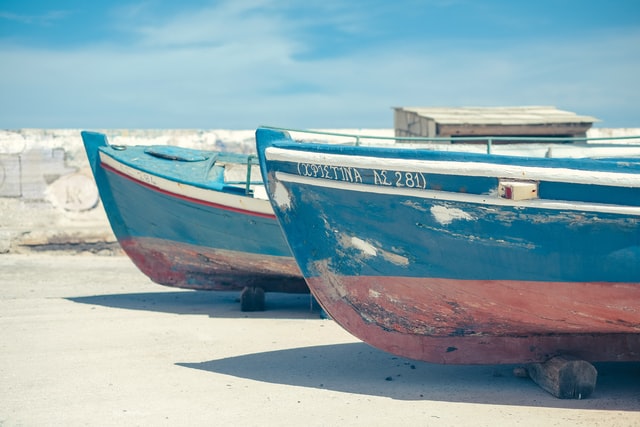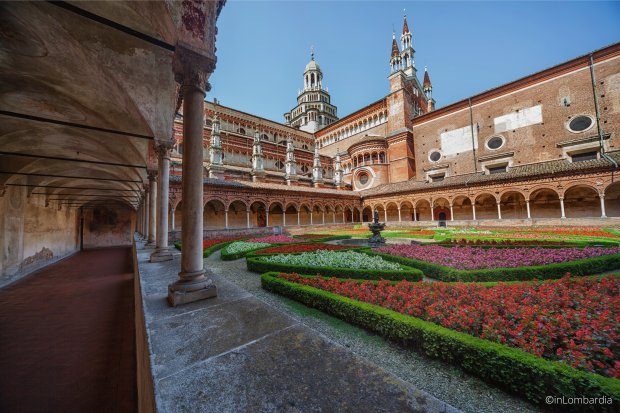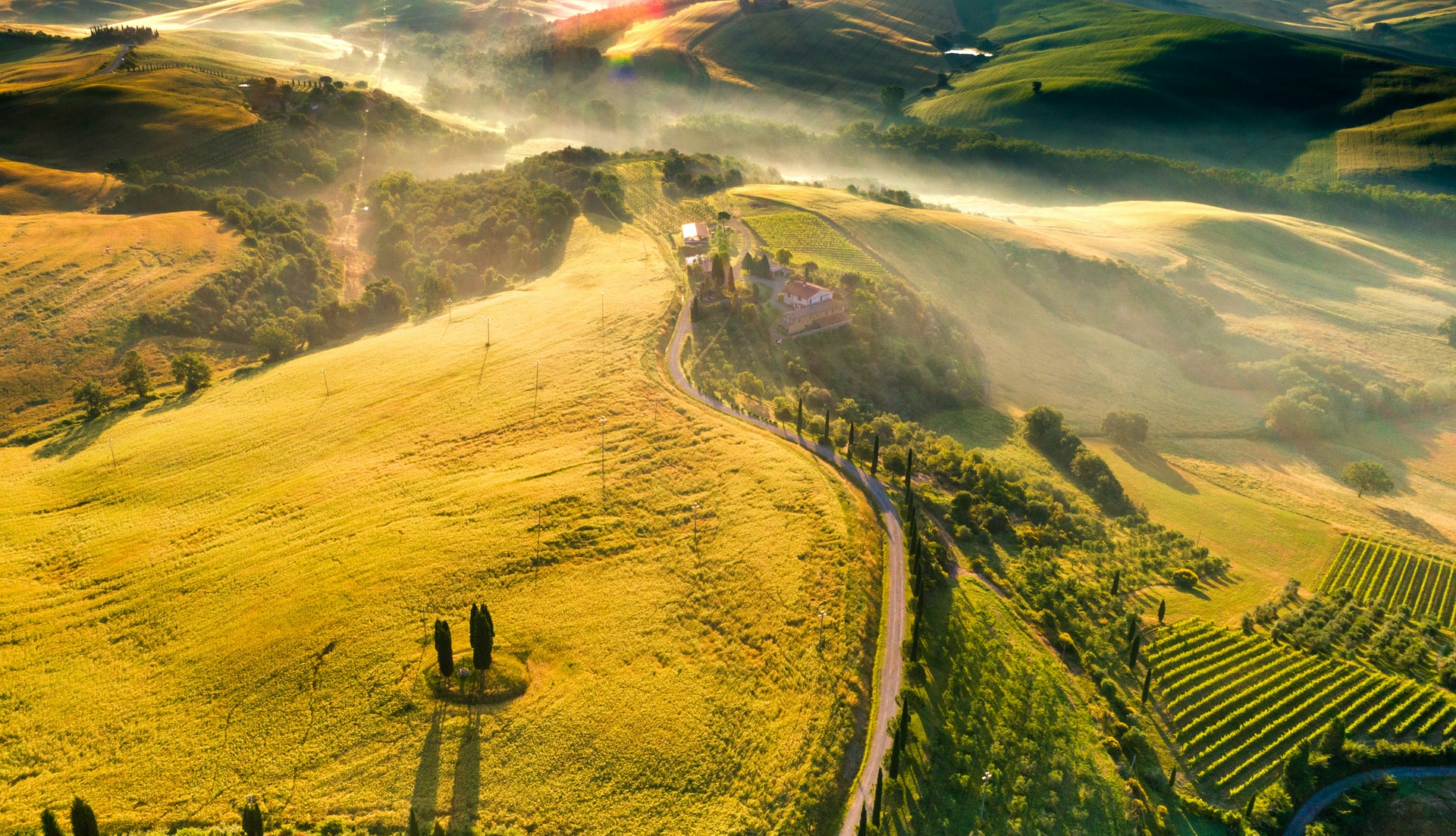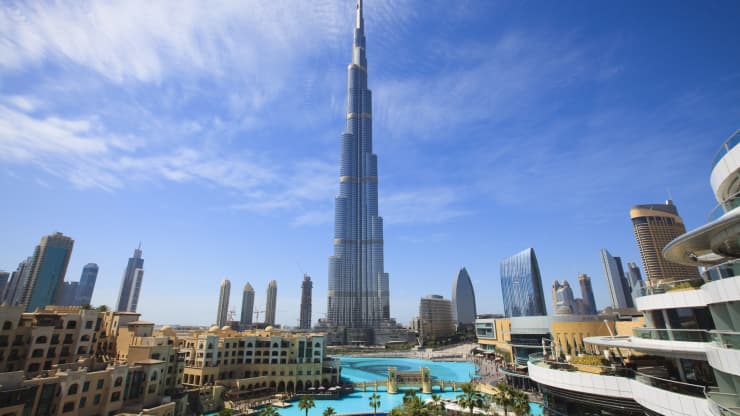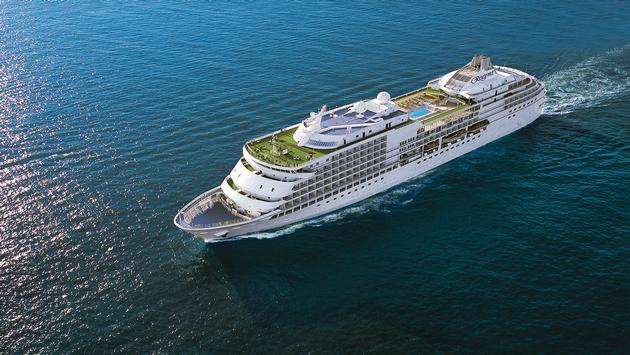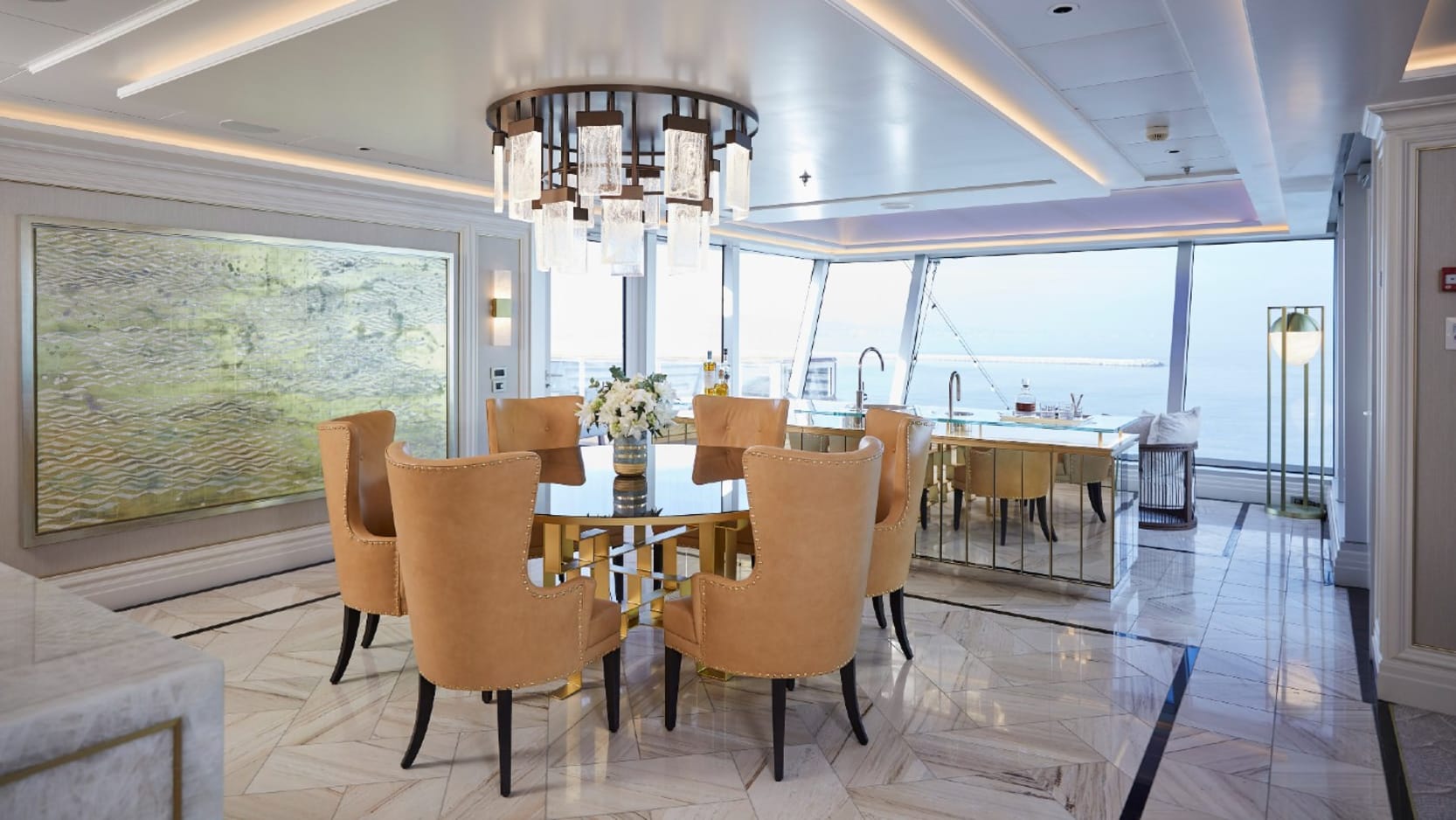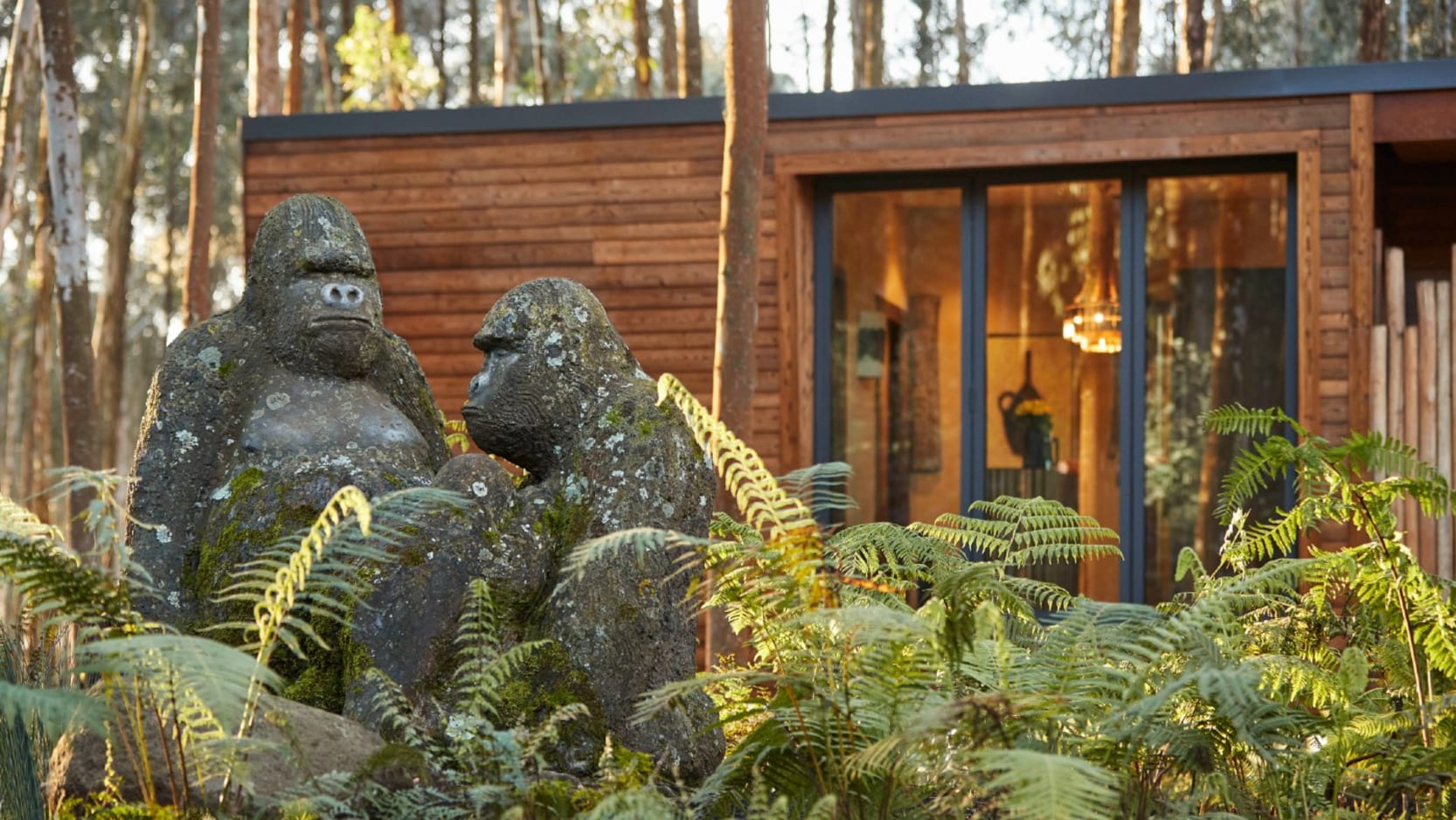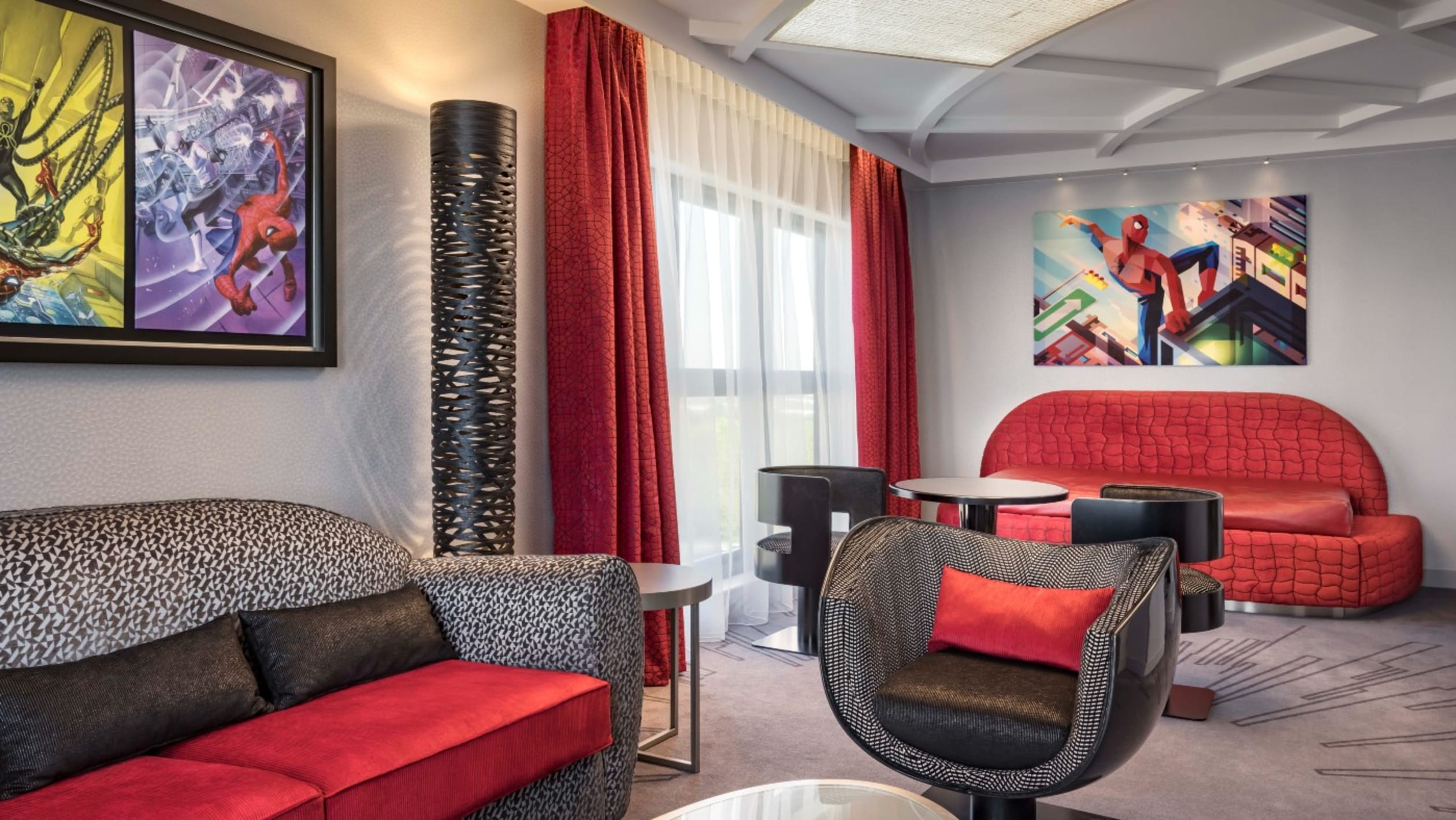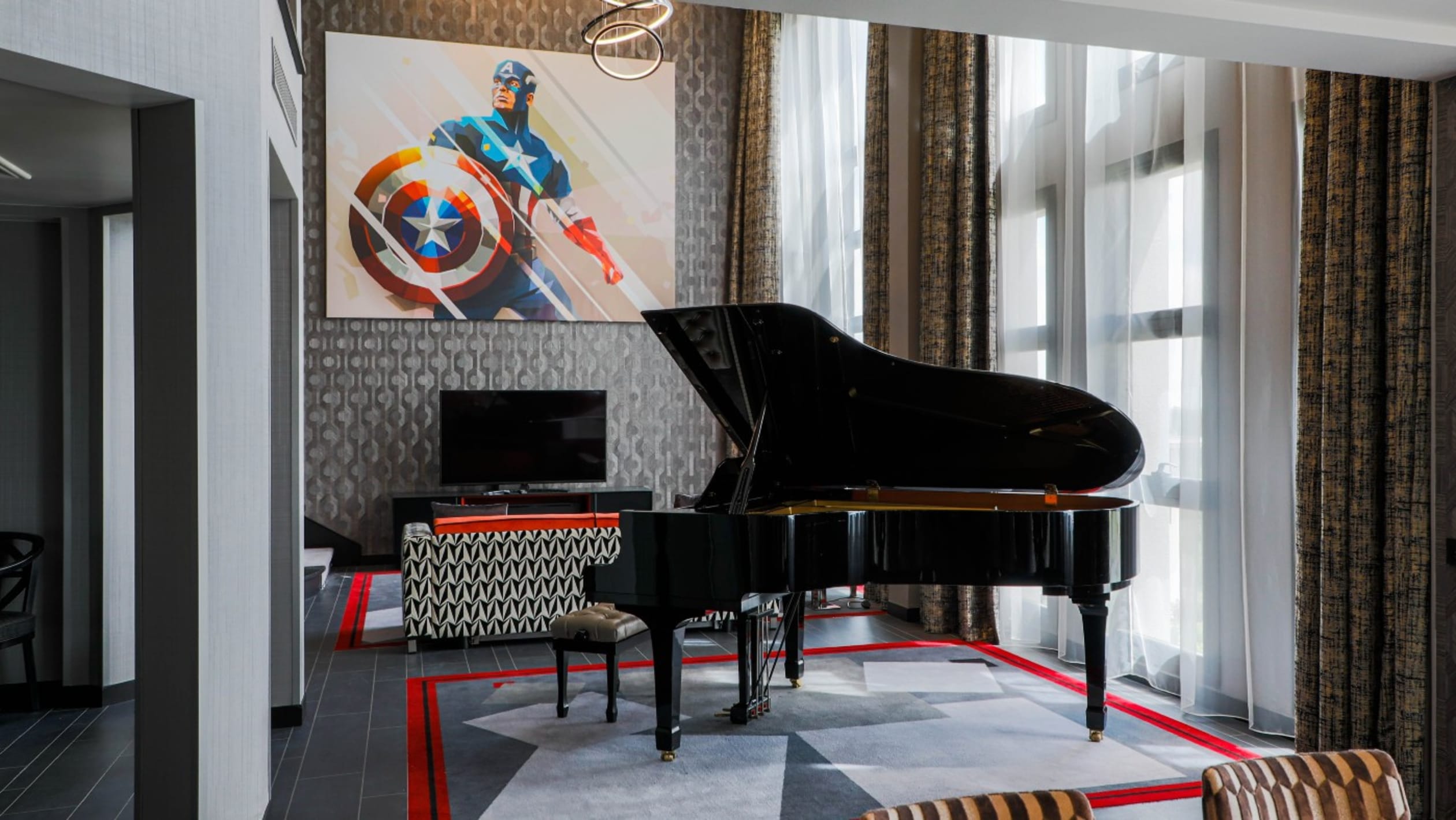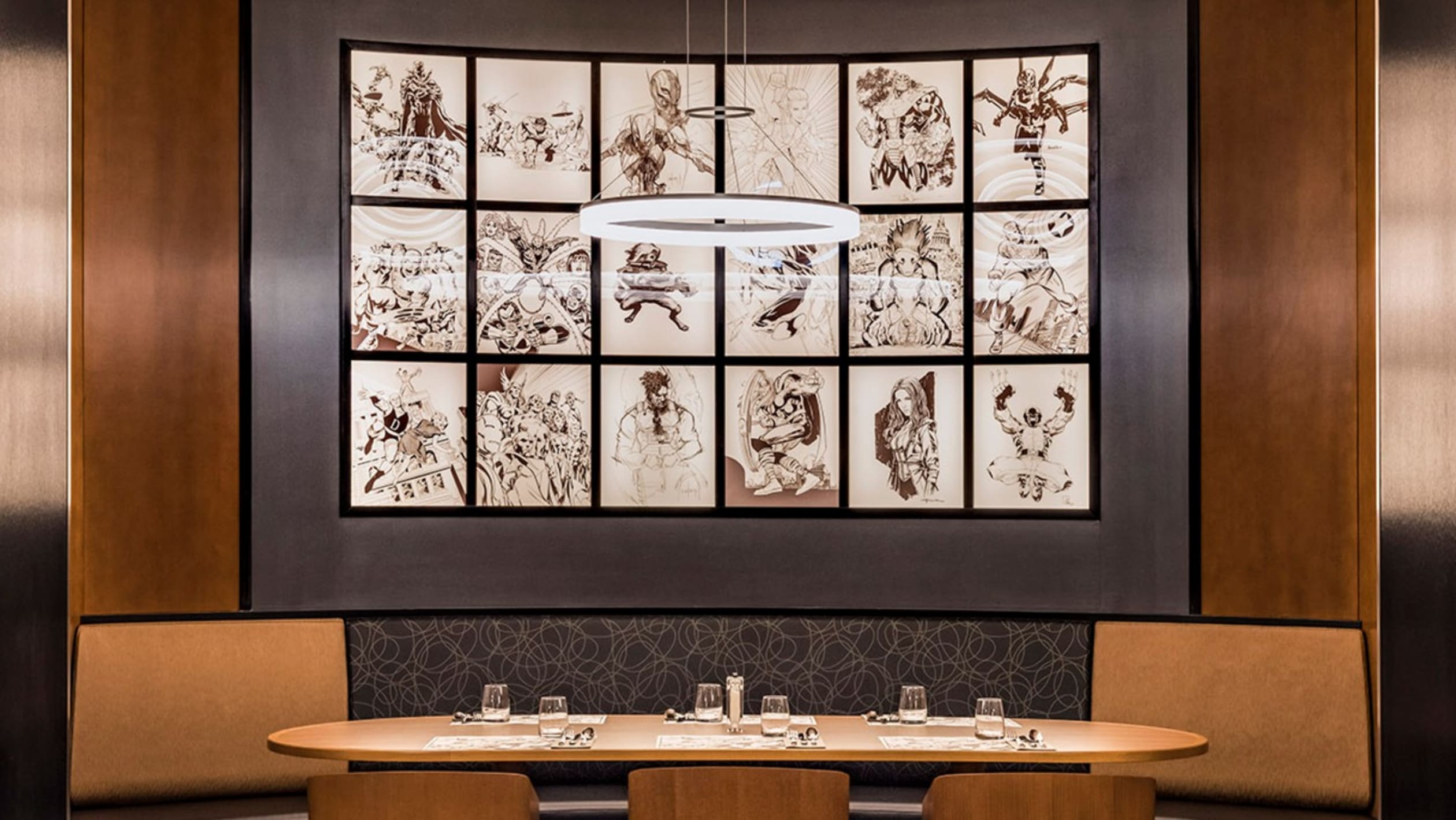What it’s like cruising the Greek Isles right now
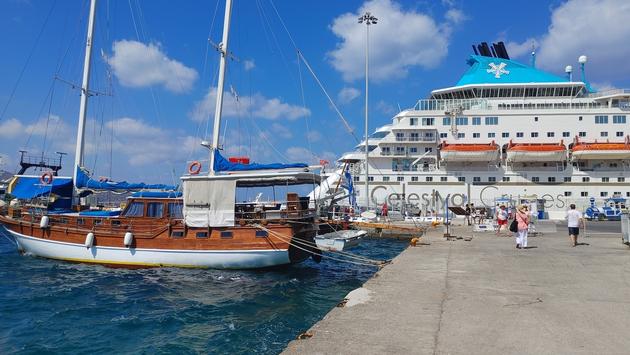
I’m a worrier by nature, so although I was very much looking forward to a Greek Isles sailing aboard Celestyal Cruises’ Celestyal Crystal, I was nonetheless anxious about fulfilling the requirements for entry into Greece and the cruise itself.
For me, what was most anxiety-provoking was the fear of the unknown. Although I’ve traveled to Europe countless times, I had yet to do so in the wake of the pandemic.
There was arguably a lot to check off the list of requirements before my July 1 departure from JFK to Greece.
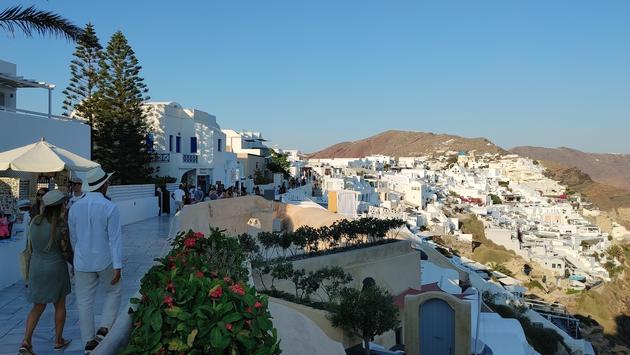
To enter the country, U.S. travelers are required to present one of the following: a vaccination certificate, a negative PCR test performed within 72 hours before travel or a negative RAPID antigen test performed within 48 hours before travel.
Travelers are also required to submit an online passenger locator form to enter Greece along with a hard copy of the be presented when checking in at departure airport.
Upon arrival at the Athens International Airport, they must check their mobile phones for an email with a QR code to be scanned to enter the country.
For the cruise, Celestyal requires a PCR test taken not more than 72 hours prior to departure, and a printout of a public health questionnaire and passenger locator form to be filled out no sooner than 24 hours prior to embarkation.
Beyond fulfilling the pre-trip travel requirements, I also worried that the travel experience would be dampened by COVID-related protocols on land and at sea.
Those concerns were quickly dispelled.
Although Celestyal requires guests to wear masks in all indoor public areas except when eating or drinking, I found I didn’t mind at all.
It felt liberating to be among fellow travelers again. I even found myself forgetting to put my mask on and having to go back to my stateroom to retrieve it.
I also felt that the staff and crew aboard Celestyal Crystal were doing everything in their power to keep guests not only safe but happy as well.
The ship, which carries 1,200 passengers, sailed at approximately 60 percent occupancy, which, for me, was another plus.
Similarly, the destinations we called at were considerably less crowded than during peak seasons prior to the pandemic.
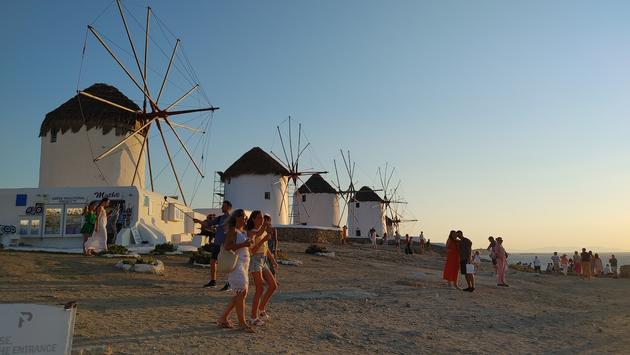
In the past, I’ve visited such destinations as Santorini and Mykonos where travelers were elbow-to-elbow in the streets.
Yes, there were a fair number of tourists on the islands, but their numbers were not near what they were before the pandemic.
Better still, the trip made me feel as though I had transcended the pandemic.
As a case in point, while sitting on a spectacular stretch beach on the island of Marathi east of Patmos, one of my fellow travelers noted that not one person in our group had mentioned the pandemic.
And that’s because we simply weren’t thinking about it – which was a true gift.
Discover Pavia in the Lombardy Region
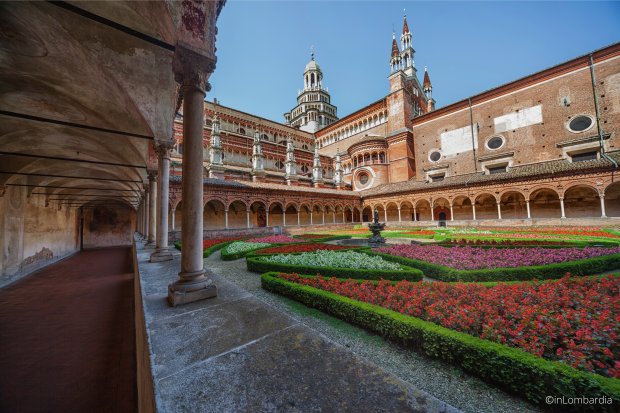
From the courtyard of its University have passed great minds like Ugo Foscolo and Alessandro Volta. On the roads of Oltrepò, Albert Einstein. Pavia is wisdom, pride, and tradition.
Memory and tradition enrich without impeding. Big thinkers and innovative ideas roam here between the loggia and the Cortile delle Magnolie within the University founded in 1361 by Emperor Carlo IV. Among the oldest in Italy, science, history, and the avant-garde find space to breathe here, from the University Library to the History Museum and the Botanical Garden, with its gorgeous greenhouse.
Pass through the city to explore the museums inside the Visconti Castle or the Ponte della Libertà, to be admired by night when the arches are illuminated by the artist Marco Lodola. The Gothic tomb from the 14th century, where Sant’Agostino rests, is conserved in San Pietro in Ciel d’Oro. Meanwhile, Barbarossa was coronated within the incredible Basilica of San Michele Maggiore. An “underground” resonance chamber awaits in the 18th century Teatro Fraschini, dedicated to the legendary Verdian tenor.
By bike, cross the Ponte Coperto that connects the historic city center to Borgo Ticino along the banks of the Ticino River. Pedaling towards the hills that cultivate some of the finest wines in Oltrepò Pavese or a late-gothic, goosebump inducing Certosa.
For more info: https://www.in-lombardia.it/en/tourism-in-lombardy/tourism-pavia
Czinger hypercar is reshaping the future of automotive manufacturing

The Czinger 21C hypercar is designed, manufactured, and assembled in Los Angeles, California using the world’s most advanced production technologies.
It’s been more than a hundred years since Henry Ford ushered in a new era of automobile production with the introduction of the world’s first moving assembly line. Since then, exponential advancements in technology have led to major breakthroughs in both automotive manufacturing and performance. While major manufacturers continuously jockey for the lead in cutting-edge advancements, there is perhaps no better harbinger of the future of automotive engineering than the new model 21C from US-based automaker Czinger.

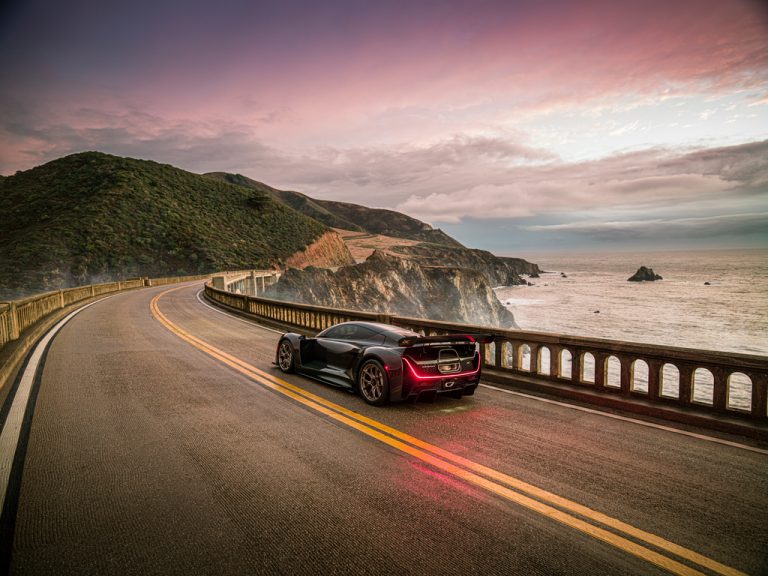
At first glance, the 21C may appear as just another Bugatti competitor trying to find a place in what is quickly becoming a crowded hypercar marketplace. The vehicle bears more resemblance to a prototype racer than a road-legal production car. The cylindrical wrap-around canopy and center-seat position of the inline two-passenger cabin take inspiration from a fighter jet and superbike designs to invoke a sense of emotion and provide perfect positioning for high-performance driving. But it’s what’s underneath the head-turning exterior that makes the 21C an unrivaled masterpiece of future forecasting.

To develop Czinger’s ground-breaking hypercar, company founder and CEO Kevin Czinger enlisted the help of former Mitsubishi designer Dave O’Connell and Chief Technical Officer Jon Gunner, who previously led technical efforts at Koenigsegg. Together the team at Czinger has created an impressive list of breakthroughs, including the world’s most power-dense engine with the 21C’s 2.88-liter twin-turbocharged V8. The compact, flex-fuel-compatible motor is capable of sending a whiplash-inducing 950 hp to the rear wheels at 10,500 RPMs. Further enhanced with two torque-vectoring-enabled 201 hp electric motors at the front end, the 21C’s hybrid powertrain produces an estimated max output of 1,233 bhp – and all with a better than 1:1 power-to-weight ratio. The performance metrics offer similar mind-bending figures: 0-60 mph in 1.9 seconds, the coveted quarter-mile in a staggering 8.1 seconds, and a top speed of 268 mph.

Even with impressive performance numbers like these, it’s the design and manufacturing process that truly exemplifies the trendsetting work at the Czinger factory just outside of Los Angeles, CA. The production technology, developed by Kevin Czinger’s primary business Divergent 3D, uses a top-secret additive manufacturing method that eliminates the need for traditional prototyping and tooling, saving both time and money as well as reducing waste. The patented Divergent 3D process allows for parts to be designed and assembled digitally utilizing proprietary in-house software before being “printed” in the factory.

The end result is a perfectly balanced, lightweight hypercar with breakneck performance and one of the most unique driving experiences available. Three manufacturers are rumored to have already licensed the state-of-the-art technology, while Czinger says they have no plans to compete with the larger market at scale. C21 production will be capped at 80 vehicles, with a starting price of $1.7 million and available in two limited-edition versions, road, and track.
Discover the Czinger 21C hypercar built for the 21st century.
Discover Bergamo in the Lombardy Region
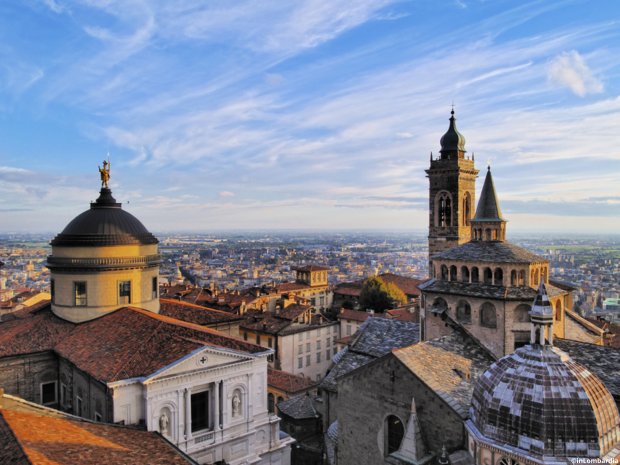
The perfect piazza, the heart of Bergamo Alta, and walls protected by UNESCO. At the foothills of the Orobie Alps, there’s more than meets the eye in this historic haven.
Through the narrow medieval alleys and up to the ancient Torre Civica, whose 100 tolls have signalled 10PM for more than 360 years over Piazza Vecchia, Palazzo della Ragione, and Palazzo Nuovo. Meanwhile, Marcello Piacentini’s 1920’s architecture shines in Città Bassa and the Modern and Contemporary Art Gallery, GAMeC, boasts pieces from the Spagani, Manzù, and Stucchi collections.
Across the street, Botticelli, Raffaello, and Tiziano adorn the walls at the Accademia Carrara within a stunning Neoclassical building. On a warm summer evening in June, mixing both past and present, the Donizetti Night brings music to the streets among the alleys, cloisters, and monuments. Celebrate the composer born in 1797 and don’t forget to pass by his birth home located outside the walls of Città Alta, which has been transformed into a house museum.
For more info: https://www.in-lombardia.it/en/tourism-in-lombardy/tourism-bergamo
Italy’s New ‘Dolce Vita’ Luxury Sleeper Trains To Elevate Rail Travel
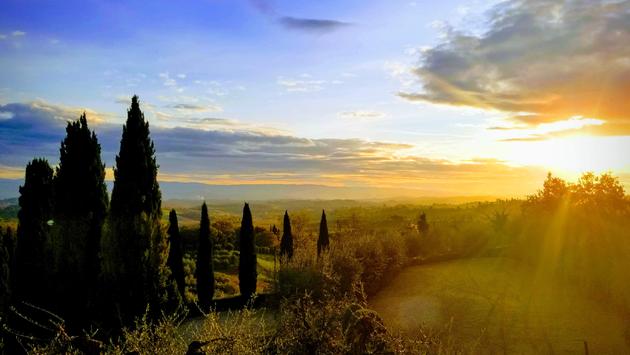
One of Europe’s most historically influential, culturally rich and visually stunning countries, Italy’s touristic appeal cannot be overstated. It’s a land filled with so many and varied visitor draws that it’s virtually impossible to plan an itinerary that includes everything you want to see.
But, you might be tempted to try, given the robustness of Italy’s railway system, which is already used by many day-trippers as an efficient and reliable means of connecting from point to point.
Now, Trenitalia (a subsidiary of the government-owned railway company Ferrovie dello Stato Italiane) has partnered with the luxury hospitality specialists at Arsenale SpA to create the forthcoming “Treno della Dolce Vita’, which will be just as much about the onboard experience as transportation.
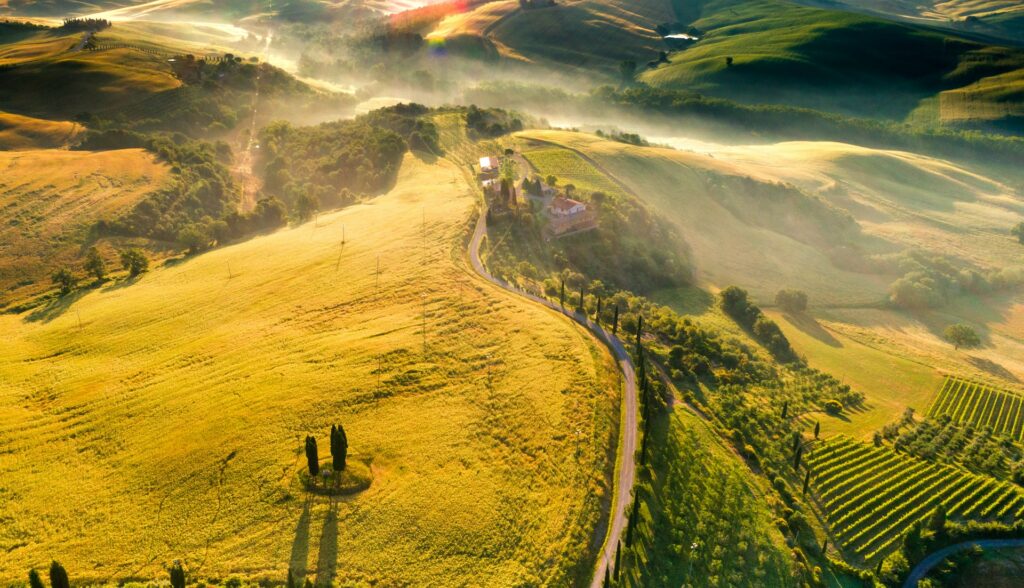
The new sleeper train will and will offer 10 different one- to three-day itineraries that travel through some of Italy’s most celebrated landscapes, covering 10,000 miles of tracks from north to south. With routes that extend into 14 of the country’s 20 regions, it will ultimately reach 128 cities.
The goal is to offer a plush, glamorous onboard experience, similar to Belmond’s iconic Venice Simplon-Orient-Express, which celebrates and recreates the bygone Golden Age of rail travel. The project aims to capture post-pandemic demand for slower travel and travelers’ desire to see lesser-visited places.
According to CNN Travel, CEO of Arsenale SpA, Paolo Barletta, said: “Tourism doesn’t just mean hotels and restaurants. Italy is a 360-degree experience and we need to start again from that experience to make a complete offering.” He also attested that the train would transport tourists to “lesser-known places” on “new itineraries”.
When the Dolce Vita Train is introduced, passengers will sleep, dine and enjoy live entertainment in historic train carriages that feature luxury, retro-style interiors invoking the feeling of ‘La Dolce Vita’ (the sweet life), an idea brought to life by Federico Fellini’s famous film of the same name from the 1960s. There’ll also be a lounge bar car and a concierge service to assist with arrangements at the destinations.
The train’s new incarnation also pays homage to the ‘60s particular upscale living aesthetic, with retro-era fittings and furnishings supplied by some of Italy’s most acclaimed designers, including Gio Ponti, Carlo Scarpa and Piero Fornasetti, and throwback artwork to match.
Each train will connect 11 carriages train that can collectively accommodate only 64 people in 32 cabins—12 deluxe cabins and 20 suites.
While the Dolce Vita Train isn’t scheduled to launch until 2023, the project’s announcement was accompanied by a trial journey that ran from Rome to Civitavecchia, catered by celebrity chef Carlo Cracco, aboard a vintage train that was outfitted just for the occasion.
Porsche to create hypercar company with Bugatti and Croatian electric vehicle maker Rimac

Porsche and Croatian electric performance car manufacturer Rimac have agreed to create a joint venture that incorporates Volkswagen’s high-performance Bugatti brand, officials announced Monday.
The new joint venture — called Bugatti-Rimac — is expected to be established as a hypercar manufacturer (think high-end sport car or supercar but better performance and more exclusive) in the fourth quarter of this year.
Rimac will have a 55% stake in the joint venture, while Porsche will hold a 45% stake in the company. Bugatti’s shares will be transferred from Volkswagen, which owns Porsche and Bugatti, to Porsche and then to Rimac, the companies said. Porsche also currently holds a 24% stake in Rimac, up from an initial 10% ownership in 2018.
The first vehicles planned from the tie-up are an eight-cylinder, 1,500-horsepower Bugatti called the Chiron and a $2.4 million all-electric hypercar called the Rimac Nevera, which the company says has about 1,900 horsepower and can exceed 250 mph. The vehicles had previously been announced separately by the companies.

“We are combining Bugatti’s strong expertise in the hypercar business with Rimac’s tremendous innovative strength in the highly promising field of electric mobility,” said Porsche CEO Oliver Blume, in a statement.
Blume, during a call with media on Monday, called the new joint venture a “perfect combination.”
Blume and Porsche CFO Lutz Meschke will become members of the board at Bugatti-Rimac. Rimac founder Mate Rimac will lead the joint venture as CEO, the companies said.
In a statement, Mate Rimac, who founded the company in his garage in 2009, called the joint venture an “exciting moment” and the combination of the companies “a perfect match for each other.”
“I think we can do incredible things,” he told reporters Monday. “It’s an immense opportunity.”
The companies did not disclose financial terms of the new joint venture.
Bugatti-Rimac is expected to have about 430 employees. That includes 300 at the company headquarters in Croatia, where Rimac is based, and 130 at the Bugatti factory in Molsheim, France. The companies said all Bugatti models will still be produced at the famed facility.
Porsche and Croatian electric performance car manufacturer Rimac have agreed to create a joint venture that incorporates Volkswagen’s high-performance Bugatti brand, officials announced Monday.
The new joint venture — called Bugatti-Rimac — is expected to be established as a hypercar manufacturer (think high-end sport car or supercar but better performance and more exclusive) in the fourth quarter of this year.
Rimac will have a 55% stake in the joint venture, while Porsche will hold a 45% stake in the company. Bugatti’s shares will be transferred from Volkswagen, which owns Porsche and Bugatti, to Porsche and then to Rimac, the companies said. Porsche also currently holds a 24% stake in Rimac, up from an initial 10% ownership in 2018.
The first vehicles planned from the tie-up are an eight-cylinder, 1,500-horsepower Bugatti called the Chiron and a $2.4 million all-electric hypercar called the Rimac Nevera, which the company says has about 1,900 horsepower and can exceed 250 mph. The vehicles had previously been announced separately by the companies.

By Michael Wayland www.cnbc.com
Most-searched ‘bucket list’ travel experiences in the world
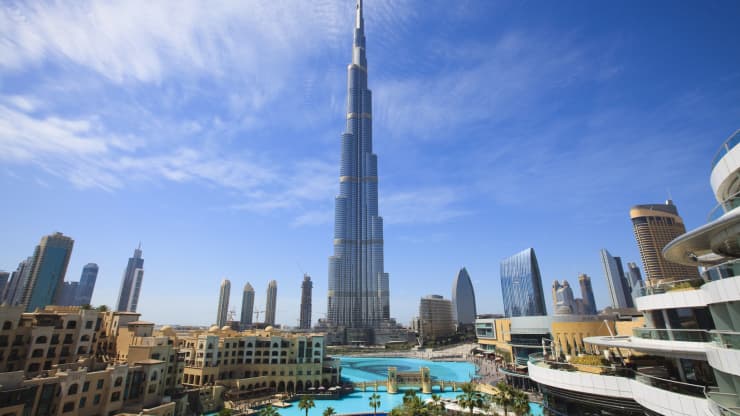
People may not have traveled much during the past year, but that didn’t stop them from searching for ideas online.
Luxury travel operator Unforgettable Travel wanted to know which travel experiences people searched the most during the past year. With the help of digital marketing agency SEO Travel, the company compiled a list of 135 of the world’s most popular “bucket list” destinations and used software to determine how many people were making plans to visit each site.
According to the research, which analyzed searches from May 2020 to May 2021, the world’s tallest building, the Burj Khalifa, was the most-searched travel experience, a result that surprised the team at Unforgettable Travel.
“There were a few experiences in the top 10 alone that we thought would feature lower down despite being great experiences … this includes the No. 1 Burj Khalifa in Dubai,” said Luke Harvey, a marketing manager at the company. “But the fact Dubai has remained open to visitors for the vast majority of time during the pandemic will have aided its position.”
That wasn’t the only surprise to the team.
“Trekking to Mount Everest base camp is definitely a once-in-a-lifetime experience, yet not something we thought would beat the likes of the Rome Colosseum,” he said.

Mount Everest’s place on the list may reflect growing preferences for outdoor travel activities. Six hikes appeared in the top 50 list, including Mount Everest, Tanzania’s Mount Kilimanjaro, Arizona’s Havasu Falls, Norway’s Trolltunga, South Africa’s Table Mountain and Peru’s Inca Trail to Machu Picchu.
Continent lists show the travel experiences and sites garnering the most online interest in specific parts of the world.
Africa
History, wildlife and natural wonders top Africa’s most-searched sites, including some that were tied in terms of global search activity.
1. Cruising down the Nile
2. Climbing Mount Kilimanjaro
2. Hiking to the top of Cape Town’s Table Mountain
4. Seeing Chefchaouen, the “Blue City” of Morocco
5. Hiking Mount Kenya
6. Bungee jumping off Victoria Falls Bridge
6. Trekking to see gorillas in Uganda
8. Seeing the Sahara desert
9. Going on safari in the Ngorongoro Crater
9. Visiting the medina (old city) of Marrakesh
“These are all great activities in some of Africa’s top destinations,” said Kent Redding, president and co-founder of luxury safari company, Africa Adventure Consultants.
He told CNBC that while those locations are open, travelers should expect some restrictions due to the pandemic. For example, visitors must stay 10 meters away from the gorillas in Uganda, and the cable car at Table Mountain is closed until at least July 11, he said.
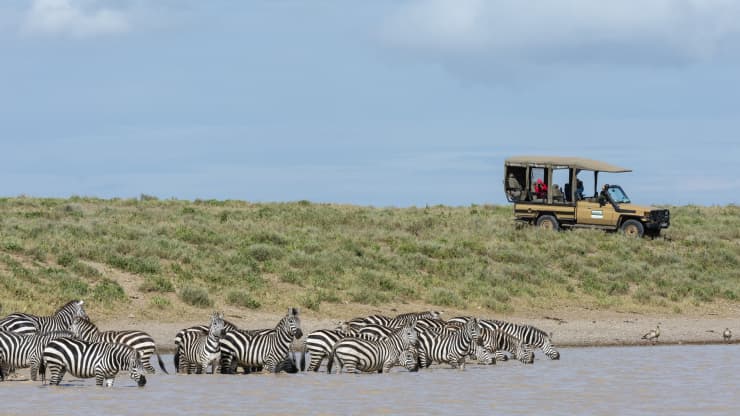
The 2022 travel season is filling fast because of postponements from this year and “a ton of new bookings” for next year, Redding said. That means opportunities abound for travelers willing to travel this year, he said.
“While travelers are facing some hurdles traveling now — including canceled flights, sporadic lockdowns, and lots of Covid testing — those who can roll with the punches are enjoying incredible experiences,” said Redding. “They are visiting some of Africa’s most popular parks and seeing amazing wildlife … with nobody else around.”
Antarctica
The White Continent registers just one experience on the list — simply stepping foot onto it.
“Antarctica has always held a unique appeal,” said Patrick Woodhead, managing director at White Desert, a luxury tour operator that organizes expeditions to the continent’s interior. “Clients are drawn to the continent because it still represents a sense of discovery in travel that has been lost in so many other places on earth.”
 Woodhead said the 2021-2022 travel season will be the company’s busiest season yet.
Woodhead said the 2021-2022 travel season will be the company’s busiest season yet.
“With so much pent-up demand for so long, clients aren’t waiting to experience a lifelong dream,” he told CNBC.
Asia
Despite most of Asia being closed to tourism in the past year, people still searched for information on these experiences:
1. Visiting the Burj Khalifa in Dubai
2. Hiking to the Mount Everest base camp in Nepal
3. Touring the Taj Mahal
4. Traveling to Japan during cherry blossom season
5. Seeing China’s Forbidden City
6. Diving at Indonesia’s Raja Ampat islands
7. Watching the sunrise at Angkor Wat
8. Swimming in the Dead Sea
9. Touring the Petronas Towers in Kuala Lumpur
10. Seeing the sunrise at the temple of Borobudur
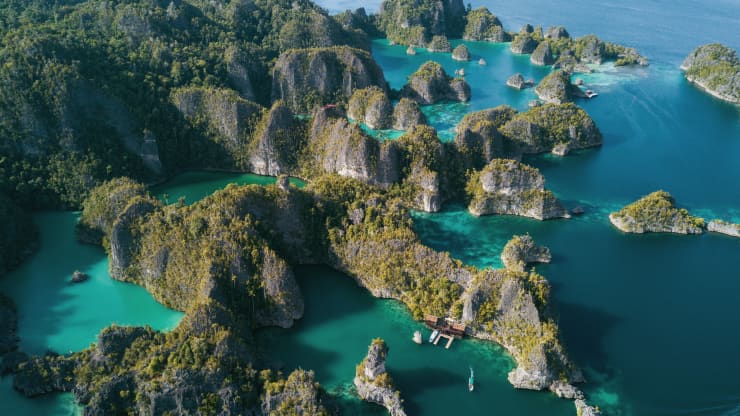
The list includes feats of architecture both modern — Burj Khalifa, Petronas Towers — and historical — the temples of Angkor Wat and Borobudur as well as China’s Forbidden City.
Nature’s extremes are also highlighted; the world’s tallest mountain — Mount Everest — and the lowest place on Earth — the Dead Sea between Israel and Jordan — are on the list.
Europe
The top three searched spots in Europe are hardly a surprise, and the rest of the list is an eclectic mix of architecture, nature, exercise and entertainment.
1. Going to the top of the Eiffel Tower in Paris
2. Touring the Louvre in Paris
2. Exploring Rome’s Colosseum
4. Going to the Glastonbury Festival
5. Partying in Ibiza
6. Riding the Orient Express
7. Seeing La Sagrada Familia in Barcelona
8. Visiting Buckingham Palace in London
9. Cruising the Norwegian fjords
10. Running the London Marathon
Europe had the most spots on the longer list, taking 19 out of 50 spots. Italy secured an additional four with Pompeii, Cinque Terre, the Sistine Chapel and the canals of Venice.
Two experiences in Iceland — seeing the Northern Lights and swimming in the warm waters of the Blue Lagoon — also made the cut as did touring Neuschwanstein Castle in Germany and Stonehenge in the United Kingdom.
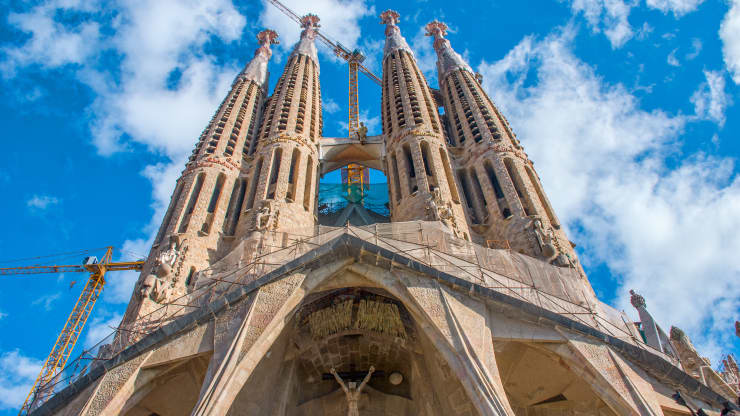
Europe has opened to some international travelers again, but tourists should note that not all of those experiences are operating yet.
North America
Four big-city travel experiences in North America made the global top 10 list. The rest focused on more rural parts of the continent.
1. Visiting the Statue of Liberty
2. Seeing the Las Vegas Strip
2. Crossing the Golden Gate Bridge
4. Going to the top of the Empire State Building
5. Taking a helicopter tour over the Grand Canyon
6. Road-tripping down Route 66
7. Attending Coachella
7. Seeing Niagara Falls at the U.S.-Canada border
9. Camping in Canada’s Banff National Park
10. Seeing Mount Rushmore
“This is a great list, and I think it hits a lot of the best U.S. locations and experiences,” said Ruzwana Bashir, CEO of Peek, a booking website for travel experiences.
She said one way to make “bucket list” travels special is to see them in interesting ways. From this list, she recommends taking an underground tour of the Grand Canyon, zip lining in the Mojave desert outside of Las Vegas and taking a seaplane over the Golden Gate Bridge.
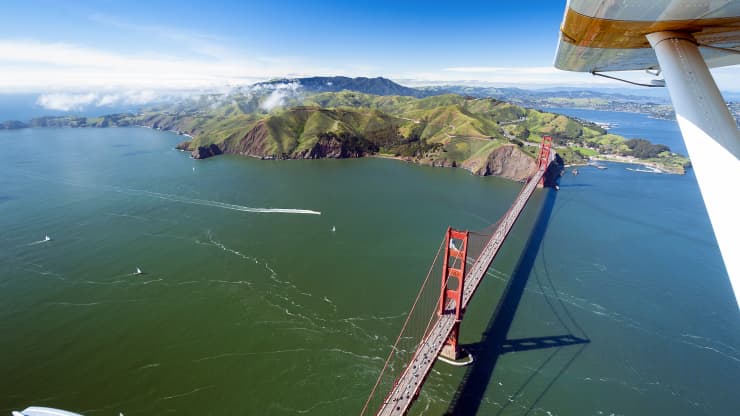
“On Route 66, I’d recommend stopping at Peach Springs for a tour of the stunning caverns, taking a detour around Santa Fe to go rafting on the Rio Grande and enjoying a local handcrafted cocktail at a beautiful distillery in Galena, Kansas,” Bashir said.
She added that other must-see experiences in North America are taking a hot air balloon ride over Napa Valley, visiting Yosemite National Park and doing waterfall yoga in the Smoky Mountains of North Carolina.
Oceania
After Antarctica, the least populous continent in the world is Oceania, which comprises Australia, Papua New Guinea, New Zealand and many smaller islands, such as Fiji, Guam and French Polynesia.
Unsurprisingly, all but one of its most-searched travel activities involve the outdoors.
1. Snorkeling in the Great Barrier Reef
2. Watching a show at the Sydney Opera House
3. Seeing New Zealand’s Hobbiton
4. Visiting the monolith of Uluru, or Ayers Rock
5. Staying in an overwater bungalow in Bora Bora
6. Touring New Zealand’s Waitomo Glowworm Caves
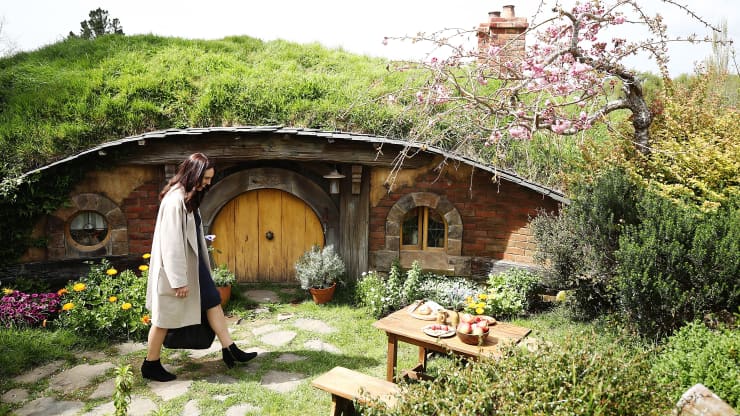
The newest of these experiences is the Hobbiton Movie Set in Matamata on New Zealand’s North Island. Tolkien enthusiasts can book a guided walking tour of the 12-acre movie set used in both “The Lord of the Rings” and “The Hobbit” trilogies.
South America
Online interest is focused on outdoor activities in South America, too.
1. Hiking to Macchu Picchu
2. Seeing the wildlife of the Galapagos Islands
2. Experiencing the biodiversity of Costa Rica
4. Walking on Bolivia’s Salar de Uyuni (salt flats)
4. Visiting the Iguazu Falls where Argentina, Brazil and Paraguay meet
4. Seeing the Moai statues of Easter Island
7. Visiting San Pedro de Atacama desert
8. Exploring Patagonia
9. Sandboarding in Huacachina in Peru
10. Seeing the Amazon rainforest
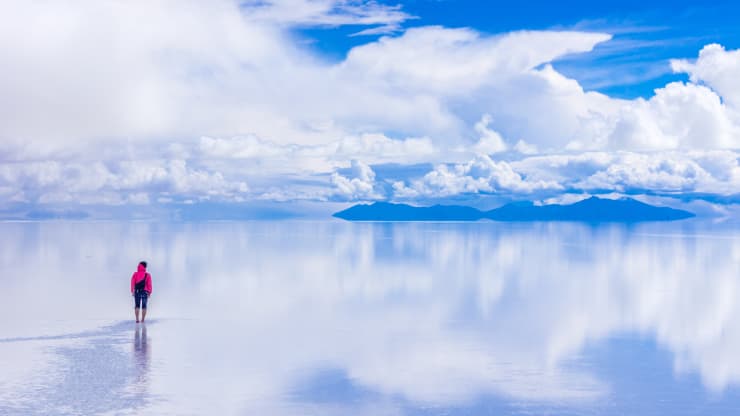
Peru’s most famous tourist destination, Macchu Picchu, topped the list. It was also one of four of the “New Seven Wonders of the World” to appear in the 50 most-searched travel experiences list.
“The main surprise was that some of the ‘Seven Wonders of the World’ didn’t make the top 50, including the Great Wall of China, Petra in Jordan and Christ the Redeemer in Brazil,” said Unforgettable Travel’s Harvey.
In the end, he chalked it up to the sheer size of the competition.
“There are so many amazing things to see and do in our world,” he said.
By Monica Buchanan Pitrelli www.cnbc.com
Dream destinations: The Regent Suite on the Seven Seas Splendor
The Regent Suite on the Seven Seas Splendor
In 2022 experience the most luxurious residence at sea: the Regent Suite which is perched on the 14th deck of the Seven Seas Splendor. With a total 4,443 sq ft of space, it is the largest suite ever constructed on a luxury cruise ship, complete with a spa featuring a personal sauna, steam room and treatment area and unlimited treatments.
Guests in the Regent Suite will also enjoy first-class domestic air flights, a dedicated personal butler, a personal car with driver and guide in every port, and the exquisite comfort of a hand-crafted $200,000 (£144,833) Vividus bed from the renowned Hästens brand. A custom-made Treesse mini pool spa is situated on the front balcony allowing guests to soak and relax as they take in incredible views – from the glow of dawn to the setting sun – all whilst sipping a glass of Veuve Clicquot.
Travel onboard the Seven Seas Splendor and stay in the Regent Suite for the seven-night The Fine Art of Europe voyage which departs on 19 August 2022. Fares from £27,999 per person based on double occupancy of the Regent Suite.
Great reasons to visit Abersoch in North Wales
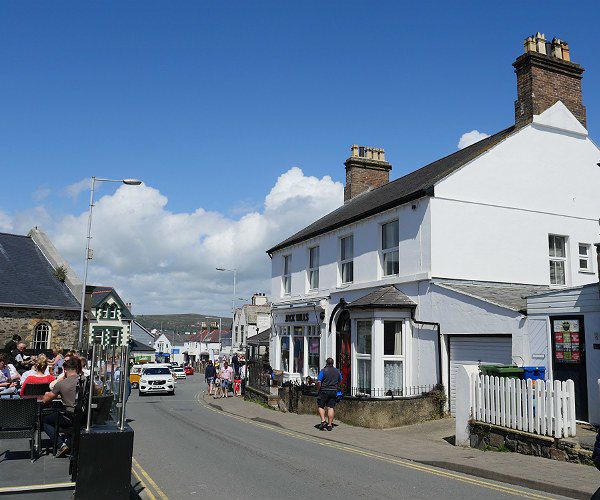
I recently had the good fortune of visiting Abersoch for a few days. I’d frequently been to nearby Pwllheli for various sailing events (Plas Heli, the Welsh National Sailing Academy and Events Centre, is there) but never knowingly made it as far as Abersoch, despite hearing a number of great things about the town. Known as Cheshire-by-the-Sea given its popularity with residents of the nearby English county of Cheshire, many of whom have second homes in the area, Abersoch is a town on the southern side of the Llyn Peninsula in the Welsh county of Gwynedd. Also affectionately known as the Welsh Riviera thanks to its unique micro-climate, it is also a place where you can enjoy plenty of Summer sun, sea, sand and a lively nightlife. Here are 8 reasons why you, too, should consider Abersoch on your next trip to Wales.
Beaches

There are many beaches within easy reach of Abersoch. Porth Niegwl is the longest expanse – a 3-mile wide bay on the south coast of the Llŷn Peninsula, but closer to Abersoch itself is the highly desirable Porth Mawr, a much closer walk from the town centre. This is also home to Wales’ most expensive real estate – a beach hut here can set you back in excess of £150,000. From here you can enjoy views out to two islands – St. Tudwals West (home of TV adventurer Bear Grylls) and Ynys Tudwal Fach. Interesting aside, but Grylls once got in a little bother with the council for a large metal slide that went straight into the sea from his property, for which he hadn’t got permission from the relevant Welsh building authorities – in hindsight, it wasn’t such a good idea for him to share this fact with his thousands of Twitter followers given that it was installed within an officially designated Area of Outstanding Natural Beauty (AONB)! The slide has since been taken down.
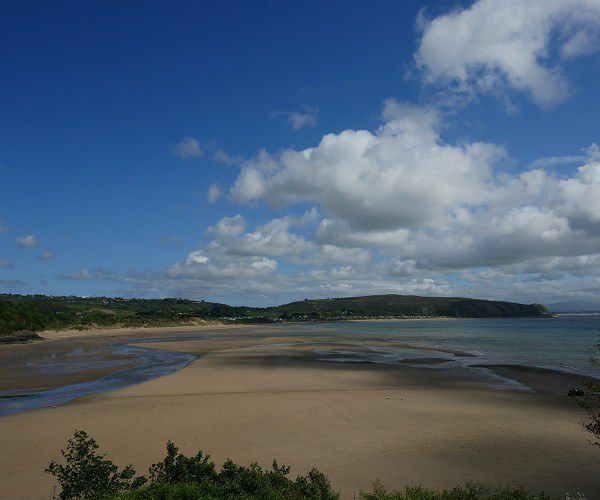
To the south of Abersoch is the National Trust’s Porth Ceiriad and, to the north, the harbour beach where there is another beautiful expanse of sand and yet hardly a soul in sight.
Views
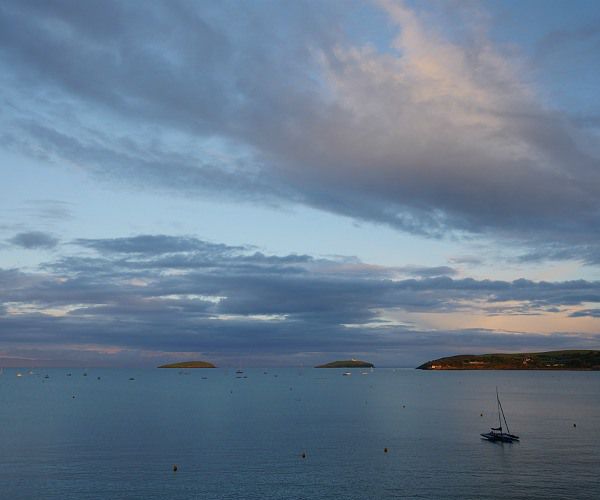
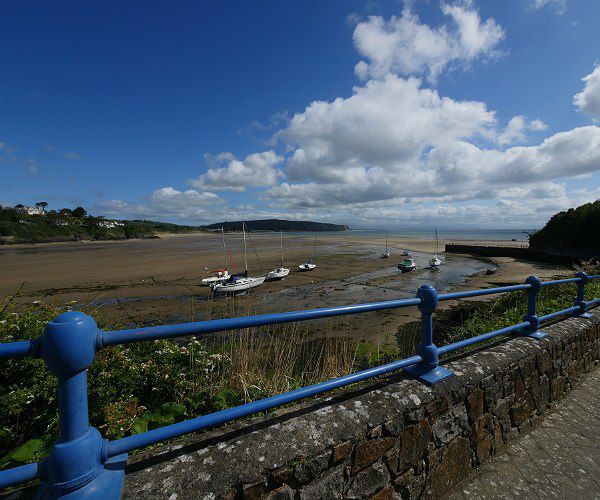
Abersoch is very picturesque and, catch the light at the right time of day, and you will be in for a treat. On one occasion, we captured a beautiful rainbow finishing at St. Tudwals West (the island on the right in the picture below), but sadly I only had my phone to hand and the resulting picture is a little too grainy to publish here!
Food
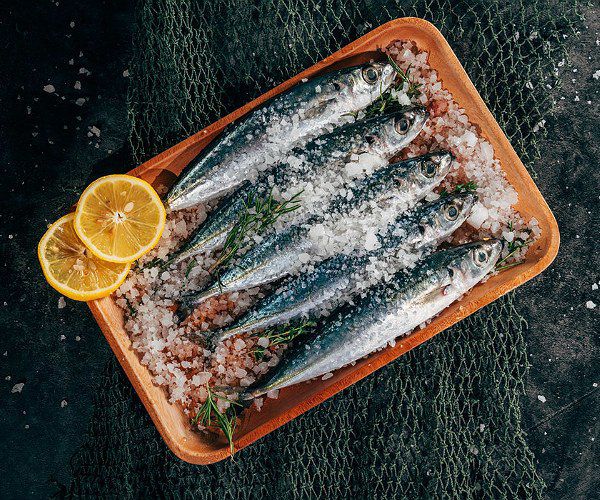
There are many different places to eat in Abersoch – places such as The Hub, The Dining Room, Fresh Café Bar & Grill, Venetia, The Cove and the restaurant at Porth Tocyn Hotel are all well worth a visit.

If the weather’s favourable, though, and particularly if you have access to a beach hut, you might like to consider a barbecue on Abersoch’s main beach which is relatively sheltered. Mickey’s Boatyard & Beach Cafe, at the south end of the beach, also does barbecues from time to time, or is a nice place just to relax and take in the view with a coffee or light lunch after walking the length of the beach.
Watersports
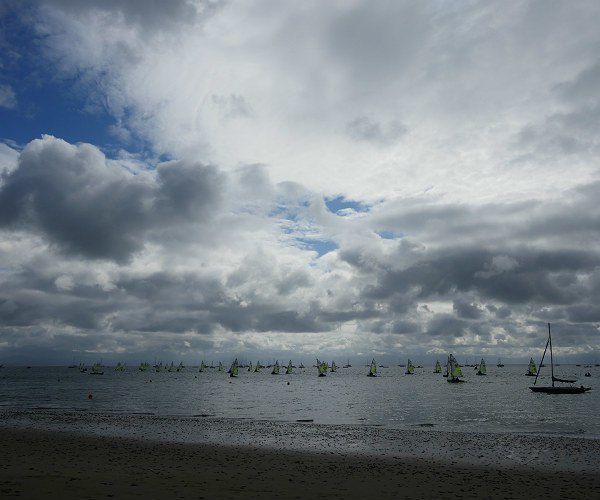
Watersports enthusiasts will love Abersoch with its internationally-recognised sailing waters. There are two clubs to know about. Firstly, Abersoch Sailing Club which is an RYA-affiliated club run from the main beach, and great for both new and experienced dinghy sailors. Secondly, perched high on the cliff at the northern end of the beach, is South Caernarvonshire Yacht Club, which has hosted many prestigious events in the surrounding waters of Cardigan Bay.

Our boys were there to compete in the RS Feva national championships and had an amazing time!
Golf

Aberosch has had its own golf club for over 100 years; Abersoch Golf Club is an 18-hole course located behind a series of ancient sand dunes and with a mixture of both links and parkland. There are some testing holes but, whatever your score, you will hopefully be rewarded with views across Cardigan Bay and out towards Snowdonia.
Nearby Pwllheli also has Pwllheli Golf Club on the south-facing coastline of Cardigan Bay, and Llŷn Golf, a 9-hole pay and play golf course and driving range. And a little further afield is Nefyn & District Golf Club on the north side of the Llŷn Peninsula, which has both 9- and 18-hole courses.
Walking

If you enjoy walking, you will find plenty of walks nearby. The beaches are largely dog friendly but do check the signs are some areas do not allow dogs at certain times of year (for example, just the final northernmost stretch of Porth Mawr does not allow dogs during the main season).

Those looking to walk a little further may want to head for the Wales Coast Path which circumnavigates the Llyn Peninsula. You can walk the entire path or just pick up shorter routes at various points and marvel at some stunning stretches of the Welsh coastline.
Alternatively, if you want to tackle Snowdon, drive to Beddgelert and take the road to either Rhyd-Ddu or Nant Gwynant for two possible ascents of Wales’ highest peak.
Cycling

Both road cyclists and mountain bikers will find plenty of routes in and around Abersoch. There are plenty of routes to explore around the Llŷn Peninsula as well as stretches of the Wales Coastal Path that you can ride. There’s also a nice circular route at Aberdaron, 10 miles to the west of Abersoch, that takes you along the north side of the peninsula, past Porth Oer and then down towards Pen Y Groes and back. If you don’t have your own bikes with you, you can hire them at Llŷn Cycle Centre in Pwllheli.
Days out
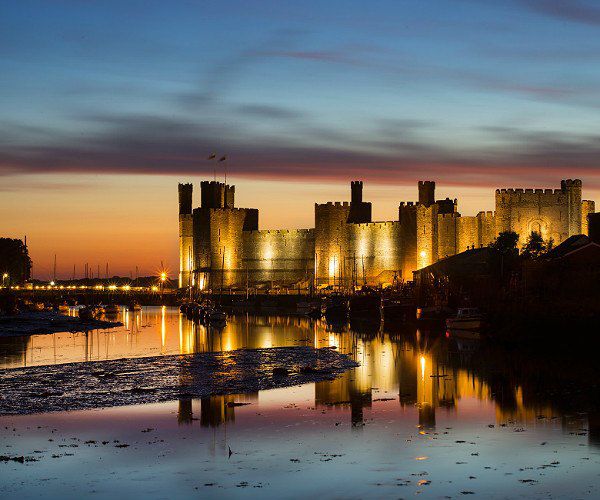
Although you could easily spend the week without even leaving Abersoch, there are plenty of places to explore nearby that can easily be done as day trips. Caernarfon is less than an hour’s drive away, for example, and home to Caernarfon Castle, a medieval fortress with impressive defences since this was once the administrative centre for the whole of North Wales.
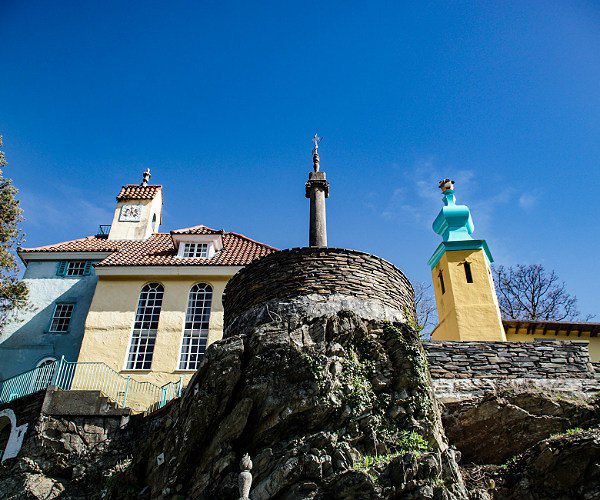
There were in fact 600 castles in Wales, with the closest to Abersoch being Criccieth. Other nearby alternatives to consider include Harlech, Beaumaris on Anglesey, Penrhyn Castle in Bangor and Dolwyddelan in Betws-y-Coed.
For something different, heading east out of Abersoch and hugging the Llŷn Peninsula’s southern coastline for about 40 minutes will take you to Portmeirion, a rather unique private tourist village created by Clough Williams-Ellis during the earlier part of the 1900s that has, on occasion, been used as a film location. It’s something of a fantasy world with beautiful buildings and grounds. The botanical gardens are worth a look and home to an important collection of rhododendrons as well as other exotic plants.
For those looking for something more active, there are also ziplines, treetop nets and even an underground trampoline experience all within an hour’s drive, and venture just a little further to Dolgarrog in the Conwy valley (about an hour and a half’s drive) and you will find an artificial surf lagoon where they create continuous and perfect waves, so there’s really something for everyone!
By Paul Johnson www.aluxurytravelblog.com
United’s latest jets will offer Bluetooth for in-flight entertainment

United Airlines is adding a long-awaited feature to the in-flight entertainment seatback screens of its new Boeing 737 Max 8 jets — support for Bluetooth headphones. The company is making the upgrade as part of “United Next”, a new plan to expand and modernize its fleet with what it says are larger, fuel-efficient jets and a more comfortable in-flight experience.
I haven’t flown in the last two years — for reasons that are hopefully obvious — but the thing that grinds most of my past flying experience to a halt is dealing with the bizarre two-pronged audio jacks airplanes use for inflight audio. Having headphones with a 3.5mm audio jack isn’t hard, but it doesn’t reflect the Bluetooth audio lifestyle, Apple, and plenty of other tech companies have slowly forced me to adopt. I don’t like the wireless audio freak I’ve become, but it happened, which makes United’s upgrades so exciting, as demoed in the tweets below from aviation writer Jason Rabinowitz.
Adding seatback screens made a huge difference in how tolerable flying is, but it’s been held up by lagging audio support that The Verge has even written a guide to getting around. And this isn’t a problem unique to United. Other airlines like Delta or JetBlue have been offering seatback screens for years, but have also saddled flyers with analog audio. United just might be one of the first airlines to start the next wave of inflight entertainment improvements (hopefully).
However, there’s room for things to go a bit sideways. As part of its upgrades, United’s new 737 Max 8 jets offer 10 or 13-inch inflight entertainment screens on the backs of all seats, which might mean a lot of people trying to connect to Bluetooth at once. That could cause interference, and might also make the process of connecting your headphones more of a chore if you’re having to hunt through multiple devices trying to pair in the same menu. United currently only offers Bluetooth on its Max 8 jets which it says should start flying this summer. The company didn’t share how it plans to address issues with Bluetooth, but said it’s still “studying the technology.”
I can’t rightfully claim that Bluetooth is as meaningful a change as more legroom or safer flights, but for an airline industry hoarding cash to make it through the pandemic and looking to entice frequent flyers to earn their miles again, any snazzy new feature can’t hurt.
By Ian Carlos Campbell www.theverge.com
Qatar Airways launches a new business class on its Boeing 787-9 Dreamliners

Qatar Airways will launch its new Boeing 787-9 Dreamliner passenger aircraft, featuring a new business class suite, on a number of key routes to Europe and Asia, starting with its Doha to Milan service on 25 June 2021.
The ultramodern aircraft is scheduled for services from Doha to Athens, Barcelona, Dammam, Karachi, Kuala Lumpur, Madrid and Milan and has a total passenger capacity of 311 seats – 30 business class Suites and 281 seats in economy class.
Qatar Airways Group Chief Executive, Akbar Al-Baker, said: “In-line with our commitment to offering our passengers an unparalleled travel experience, we are pleased to introduce this much-anticipated business class suite on Qatar Airways’ newest wide-body aircraft, the Boeing 787-9 which will debut onto a number of key routes within our network.
“The new business class suite sets yet another industry standard with a uniquely private experience for premium passengers travelling with us, which is becoming increasingly valuable during this pandemic, while showcasing Qatar Airways’ 5-star standards of excellence and Qatari hospitality that are quintessential on all of our flights.
“Our passengers deserve the best and I am confident that they will appreciate the larger Dreamliner variant for its unmatched comfort in the sky. Passengers can rest assured that its responsible impact on the environment fully aligns with our ambition to achieve the highest levels of sustainability.”
Arranged in a herringbone pattern, in a 1-2-1 configuration, each Adient Ascent business class suite has direct aisle access with a sliding door to ensure the ultimate in privacy and comfort. Passengers seated in adjoining centre suites can slide the privacy panels away at the touch of a button to create their very own enclosed private space.
The business class suite transforms into a 79-inch fully-flat bed. Personal mobile devices can be stored safely in a dedicated phone holder, equipped with a wireless charging technology compatible with both iOS and Android devices.
The suite is complemented with by the onboard service, which includes a wide selection of international cuisine, food and beverages, as well as healthy vegan meal options that are a part of Qatar Airways’ à la carte dine-on-demand menu. Products and Amenities come from Narumi, BRIC’S, diptyque, TWG Tea, Castello Monte Vibiano Vecchio and The White Company to name a few.
Economy class features Recaro seating, with each seat equipped with a 13-inch Panasonic IFE touch screen in addition to a personal electronic device holder for both mobile and iPad devices. The seat features a rotatable armrest that can be completely stowed away to the backrest, providing a more comfortable and spacious experience. Passengers can also enjoy the full dining experience ‘Quisine’.
As a warm welcome on-board the new aircraft, Qatar Airways Official Composer, Dana Al Fardan has created new boarding music portraying the mutual vision Qatar Airways and Dana share in bringing people together.
Culinary delights at Mallorca’s 9 Michelin stars
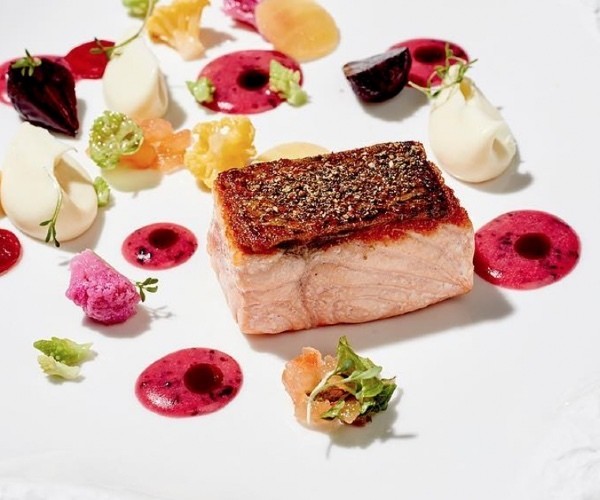
Over the last two decades Mallorca has accomplished a culinary transformation. A complete overhaul from the tourist fare of old to one of the world’s most appetising destinations and not just for its World Heritage landscapes, pristine beaches, local culture and world class luxury hotels but also for it’s outstanding food scene.
A wave has been building of Mallorquin restaurants showcasing locally-sourced ingredients of fish, lamb and pork, fruits and vegetables, nuts, oils, local wines and with the island’s rich historical food culture, it is now producing outstanding cuisine recognised by the gastronomy´bible ` the Michelin Guide.
In the annual Michelin star awards which take place each November, Mallorca was awarded 9 Michelin stars and 2 Bib Gourmand.
In recent years our appreciation of good food has experienced a sea change. We’re now immersed in tv challenges from Master chefs to best bakers and our understanding is so much better of what it takes to produce outstanding food.

We have learned to absorb international influences and nowhere is that more evident in Mallorca where the links with Central and South America have brought new and exciting flavours from Mexico and Peru, for example, that can be blended with fantastic local Mallorcan ingredients.
But the key factor that has driven so many more to seek out the best places to eat, especially those rewarded with a Michelin star or stars, is that eating out is no longer so formal, especially at lunchtime. You no longer need to spend an arm and a leg to sample Michelin starred cuisine. It is possible to sample a 5 course lunch menu of a Michelin star Chef in Mallorca for €35!
But enough about the background, lets talk about where you should be eating next time you visit Mallorca !
Of the 9 Michelin stars awarded, two were new for 2021.
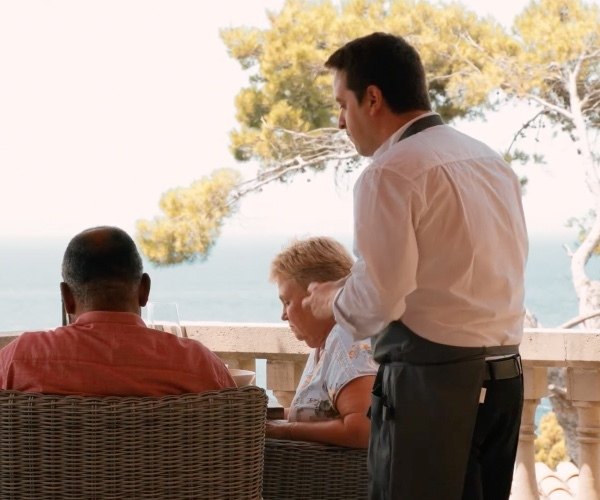
Bens d’Avall
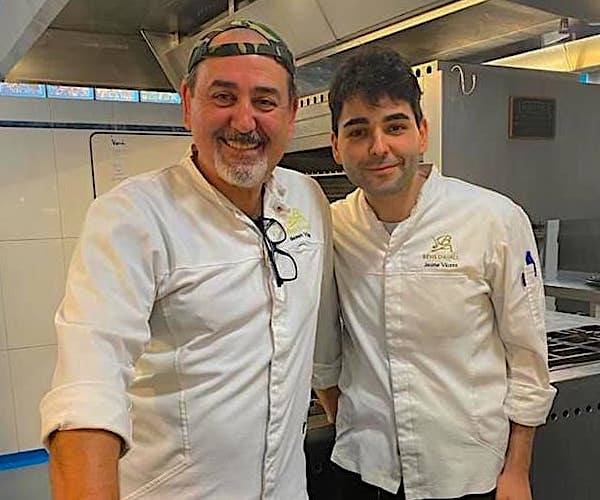
The first went to Benet and Jaume Vicens at Bens d’Avall, Sóller, celebrating 50 years of cooking which has passed from father to son. The location is just spectacular on the the Sóller to Deiá road. Focusing on homegrown produce they have their own cliff terrace vegetable patch.
Dins by Santi Taura
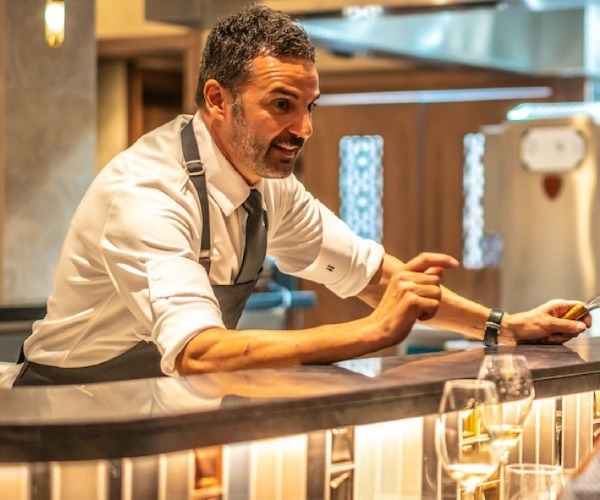
The second new star was awarded to Dins by Santi Taura in Palma. Originally from Lloseta where he owned a restaurant for many years before heading to city, cooking in the new luxury hotel El LLorenç Parc de la Mar, his unique skills have at last been recognised. Of the award Taura said: “We don’t invent anything, we only cook things that are documented in our gastronomic history, such as Fornet de la Soca, but in a restaurant.”
Andreu Genestra’s restaurant
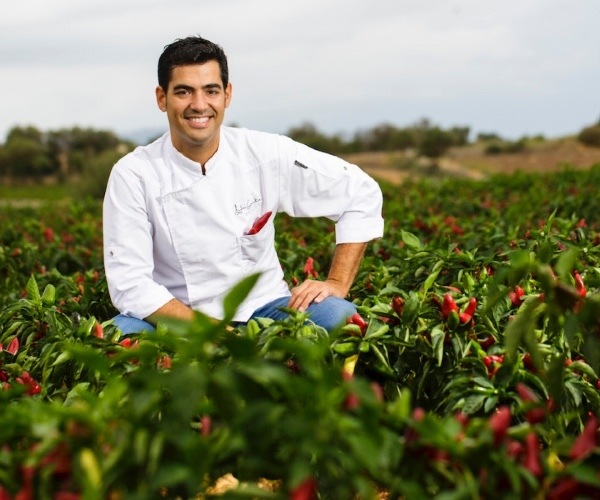
Of the other seven restaurants awarded, Andreu Genestra’s restaurant, in Capdepera received a green star, which is a new category in the Michelin Guide in recognition of sustainability and environmental awareness. Genestra’s was the only restaurant in Mallorca to achieve it, along with twenty others across the rest of Spain. Located in the north east of the island at Hotel Predi Son Jaumell, the location is special.
The other six star were awarded to:
Marc Fosh

Marc Fosh, the first British chef to have ever won a Michelin Star in Spain. Marc opened Marc Fosh Restaurant 12 years ago and in 2017 won his Michelin Star and has maintained it ever since.
Marc Fosh Restaurant is located in the 17th century Hotel Convent de la Missió in the heart of Palma. Marc has also recently opened Sa Pleta in the sister hotel Pleta de Mar in the north east of the island which will be open this year to non-residents for the first time.
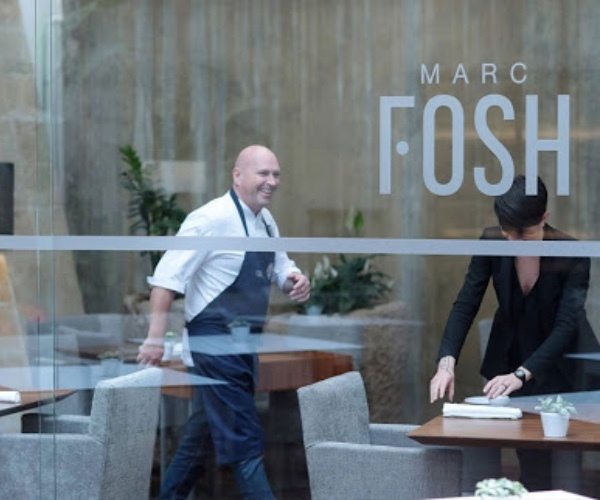
Adrián Quetglas Palma
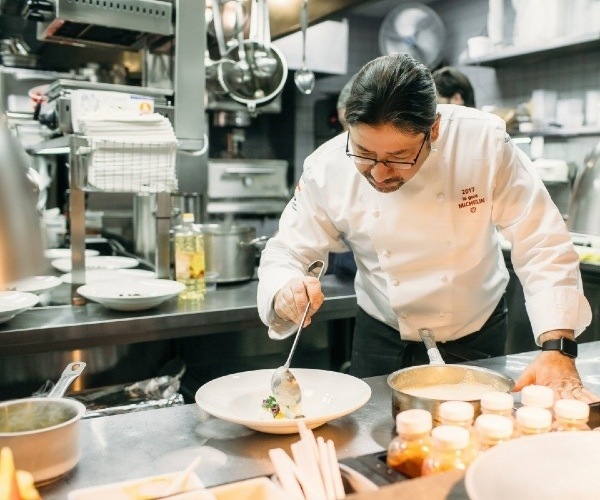
Born in Buenos Aires to a Mallorcan father, his professional journey has taken him from Paris to Moscow training with great chefs such as Marc Fosh ( above ) and he now calls Mallorca his home. He likes to cook traditional family meals with a twist such as escaldons, tumbet, frito mallorquín and empanadas.
Es Racó des Teix
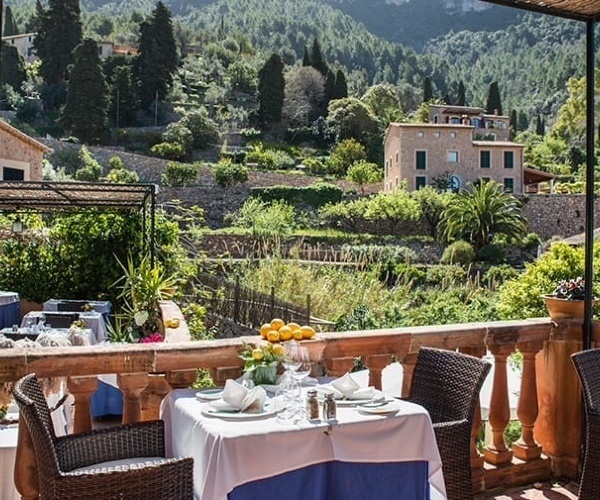
Es Racó des Teix, Deiá has German chef Josef Sauerschell at the helm. Before opening his own restaurant, he worked as a chef at the luxury Belmond La Residencia also in Deià. For his creations there, he obtained a Michelin star in 1991. In 2000 he and wife Leonor opened their restaurant in Deià, which was awarded a star in 2002 and has retained it annually since. With a vine-covered terrace and views across the Tramuntana mountains out to the Mediterranean, its location is superb.
Es Fum
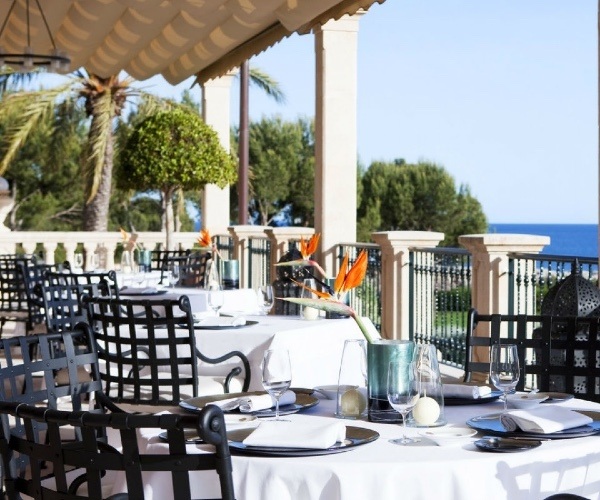
Es Fum is located in the 5 Star St Regis Mardavall, south west of Palma. Miguel Navarro, the head chef since 2017, fuses the freshest produce of Mallorca with the best Mediterranean flavours in every dish.
Maca de Castro
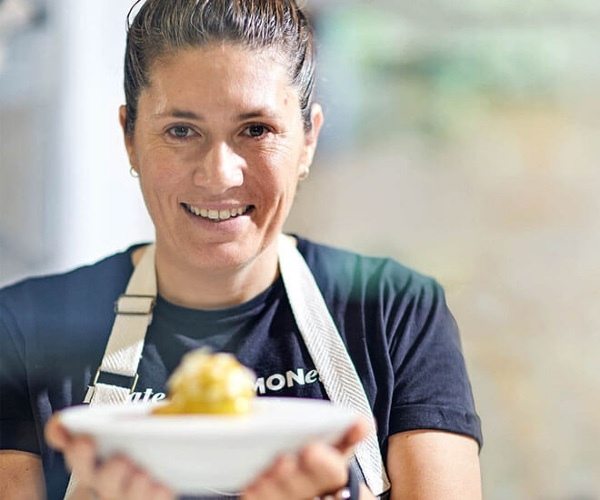
Maca de Castro Restaurant in Port de Alcudia is run by female chef Maca. Maca de Castro’s cooking dispenses its passion for Mallorcan food. Born in Mallorca and from a family with close ties to the world of gastronomy, she has developed an affinity with local ingredients.
Voro
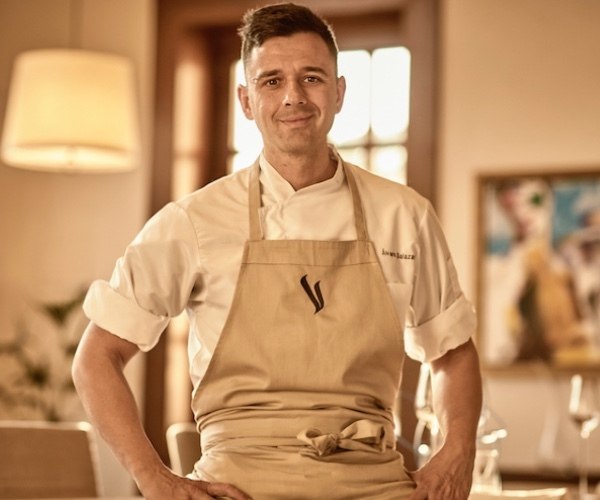
Voro headed up by Álvaro Salazar was awarded a Michelin star for the second year. Voro is located in the Cap Vermell Grand Hotel in Canyamel in the north east of the island with its cuisine embedded in the Mediterranean.
In addition to the Michelin stars this year on Mallorca, there were two Bib Gourmand awards for the first time, often a precursor to a future Michelin Star.
Miceli
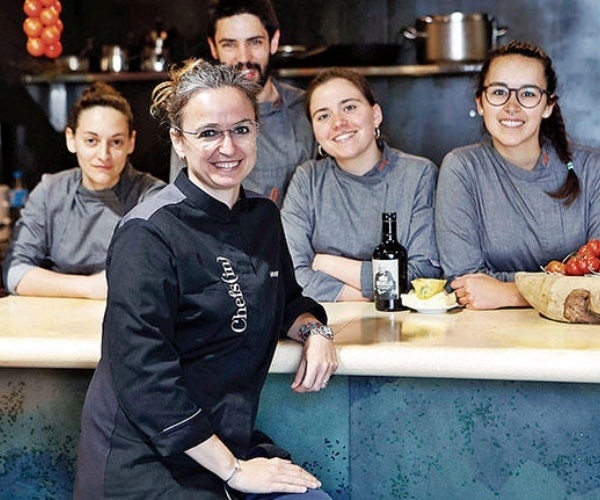
Miceli, by Marga Coll. A family-run restaurant in the village of Selva with lots of personality set in a charming stone house in which Marga was born. Taking its name from the filaments (mycelia) that mushrooms use to extract nutrients from the soil, the food and the location are special, with a terrace, partially covered by a glass porch, enjoying superb views. Traditional Mallorcan cuisine with a modern twist.
Can Boqueta
Can Boqueta, by Kiko Martorell has long been a favourite for residents and visitors alike in Sóller. . Occupying a typical Mallorcan town house with rustic decor and a lovely patio for warm evenings, owner-chef Kiko offers an innovative take on Mallorcan cuisine enjoyed on two tasting menus – a simpler offering at lunchtime and a more elaborate option in the evening.
What a difficult decision you have ahead of you! Wherever you choose, I guarantee you will leave with memories that will last a lifetime.
By Deirdre O’Connor
Celebrate Pride

Celebrate Pride this Summer in West Palm Beach in a luxurious guest room view of Palm Harbor Marina (Based on Availability-Available for Standard and Waterfront Upgrades). You and your partner will enjoy breakfast for two people in our Proper Grit Restaurant. Head to the rooftop and enjoy two complimentary drinks at Spruzzo. Complimentary valet or self-parking included.
If you’re thinking of getting hitched, The Ben offers a beautiful venue for all your wedding needs. With two beautiful venues for a cocktail/engagement party or a reception, the Ben provides an amazing place to make all your dreams come true. For weddings and elegant affairs, The Ben’s rooftop Blue Heron Ballroom ups the ante on events in the area. The space can host up to 500 guests and is the only rooftop ballroom in all of West Palm Beach with captivating ocean views from Singer Island to Palm Beach Island and beyond.
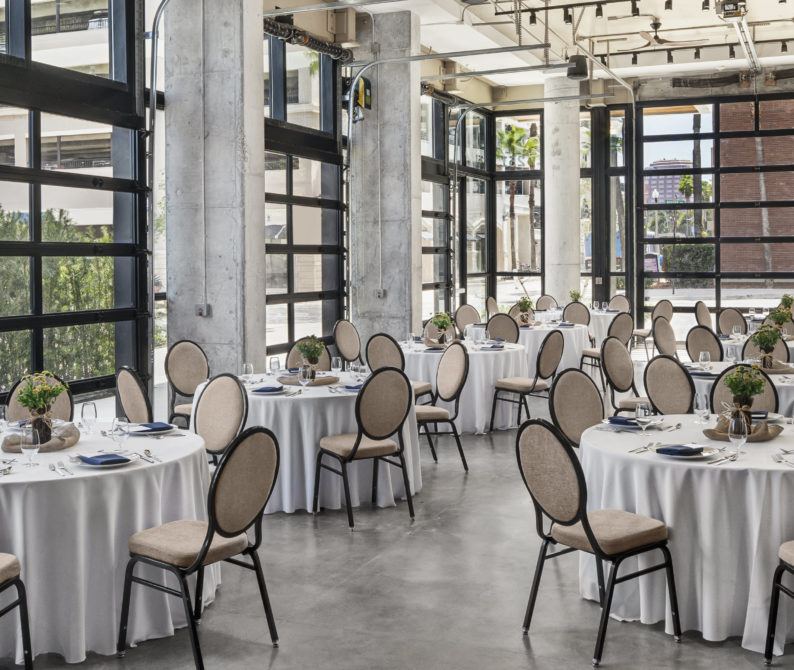
Can’t leave fido at home? In the Ben’s pride package, they’re waiving the pet fee! Bring your beloved animal to the hotel for free! Take a stroll on the beautiful Intracoastal with your #1 friend.

Package details:
- Upgraded luxurious overnight accommodations in King Guestroom = Available for Standard and Waterfront Upgrades ($100 USD Value)
- Breakfast for two in Proper Grit
- Two Drinks at Spruzzo Rooftop Restaurant and Bar
- Waived Pet Fee (value $125 USD)
- Complimentary Valet or Self-Parking ($35 value USD)
****Be sure that Promotional Code 4LG appears in the Corporate/Promotional code box when making your online reservation.
Funazushi is the fermented predecessor of modern sushi
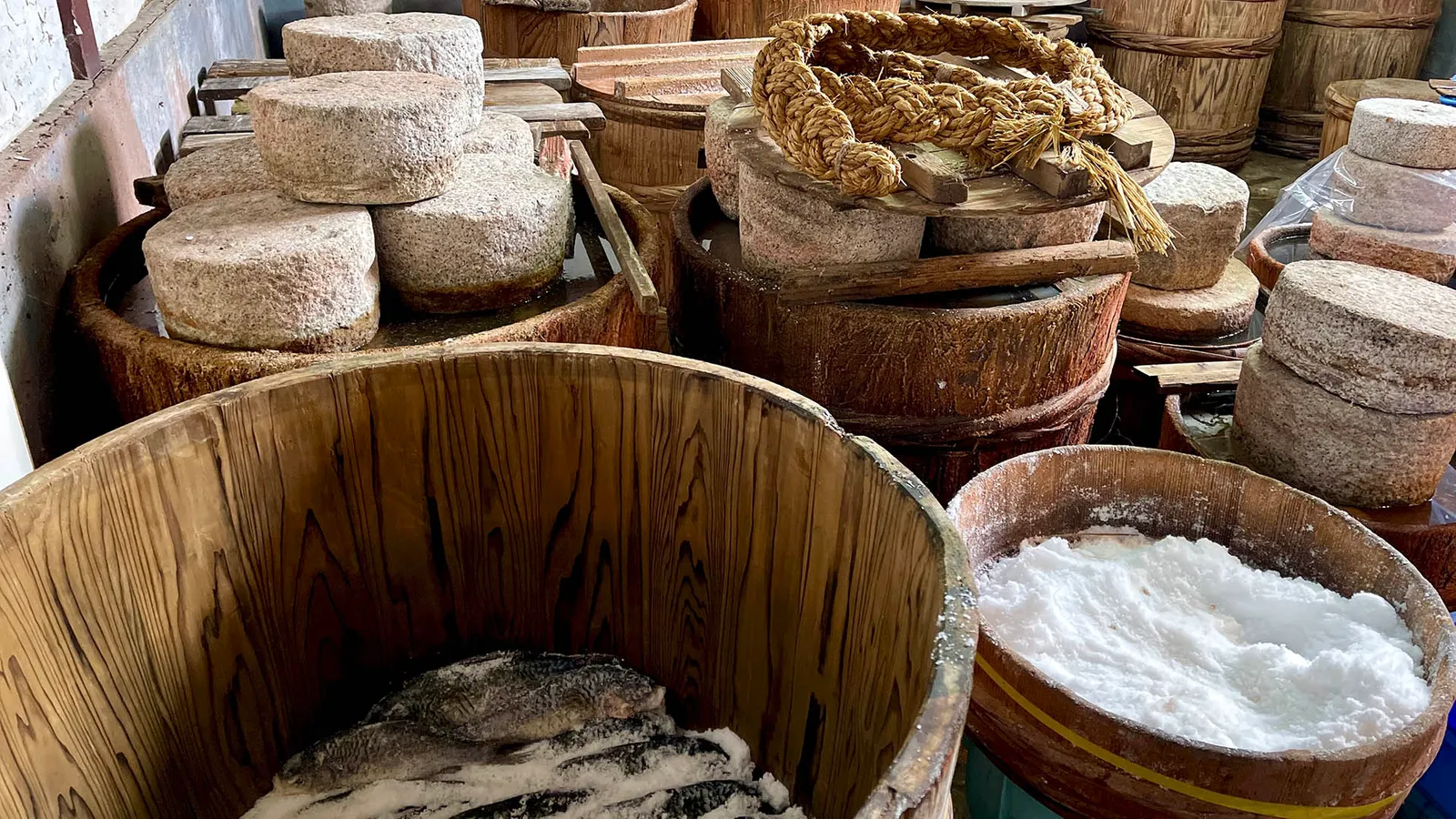
For the past 18 generations, one family has preserved a 400-year-old recipe showing how sushi once tasted, and it doesn’t use raw seafood, but fish aged for three years.
On any fine day in spring, when the sky is clear and the waters of nearby Lake Biwa are calm enough for locals to go carp fishing, you can find Mariko Kitamura and her husband Atsushi at their shop Kitashina in the small Japanese town of Takashima making sushi.
With the dexterity and speed you’d expect from sushi chefs, they scrape off the fish’s scales with a knife, remove its gills and carefully angle a skewer down its throat to remove its innards without penetrating its flesh. But what happens next is truly unexpected. They pack the fish with salt, layer them in a wooden tub, weigh the lid down with 30kg stones and leave them to cure for two years. Each fish is then thoroughly rinsed, dried in the sun for a day and fermented for one more year in cooked rice before it is ready to be eaten.
This is not the kind of sushi you might get in New York or London, or even easily in Tokyo for that matter. It is the predecessor of what the world now knows as sushi – the original sushi – called narezushi (fermented sushi). Kitamura’s family has been making it for 18 generations, ever since Kitashina opened in 1619 in this remote corner of Shiga prefecture, and today the centuries-old shop is one of a handful of places left in Japan, and the world, where you can experience how “real” sushi is supposed to taste.
Narezushi is thousands of years old and traces its roots back to the rice fields of China, where the method of curing in salt and fermenting the freshwater fish that lived in the paddies was developed to give the seasonal catch a long shelf life. It is believed to have arrived in Japan at the country’s ancient capital of Nara sometime in the 8th Century. For the next 1,000 years, until it evolved in the 18th Century into the slices-of-raw-seafood-draped-over-mounds-of-rice dish we know today, narezushi was a commonly consumed, nourishing and tasty source of protein. People would eat a few pieces of it with the fermented rice. They’d put a slice of it in hot water to make a medicinal tea. And they enjoyed it as a delicacy with sake at the tables of aristocratic and samurai families.
As a testimony to narezushi’s importance and the skill required to make it, Kitamura’s ancestor 18 generations back, Kuemon Yamagataya (Kitashina’s founder), was appointed to the entourage of Lord Mitsunobu Wakebe when he moved to Takashima in 1619 to take charge of the castle at the request of Japan’s new military leader, Ieyasu Tokugawa.
Unlike modern sushi, which typically includes ocean seafood, Narezushi was made – and still is in small pockets of Japan – with pretty much anything that swims in fresh water, including tiny loach, ayu (small sweet fish) and eel. But the kind of narezushi Kitashina makes is much rarer and is considered the true prototype of sushi. It is called funazushi after the type of fish used: funa (carp).

Carp is the king of freshwater fish in Japan, with the most prized being Japanese crucian carp (nigorobuna), which is the original type of carp used to make funazushi and the kind Kitashina features. It is a wild, rich-tasting species that’s found only in Lake Biwa, Japan’s largest lake and one of the oldest lakes in the world.
Today, there are just five shops around the lake that specialise in making high-quality funazushi, as nigorobuna has become very rare and hard to obtain. Other places, including souvenir shops across the prefecture, use more common types of carp and offer a comparatively ready-made version – funazushi cured in salt for one summer and fermented in rice for a few months in autumn – for tourists seeking to try its reputedly pungent taste. Among them all, Kitashina is the one making the most authentic funazushi by using nigorobuna and applying the oldest, most traditional preparation methods.
You may also be interested in:
• The Japanese village that cooks in a hot spring
• Is Japan losing its umami?
• Japan’s mysterious ‘lake of the gods’
The good stuff is hard to get, though. Peak demand for Kitashina’s funazushi is from November to February when customers order it as a New Year’s treat, and later, to celebrate the arrival of spring. It can be sold out then, but a fresh batch, so to speak, is ready every year in mid-summer.
Before trying funazushi, Kitamura told me that it tastes like cheese – which it does, in its lacto- fermented, sour, salty and umami-rich way. It’s reminiscent of a funky and creamy type of cheese, given that Kitashina makes funazushi with the roe-laden female nigorobuna in season from March to May. Like many mature cheeses, funazushi is an acquired taste; a food that takes some getting used to. But then so is eating raw seafood for many people.
Today, funazushi has become a luxury food across much of Japan, with Kitashina being the shop at which to buy it because of its refined, mellow flavour. According to Kitamura, that’s in part thanks to her grandfather, who, despite sushi’s growing popularity, continued to stick to Kitashina’s 400-year-old recipe of long fermentation and changing the rice once during the process. He also introduced the practice of serving it on a bed of sake lees – the sweet, rich paste left after pressing sake from the fermented rice mash – making the dish even more luxurious. Kitamura’s father, in turn, created the “Tomoe” style of beautifully presenting funazushi as a fan fashioned from the slices of a whole fish.
Kitashina’s funazushi is now featured on the menus of some of the most exclusive ryotei (traditional high-end Japanese eateries) and other top restaurants in Kyoto, as well as at similar establishments in Tokyo. Taking a cue from Kitamura’s grandfather’s presentation, chef Takumi Murata, of the L’Hotel de Hiei located atop the historical Mount Hiei overlooking Kyoto, serves Kitashina’s funazushi with wine jelly as an appetiser in the hotel’s main restaurant.
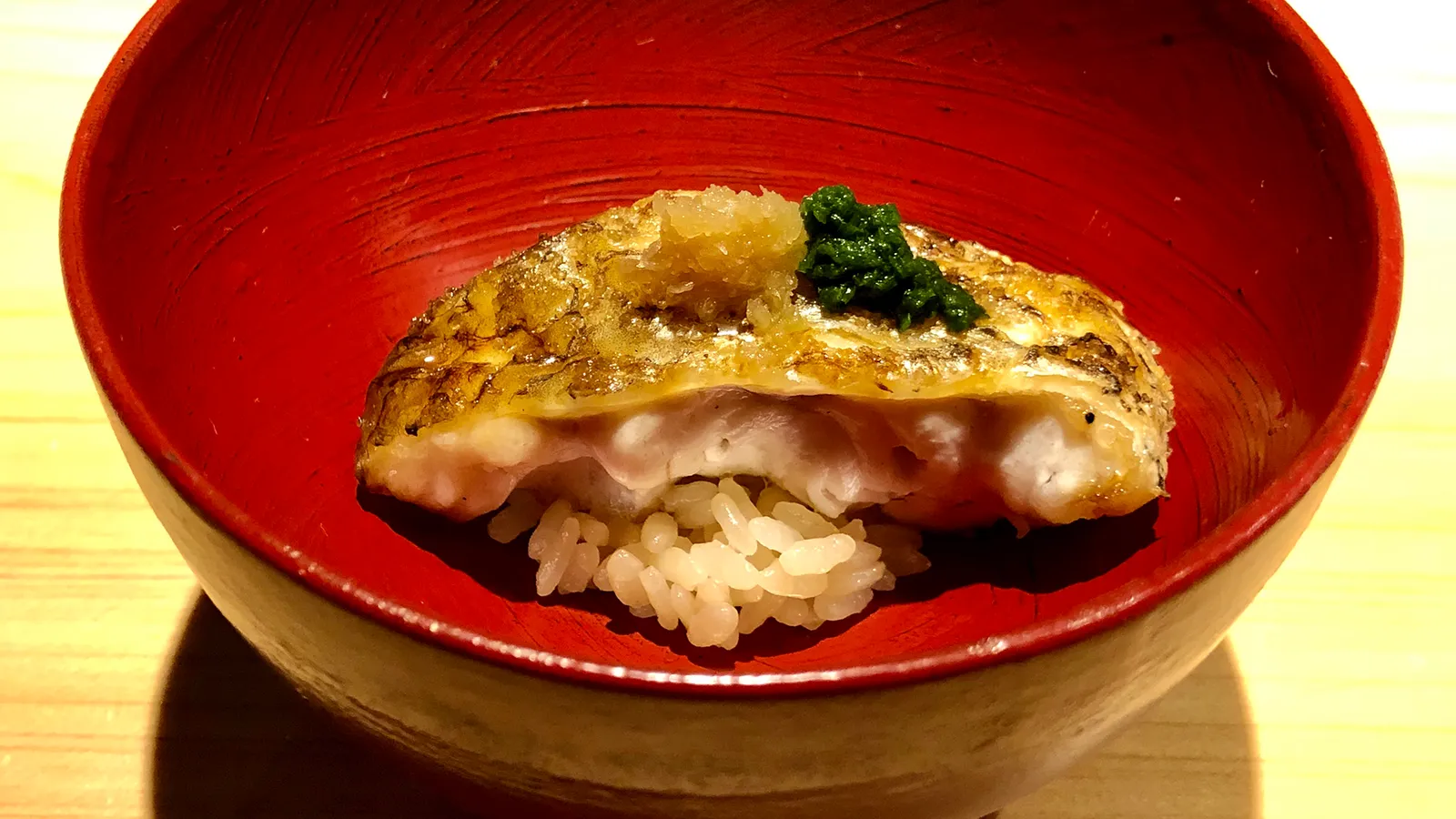
Compared to narezushi’s millennia-old history, the sushi we eat today is a mere footnote. Technically called hayazushi (fast sushi), it was created in Edo (modern-day Tokyo) in the late 18th Century as a fast-food version of narezushi to meet the needs of the city’s busy people. The newly bottled seasonings of fermented rice vinegar and soy sauce were used to recreate the essential sour, salty and rich taste of funazushi in the fresh seafood that was caught in Tokyo Bay. First, rice vinegar was added to cooked rice to speed up the fermentation process to just a few days. This practice also made the rice more edible. Later, freshly cooked rice was simply soaked with rice vinegar.
The gamechanger, however, was soy sauce, which began to be mass produced in the 1700s. As Issei Tomioka, a former employee at the Tokyo Metropolitan Central Wholesale Market in Tsukiji, wrote in his series The History of Nihonbashi Uogashi, “sushi would likely not have been developed had it not been for soy sauce.” Brewed for at least two years, traditional soy sauce is a concentrated form of salty-savoury umami. Initially, it was used to marinate the seafood toppings for a few hours to prevent them from spoiling and also to make them more appetising. As the fresh quality of the seafood improved, sushi was served raw with soy sauce as a condiment.
Sushi is a remarkable example of the way Japan adopts foods from other countries, in this case China, and then adapts and assimilates them into its own rich culinary culture. After thousands of years, sushi continues to evolve.
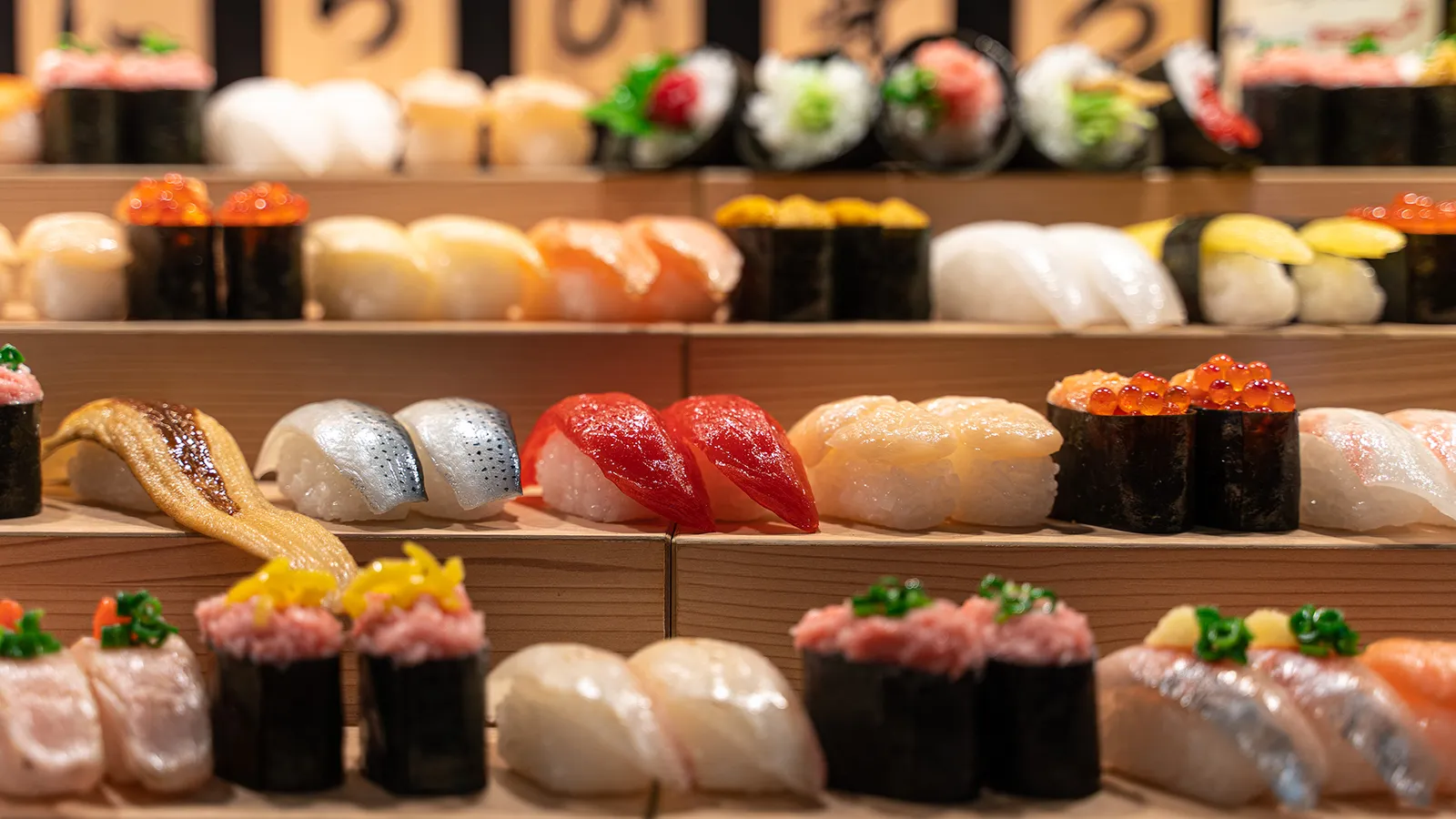
Currently, the pendulum is swinging backwards, and sushi chefs in Japan are now aging their seafood toppings for days, weeks and even months to give all kinds of fish the creamy texture and savoury richness of funazushi. Koji Kimura, chef-owner of the two-Michelin-starred Sushi Kimura in Tokyo’s Setagaya ward, has been serving only aged sushi since 2008 and is considered its modern-day pioneer.
Closer to Takashima, Yoichi Akashi, the chef at Sushi Zabo in Miyazu City, is following the tradition of Kitashina’s funazushi by taking an already rich-tasting, fatty fish like akamutsu (rosy seabass) caught fresh from the nearby Sea of Japan, and making it even more luscious through aging.
But even as chefs rediscover the potential of weeks- and months-aged sushi, Kitamura is staying well ahead of them. In a corner of Kitashina’s storeroom, she has a small wooden tub of funazushi that has been fermenting for eight years and counting.
By Tom Schiller www.bbc.com
A meal without beans is incomplete in Brazil
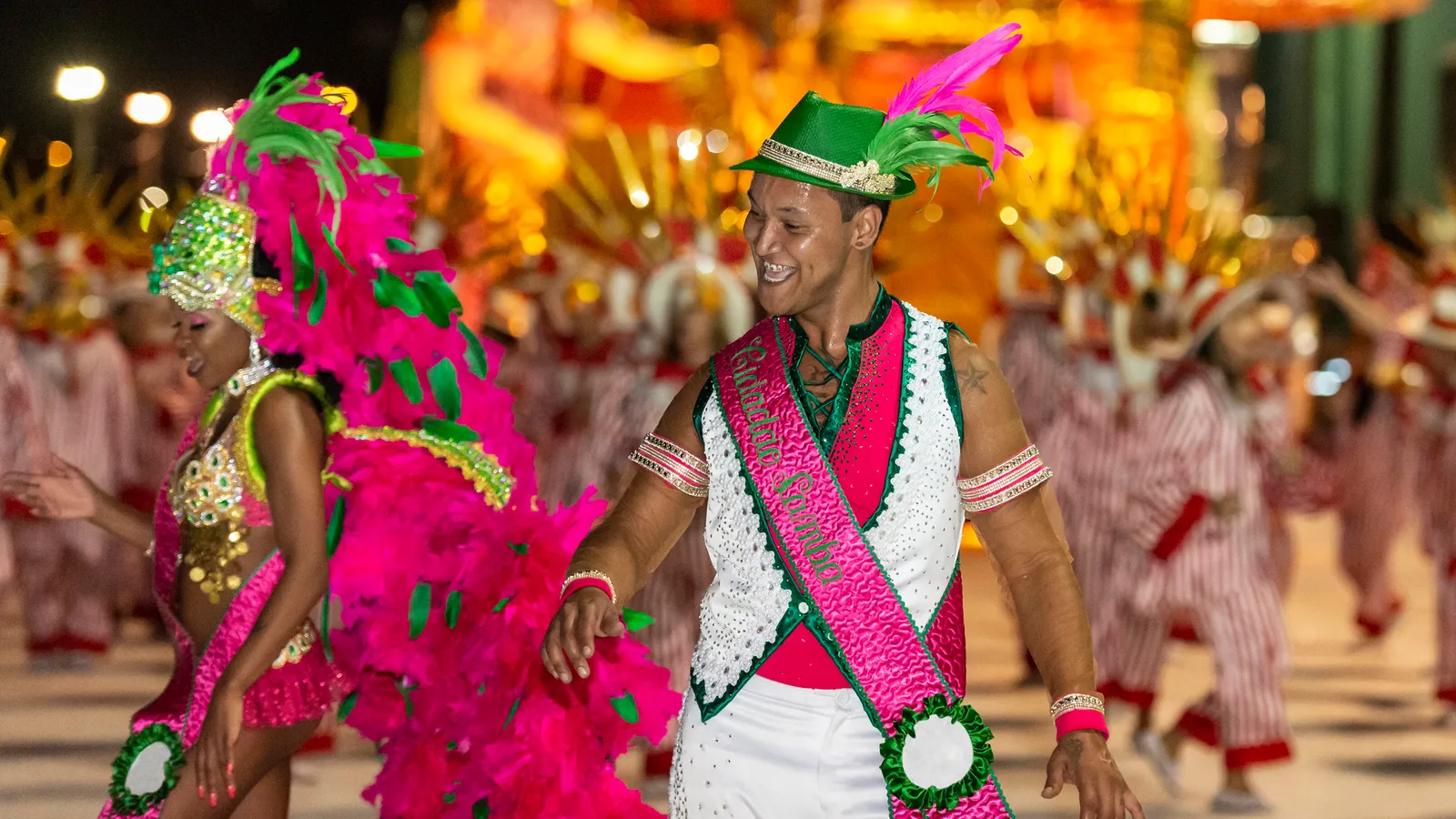
In Brazil, poverty, colonisation and modernism turned beans into the culinary symbol of this continent-sized nation.
In mid-February this year, if it weren’t for the pandemic, hordes of Brazilians and travellers would have packed out Carnival street parties and sambadrome parades for five uninterrupted days of music and dancing. Those in Rio or São Paulo would certainly have come across the black bean-based feijoada, Brazil’s flagship stew and an omnipresent meal in south-eastern Carnival celebrations. In Bahia’s capital, Salvador, revellers would have likely feasted on acarajé, a typical Afro-Bahian fritter made of black-eyed peas.
“Ten out of 10 Brazilians prefer beans,” says the theme song of a 1979 soap opera – not surprisingly, called Wonder Bean. Poetic license aside, the truth is there is no food so popular in Brazil as beans. More just than a favoured ingredient, they are the culinary symbol of our national identity.
Beans are a source of inspiration for songs and poems; and the country registers more than 4,000 varieties, from feijão carioca (pinto bean; consumed in São Paulo) to feijão de corda (a sub-variety of black-eyed peas, common in the north-eastern state of Ceará) to feijão manteiguinha-de-santarém, which is consumed in the Lower Amazon region. As renowned anthropologist Luís da Câmara Cascudo affirmed, for Brazilians, a meal without beans is incomplete.
But far from an arbitrary phenomenon, the symbolic power invested in an ordinary legume (whose pods provide the seeds we eat) also tells the story of Brazil’s turbulent socio-political history.
You may also be interested in:
• The Amazon’s staple food that kills
• How the humble potato changed the world
• Brazil’s cute and complex small talk
Before Brazil gained independence in the 19th Century, its inhabitants had long been feasting on beans. Although the first records of beans date to the 17th Century (one of them in the travelogue of Dutch explorer Johan Nieuhof, who travelled across the territory from 1640 to 1649), Brazil’s Indigenous communities were eating the seeds long before colonisation.
According to food sociologist Carlos Dória, author of The Formation of Brazil’s Cuisine, a native bean species from Peru (Phaseolus vulgaris, known as “common bean”) arrived in Brazilian territory from Peru thousands of years ago, washed along in the currents of the Amazon and Solimões rivers.
But beans were never a key ingredient in the Indigenous diet. Instead, the popularisations of beans is a post-18th Century phenomenon that is closely related to the history of Brazil’s inland colonisation. In order to explore and settle Brazil’s interior, settlers needed a legume that was nutritious and easy to grow in all climates, including the semi-arid. That legume was beans.
Along with their expansionist ambitions, Portuguese settlers and their descendants brought with them an Iberian bean-eating tradition as well as beans species from the Mediterranean and their African colonies, including the black-eyed pea from West Africa, a region with a similar climate to Brazil’s.
One of the most famous bean-based recipes, feijão tropeiro (trooper beans; a combination of dry meat, red beans and cassava flour) refers to Brazil’s historical “troopers” – the men in charge of opening roads and taking much-needed goods, from fabric to salt to soap, into the interior – most notably during the 17th to 19th Centuries.
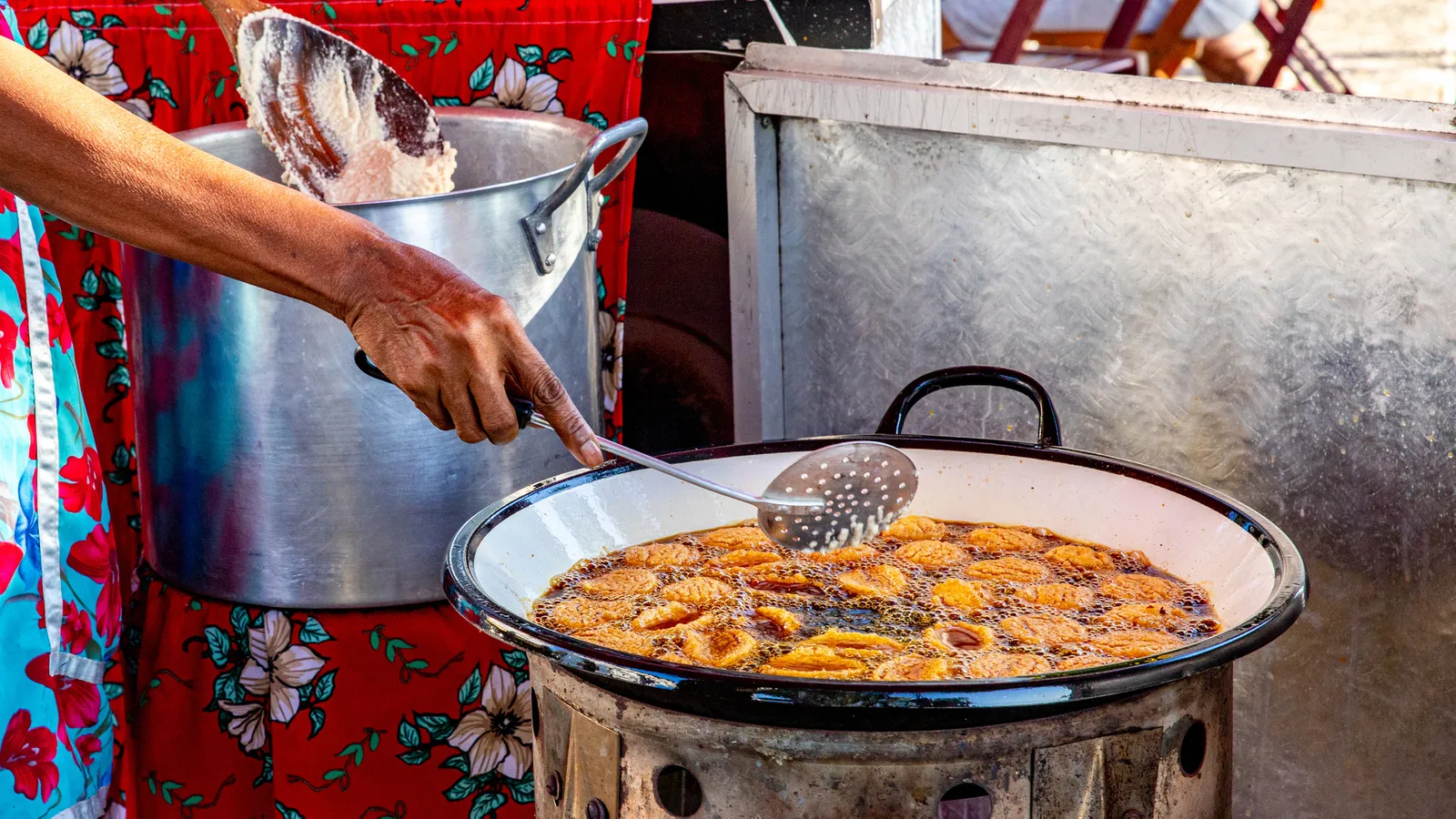
Nutritious, cheap and easy to grow, beans helped address hunger in a Brazil historically composed of poor and enslaved people. Combined with cassava and, since the late 19th Century, rice, beans have represented the bare minimum to keep Brazilians going through the day. “Poor used to be someone who didn’t even have a bean tree at home,” said Dória.
As an ingredient long associated with the subsistence of lower-income people, beans have set a clear class division in Brazil. Until the 1920s, elites, a group that included big landowners, bankers and industrialists, would refuse to eat beans in an attempt to distinguish themselves from the rest of the nation. While bean consumption remains prevalent among the poorer these days (prato feito, a basic combination of rice, beans and meat remains the cheapest meal option across Brazilian cities), this class stigma changed after the country’s nationalist-modernist project took hold a century ago.
From 1922 to 1945, intellectuals and artists realised that rather than mirroring itself on France (once considered a civilisational role model), Brazil needed to define itself from a local perspective. As they sought to create a national identity, anthropologists and sociologists built a narrative around elements that reflected the essence of being Brazilian. The bean-based diet was one of these elements.

“The modernists had to find an element of otherness, one that distinguished Brazil regarding all the other nations,” said Adriana Salay Leme, who wrote her master’s thesis on Beans, owners of traditions: identity representation and effective consumption in Brazil (1973-2009). “Beans represented this identity marker because, at the time of modernism, no other nationality had a food culture as influenced by beans consumption as Brazil’s.”
Today, travellers to Brazil will undoubtedly come across feijoada (a black bean and pork stew) accompanied by rice, farofa (toasted cassava flour), orange and collard greens. Usually cooked on Saturdays and accompanied by Brazil’s flagship drink caipirinha, feijoada is ever-present at samba events, soccer games and even on religious days like Saint George’s, the patron of Rio de Janeiro. No wonder it’s called the most Brazilian of all dishes.
But the dish doesn’t only occupy a special place in local culture because of its flavours. Its immense popularity came about due to modernists promoting the plate as the ultimate synthesis of Portuguese, Indigenous and Afro-diasporic traditions. “The pork would represent the Portuguese cuisine; the cassava flour would represent the Indigenous food culture; the black beans would represent the colour of the Africans,” Dória explained.
The narrative that grounded feijoada’s fame, however, has also been subject to criticism: by claiming an ethnically unified nation, it neglects socio-political tensions that have shaped Brazil’s history. “The discourse behind feijoada aims to mitigate social conflicts, such as slavery and class inequalities, in the name of a happy miscegenated Brazil,” Leme said. “This discourse aims to erase differences, silence tensions and unify the country towards one same national identity. The consequence of such discourse is that we don’t really address the social problems.”
Dória agrees. When feijoada presents itself as the culinary contribution of Indigenous, blacks and whites, it “forgets [that] some have been decimated, others have been slaves, and the latter, cruel dominators,” he said.
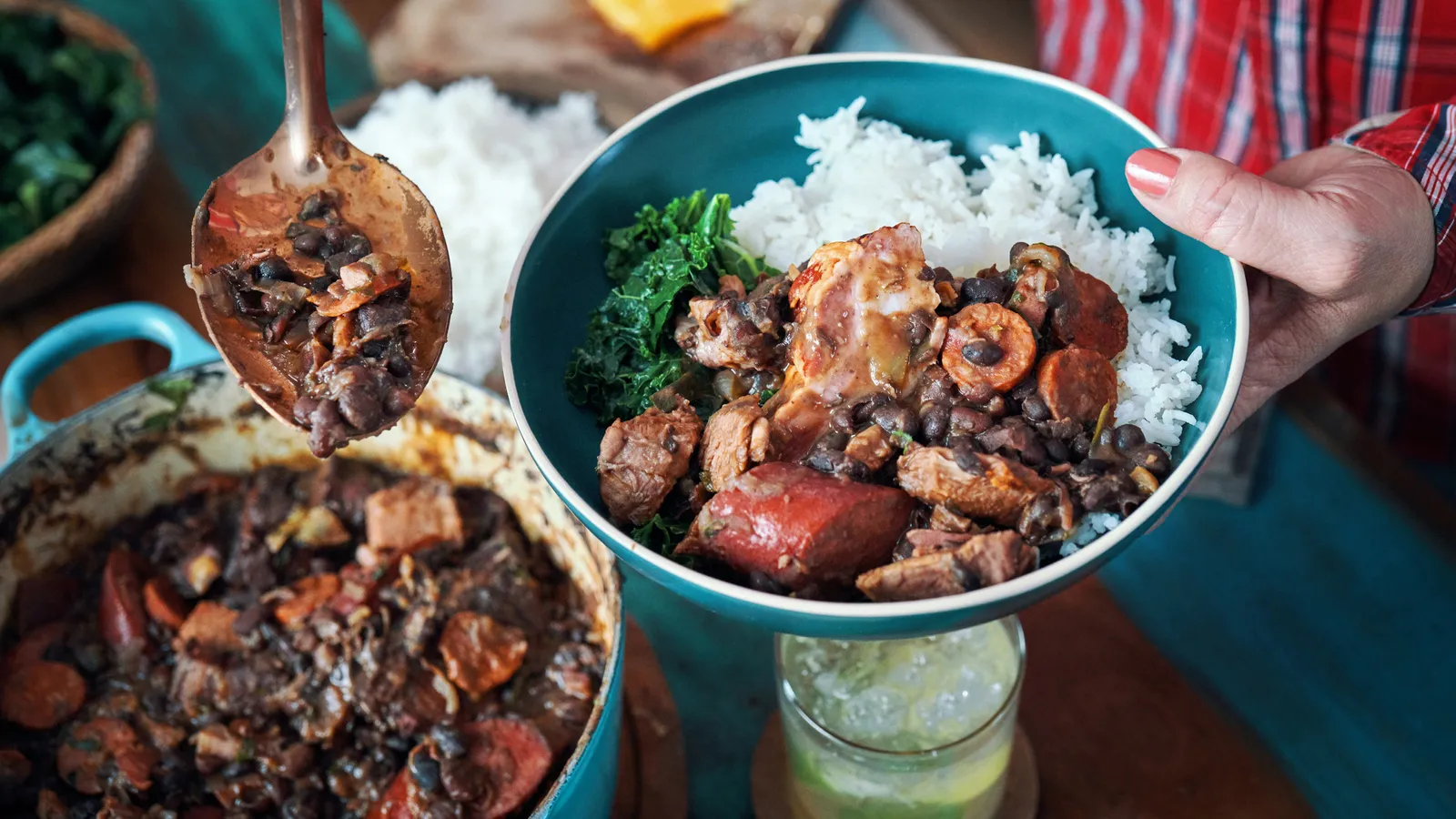
The romanticised feijoada narrative has also led to misconceptions. Most people still believe the narrative that was sold by the intellectual elite in the mid-20th Century: that the dish was invented by enslaved African Brazilians who supposedly improvised amid scarcity by adding leftover pork to black beans. However, according to Câmara Cascudo, who published the anthological History of Food in Brazil (1967), feijoada, as we know it, was first seen in the eateries, pensions and hotels of 19th-Century Rio de Janeiro.
Today, feijoada still reigns in Rio, most notably at popular cultural events such as samba circles, where weekend parties at sanctuaries like Cacique de Ramos, Casa do Jongo da Serrinha and Renascença Clube are usually fuelled by a generous caldron of feijoada, with individual portions usually costing between R$15 and R$30.
As a sharing plate, feijoada is seen as a social dish – as is the samba experience, where people sing, play and dance looking at each other in a single circle. This is why feijoada and samba go along so well, according to Dória. “It is served in large amounts, alluding to a gregarious tradition present in the Portuguese, Indigenous and African cultures that have shaped Brazil’s society. Feijoada, like samba gatherings, inspires communion,” he said.
Beans are vitally important in Afro-Brazilian religions, too. In the rituals of Candomblé (the country’s most disseminated Afro-Brazilian religion), beans are the base of many dishes symbolically offered in sacred rituals for the orixás (gods and goddesses). While feijoada is present in some rites, most bean-based recipes in this religion, like acarajé and abará (another type of fritter), include black-eyed peas and palm oil – a heritage from some of the African cultures that came enslaved to Brazil.
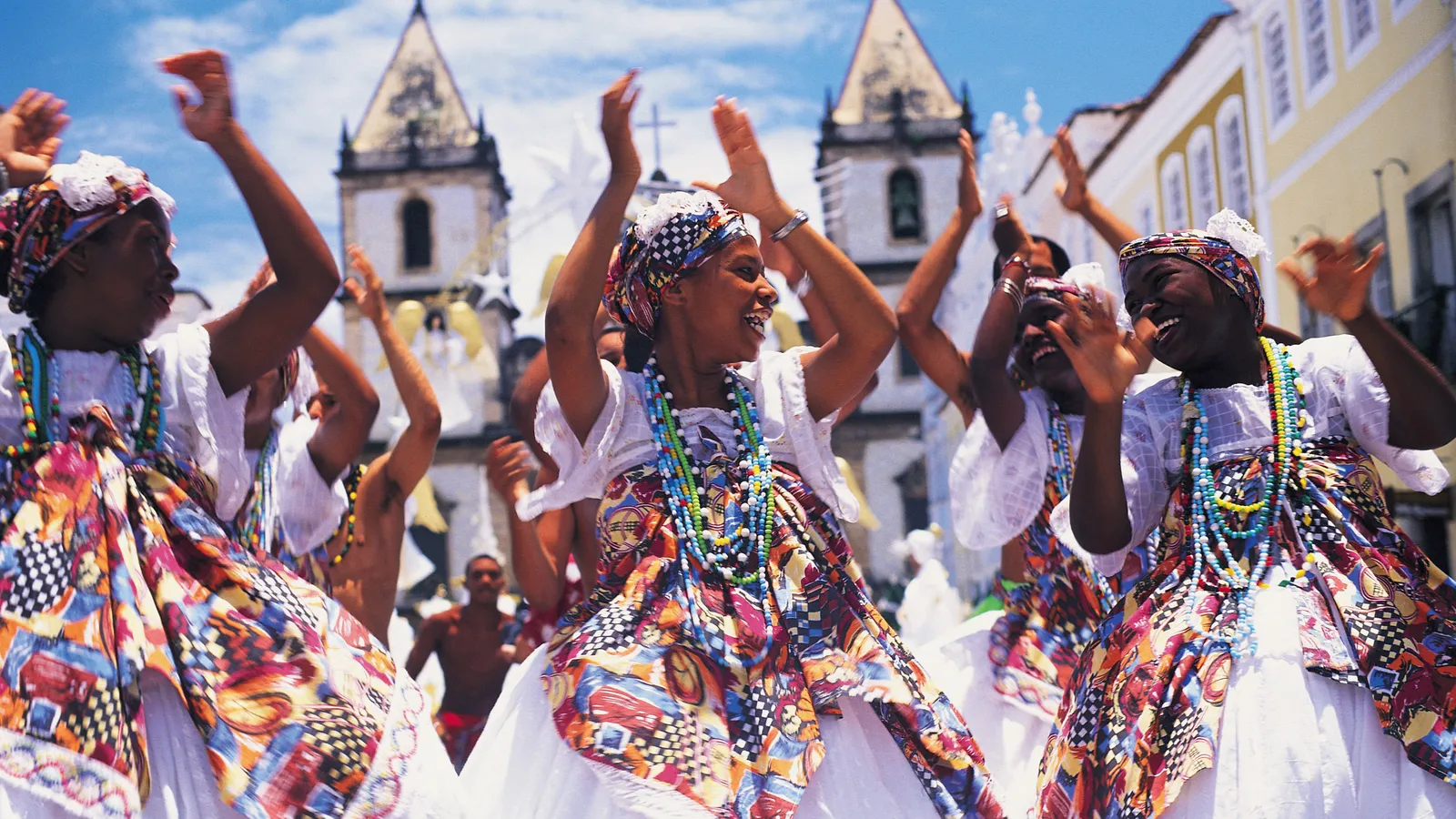
Another of the many bean recipes in Candomblé is omolokum, a dish made with black-eyed peas, boiled eggs, smoked dried shrimp and onions, that inspired Leila Leão to found Casa Omolokum, a Rio restaurant dedicated to Afro-Brazilian religious cuisine.At Omolokum, Leão brings the food of the orixás to Rio’s gastronomic scene. “I like to adapt traditional Candomblé recipes and discover new possibilities. It is a delicious alchemy experience to play with beans, an ingredient so rich in flavour, aroma and beauty,” said the cook, who, as a Candomblé practitioner, had to ask for the orixás’ permission to sell the sacred dishes.
Despite the continued importance of beans in Brazilian culture, however, Brazilians are no longer the massive bean-eaters they used to be. Since the 1970s, their consumption has been declining considerably, with ultra-processed foods gaining space in meals. Even so, their symbolism remains. Beans, as Dória puts it, still represent the common denominator of this continental-sized nation.
“It’s the food through which people either distinguish themselves from each other – whether in terms of status or affection – or get closer to each other,” he said. “This is the sociological role of beans in a diverse and vast country like Brazil.”
Beatriz Miranda is a Brazilian journalist based in Rio de Janeiro, covering the intersections of culture and social issues in her country.
Author Credit – Beatriz Miranda
https://www.bbc.com/travel/article/20210614-in-brazil-a-meal-without-beans-is-incomplete
Effervescent Sima is a Finnish drink with a heroic past
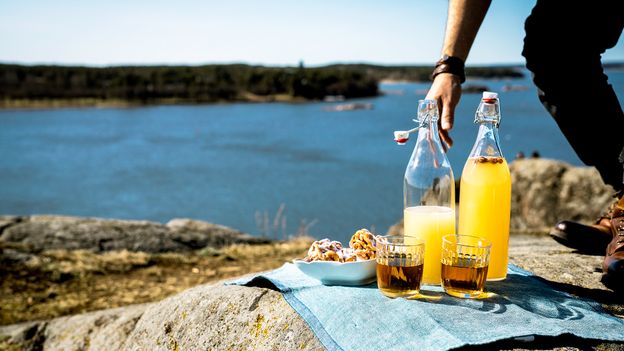
In the 16th Century, effervescent sima was a more desired drink than beer and has since become Finland’s go-to beverage for ushering in spring.
Finland is known for its triple “s” – sisu (resilience), sauna and Sibelius. But for centuries, there has also been a fourth, more subtle “s”: sima, a fermented drink made with water, sugar, lemon and yeast. Today, effervescent and virtually non-alcoholic sima is beloved across the nation, most often consumed by children and adults alike as a special drink to celebrate Vappu, or May Day, a time when Finns flood the outdoors to embrace the coming of spring.
I had my first taste of homemade sima, its soft bubbles sparkling in the spring sunshine, 35 years ago in my friend’s garden in the Finnish city of Pieksämäki. It was the eve of Vappu, and the drink’s sweet acidity left a memory in my brain that has stayed with me to this day. As it also happened to be my fourth birthday, it took some time for me to realise that the celebratory refreshment had nothing to do with my special day, but instead was part of a rich piece of Finnish history that stretches back centuries.
Sima’s roots stem from the ancient alcoholic drink mead, or honey wine, which was widely drunk in early Bronze Age Europe. Mead, which in its simplest form is fermented honey and water, wasn’t specific to Europe – it’s also mentioned, for example, in India’s Rigveda, an ancient collection of Vedic Sanskrit hymns. But, perhaps due to TV series such as Game of Thrones and The Vikings, mead’s modern-day fame lies on the shoulders of 8th-Century Vikings, who enjoyed a highly alcoholic mix of water, honey and herbs such as meadowsweet and harrow. For them, mead was a drink from the gods that gave people strength to win battles. In fact, Vikings held mead in such a high regard that aspiring chieftains would build their own mead drinking halls to gain their followers’ respect.
Nevertheless, the citrusy mead that more closely resembles today’s sima didn’t dock on Finnish shores such as those of the seaside city of Turku until the 16th Century, imported from the Hanseatic Northern European towns in what is modern-day Germany and Latvia. This 16th-Century drink – which, contrary to today’s low-alcohol sima, contained up to 17% alcohol due to a longer fermentation process – was a more desired drink in Finland than beer.
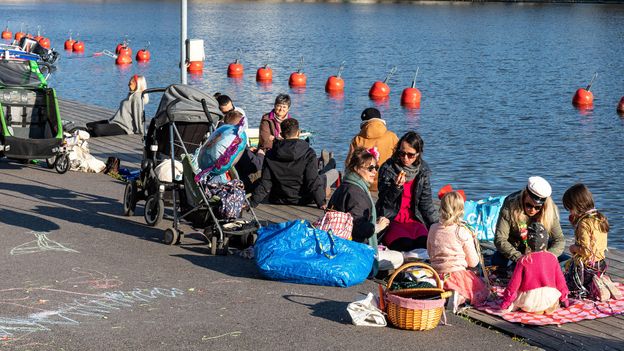
One of the busiest 16th-Century Finnish importers was savvy merchant and shipowner Valpuri Erkintytär Innamaa, a strong-willed woman who helped make sima the iconic Finnish Vappu beverage it is today.
In Innamaa’s day, Turku was still part of Sweden. When Gustav I was crowned king in 1523, he recognised the city’s strategic importance, renovated its dilapidated castle and occasionally visited. While in town, he enjoyed Turku’s sima, making it a fashionable drink among the bourgeois. According to Seija Irmeli Kulmala, author of the recipe book Sima – a festive drink made with nature’s ingredients, “King Gustav I of Sweden loved the sima he tasted in Turku. He created a sima boom,” she said. “Sima was imported [from Riga and Lubeck] in vast quantities and its popularity grew.”
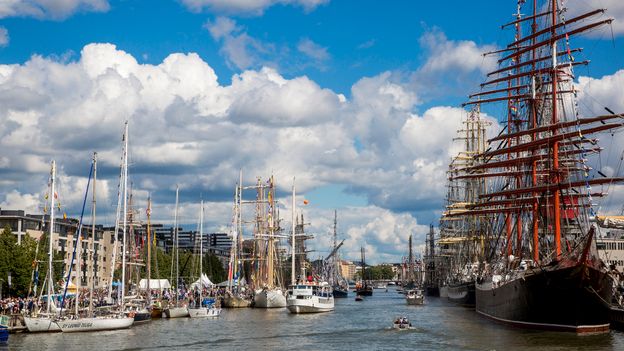
Innamaa’s first husband had received a royal warrant of appointment from the Swedish court residing at Turku Castle to provide goods he had imported. When he died in 1563, Innamaa took over the merchant business, becoming the wealthiest Turku merchant with the city’s biggest fleet of ships. Spurred by the craze for sima that Gustav I had created in Turku, Innamaa started importing more of the increasingly popular drink from Baltic ports, spreading it at least as far as Stockholm. In the Swedish capital at the time, sima was nearly as expensive as wine.
Innamaa’s success in business was remarkable, as traditionally her late husband’s inheritance would have been transferred to her new spouse. Instead, she took control of the business herself – even after marrying three more times. Her success made her an easy target during the 1560s political turmoil that followed Gustav I’s death, and she was attacked and looted more than once. Yet, according to Kristiina Vuori, author of the historical novel Western Winds based on Innamaa’s life, Innamaa wasn’t afraid of enemies. “She even travelled to Stockholm to tell the king himself about the injustices she suffered,” Vuori said. “Despite being a woman, [Innamaa] wouldn’t be silenced.”
It took more than two centuries for sima to drip from high society’s goblets to working-class glasses in Finnish homes. In Innamaa’s day, sima remained an expensive upper-class beverage because both of the drink’s main ingredients, honey and lemon, were still a rarity in the region. “Because of honey, sima was very expensive and only the richest bourgeois and Turku Castle’s court could afford it,” said Vuori.
By the 18th Century sugar had replaced honey, but was a rare commodity as well, dependent on imported sugarcane until Europe began producing sugar from beets. Once Finland’s first sugar refinery was established in Turku in the 1750s, increasing numbers of Finns were able to make and afford sweet luxuries like sima. During this time, working class people could get a taste of sima at special events like the local vicarage’s springtime gatherings. Decades later, that changed, and people could enjoy it more often, “when sima’s ingredients – sugar and lemon – became more readily available in the 19th Century,” said Kulmala.
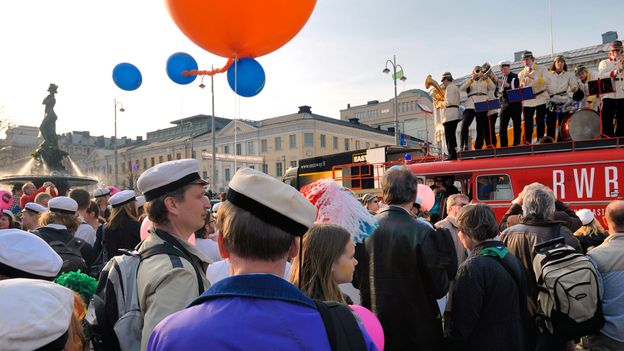
In the 1880s, Finland also began commercially producing yeast, making sima even easier to make on a large scale. Local companies could suddenly produce the drink with more consistency, and it was sold in kiosks and cafes across Finland. By the early 20th Century, sima, now virtually non-alcoholic, became the go-to beverage of Vappu, the festival to celebrate spring’s arrival.
According to Tiina Kiiskinen, curator at Helsinki’s Hotel and Restaurant Museum, the connection to Vappu came about thanks to the Finnish Temperance Movement, which first gained popularity at the end of the 19th Century and swelled to become an ideological social crusade that resulted in a full ban of alcohol between 1919 and 1932. “Around the turn of the 20th Century, there was a strong will to find a non-alcoholic alternative to drink at the celebrations,” Kiiskinen said. “Sima was popular because it was cheap and resembled sparkling wine. Advertising further solidified sima’s status as a May Day drink.”
More than 100 years on, the temperance movement has lost momentum but sima remains a quintessential part of Finnish Vappu. The annual celebrations stretch from 30 April to 1 or 2 May, during which market squares fill with stalls selling food and balloons, people dress up in quirky costumes like colourful wigs and fake red noses, and young and old alike gather to sip sima and enjoy a spring day out with friends.
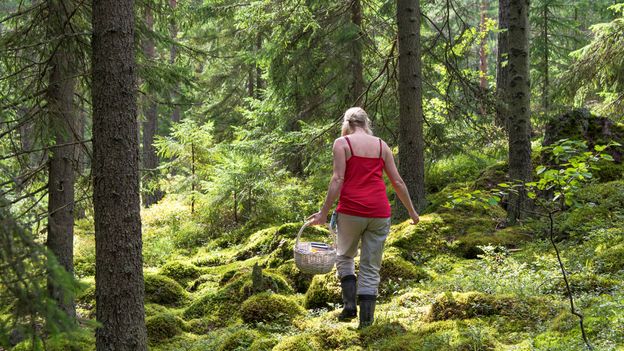
The reach of sima also extends beyond the festivities. Young students learn to ferment sima in schools; restaurants offer sima on their Vappu menus alongside herring, potato salad and sweet pastries; and big breweries bottle and sell their own versions of the drink. Each spring, shop shelves fill with varieties of sima, and newspapers review the best brands. Furthermore, artisanal food culture has turned homemade sima into a trend, with creative home brewers experimenting with new flavours ranging from spruce to cucumber to rhubarb.
I, too, have dabbled in making my own. Following Kulmala’s sima recipe from her book, I added pineapple and orange to the traditional lemon rind and juice, mixed everything together with sugar, then poured over near-boiling water, adding a pinch of yeast when the water had cooled down a little. After waiting eight hours, I strained the sima into bottles and topped each with a few raisins. Once a day for almost a week, I opened the bottles to let the pressure escape, and, once the raisins rose to the surface, I knew the fermentation process was complete.
This spring, while tracing the path of sima from Viking drink to a Finnish spring tipple, I ventured to Turku with a bottle of my homemade sima. In the Turku castle’s cobblestone courtyard, I imagined being back in Innamaa’s days, when barrels of sima would be hauled into the castle and enjoyed by the court. I popped the cork, my fingers getting sticky as the lightly pressured drink fizzed onto my hands. A lemon scent surrounded me and pulled me back to childhood. I took the year’s first sip of sima, let the citric sweetness roll on my tongue and made a toast to the rich history of Finland.
By Paula Hotti www.bbc.com
The best golf resorts for non-golfers in the U.S. South
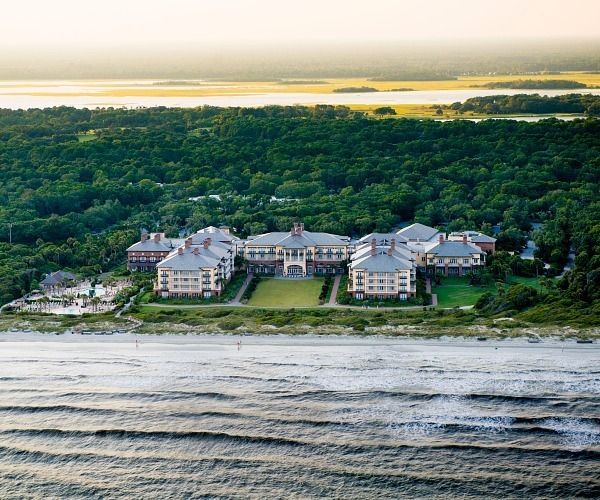
For golfers and non-golfers alike, these three southern golf resorts in the U.S. provide a perfect luxury getaway. I must begin by stating that I’m not a golfer. I love looking at golf courses, and I’m a fan of the stylish outfits all the golfers wear these days, but a golfer, I am not. That said, golf resorts have so much to offer each of us, and we might not tee it up with the others, but we can certainly find plenty to keep us busy while on these expansive and luxurious resorts. There is no shortage of amazing golf destinations around the world, but I want to feature several resorts in the American south where southern hospitality and all-around good manners make for an enjoyable travel experience at these three southern golf resort getaways.
1. Kiawah Island Golf Resort, Charleston, South Carolina
Just 30 minutes outside of Charleston, South Carolina, Kiawah Island Golf Resort is the perfect combination of escaping to a more relaxed environment while also having all the elements of luxury we want when enjoying a vacation with friends and family. The drive through Johns Island sets the tone for the getaway as you travel underneath the massive and iconic oak trees with Spanish moss clinging to their branches that line the road. You know this ride is leading to somewhere very special!
Where to Stay: This is an island filled with villa and home rentals, but I tend to lean toward all the pampering you get while staying at The Sanctuary, Kiawah’s award-winning hotel situated directly on the beach. This is Southern opulence at its best, and I love it. The suites are spacious with spectacular views, and the service at the private pools and beach are world-class. The Oceanfront Suite is larger than most New York apartments, and situated on the corner so large French doors open to multiple balconies, and always my first choice for anyone I know planning to stay at The Sanctuary.

Where to Eat: Unique to Kiawah Island Golf Resort, each of the golf courses have a great dining option at the Clubhouse. Casual Pub food at Cougar Point, Southern BBQ at Osprey Point, Italian at Turtle Point and local fish and seafood at The Ocean Course; but there are also several delicious options on-property at The Sanctuary. Enjoy local favorites at Jasmine Porch or choose an elevated dining experience with steaks and seafood at The Ocean Room. In short, you will definitely not go hungry while vacationing down at Kiawah!
Where to Golf: You golfers have no shortage of marvelous golf to enjoy while on the island. Just off the island is Oak Point by Clyde Johnston, which is more of an open links style course, but then ends on 18 that looks out over Haulover Creek and The Kiawah River. Cougar Point by Gary Player meanders through the creeks and marshes, and forces players to be strategic in their shots, but most importantly, it’s just beautiful. Turtle Point by Jack Nicklaus is true Nicklaus at every turn, but it’s holes 14 through 16 that will leave you breathless as you’re teeing it up along the ocean dunes. Osprey Point by Tom Fazio provides a challenge to players with water on nearly every hole that keeps you on your toes. Finally, The Ocean Course by Pete Dye has been made famous by the Ryder Cup, Players Championship, World Golf and many other tournaments; and it will humble any golfer in the best way possible. Fore!
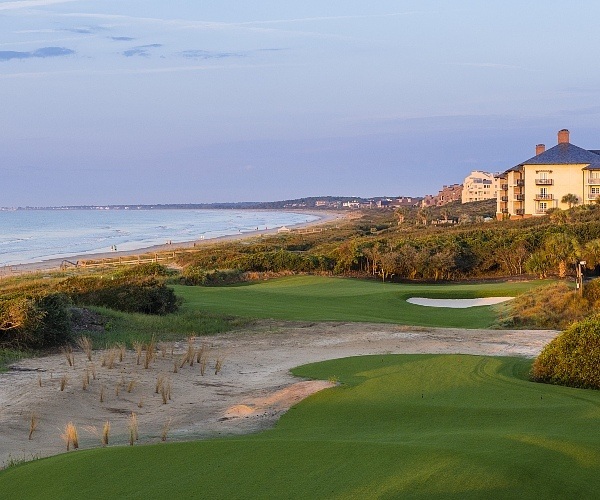
What to Do: For those of us not golfing, there is still plenty to do around the island. Relax and unwind by the pools or on the beach; rent a bicycle to enjoy miles of trails around the island; visit the world-class tennis facilities, get adventurous on a paddleboard or kayak; check out one of the many nature walks and adventures; setup a fishing trip or inquire about the yoga classes and other wellness options. Or just follow my lead and book an afternoon in the expansive Spa at The Sanctuary!
2. Pinehurst Resort, Pinehurst, North Carolina

Meandering through the countryside (and the numerous traffic circles), it becomes very obvious once you arrive to Pinehurst that the residents, staff and many guests shuffling around the property have one thing on their minds – golf. All you golfers will feel right at home while the rest of us seek out what else there is to do among this golfer’s paradise. Pinehurst is a destination that is as timeless as the game itself, and they encourage you to create your own history during your visit. So, let’s make some history then…
Where to Stay: For family gatherings and golf buddy trips, I know that the Carolina Villas are the perfect solution to have plenty of space to come together at the end of a strenuous day of vacationing. The Manor and Holly Inn are both charming options that have been recently renovated and close to everything. Or you can stick with me and opt for the Queen of the South, the Carolina Hotel. Be sure to inquire about the Carolina Suite for my choice at this property, as well as their numerous package offers for golf, dining and more.
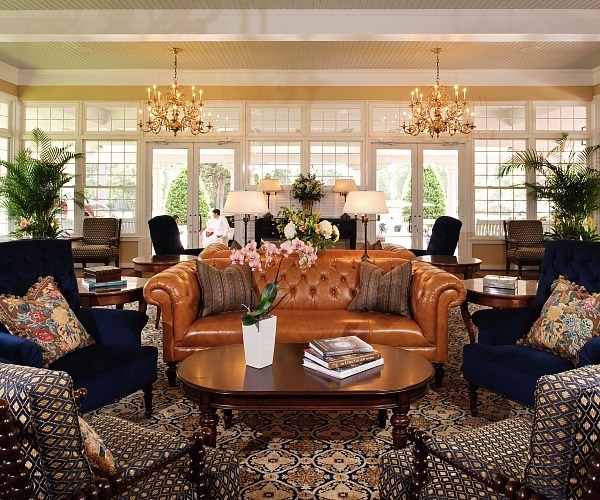
Where to Eat: There is something for everyone’s tastes at the properties and throughout the village. One of the newer options is Pinehurst Brewing Company that serves Southern BBQ and the locals’ favorite craft beers. In addition to other taverns and bars, for quick bites and cocktails, 1895 Grille at Holly Inn serves farm to table cuisine and a chocolate soufflé that will keep you coming back! The Carolina Dining Room has a localized fine dining menu that changes by the season, and it’s definitely worth at least one visit while you’re in town.
Where to Golf: Known as “The Cradle of American Golf,” Pinehurst offers nine courses that are all unique, and sure to challenge golfers of every level. No.1 by Donald Ross began it all in 1898 with this course; and was then followed by Ross with No. 2 in 1907 and No. 3 in 1910. To this day, No. 2 is the most recognized as home to multiple U.S. Opens and other tournaments… and one that must be on your to-play list while at Pinehurst. No. 4 by Gil Hanse arrived in 2018 and impressed everyone with the natural topography. Between 1966 and 1988, Pinehurst added No. 5 by Ellis Maples, No. 6 by George and Tom Fazio, No. 7 by Rees Jones, No. 8 by Tom Fazio, No. 9 by Jack Nicklaus. Finally, in 2017, The Cradle by Gil Hanse was added, a 9-hole short course that everyone is loving. You golfers can play until your heart’s content, but if you need me, I’ll be over mastering my fierce game of putt-putt at Thistle Dhu!

What to Do: There’s always a strong theme at these golf resorts with a love for lots of golf, great places to eat and drink, and then a spa to unwind from too much vacationing. This rings true at Pinehurst with a lovely spa for all the pampering you desire. Looking for a unique local offering? Try their watermelon basil scrub that is infused with organic vodka and includes a light massage with their signature ginger sorbet body milk lotion. Yes, please! Pinehurst is a great place to simply relax and enjoy walks, jogs and bike rides around the resort or simply a walk through the endearing village. They can also shuttle you over to their 200-acre lake for boating, fishing or just reading your book among complete tranquility. Either way, enjoy your stay at Pinehurst, and with so much love for golf here, you might be like me and consider picking up the game for yourself.
3. The Sea Pines Resort, Hilton Head Island, South Carolina
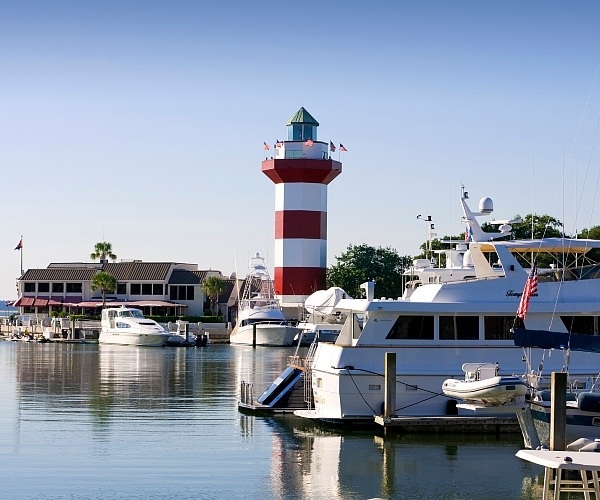
Yet another destination where the staff bends over backwards to cater to you while providing outstanding service with their very own touch of southern charm is the Sea Pines Resort in Hilton Head, South Carolina. The iconic red and white lighthouse towers above the resort, reminding guests of the rich history found here, as well as serving as the landmark of one of the most recognizable marinas in the boating world. There are a ton of activities to keep even me from being bored with miles of beaches, tennis courts, the marina with a number of boating offerings, and a massive 605-acre Forest Preserve. Also, a personal favorite and one that is loved by all equestrian aficionados or novice horse lovers that visit, Lawton Stables has multiple programs for riders of all skill levels.
Where to Stay: The Inn & Club at Harbour Town is essentially the little sister to The Sanctuary Hotel at Kiawah Island Golf Resort. This boutique option still screams opulent luxury with the charms of yesteryear. The common areas and rooms/suites are beautiful, but for the best Sea Pines experience, I suggest the two-bedroom Fairway Suite for lots of space to relax and enjoy the breathtaking views out over the golf course and towering oak trees. The other options on the island are all the homes, villas and condos available for vacation rentals – including some over-the-top luxury homes for larger groups.
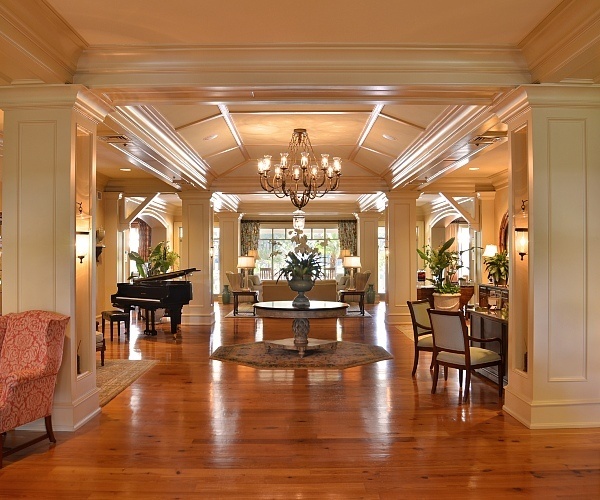
Where to Eat: The Sea Pines Resort loves that they have more than 20 dining options to accommodate all their guests, and I tend to agree that there’s certainly something for everyone. A few suggestions would be Coast Oceanfront Dining for an exceptional level of seafood you would expect here in Hilton Head; Links An American Grill at the Harbour Town Clubhouse with great views of the golf course… and the perfect wine and steak pairings; and Harbour Town Bakery and Café for a great breakfast, but don’t forget to also try their blueberry biscuits!
Where to Golf: At a destination where golf is king, these legendary Hilton Head golf courses are true royalty, so play all three for an unforgettable golf experience. An exciting development for the resort was the reconstruction of the historic Ocean Course to now be an amazing test of golf as Atlantic Dunes by Davis Love III. Heron Point by Pete Dye has been designed to provide every level of golfer a challenge thanks to seven different tee boxes, while also being simply a beautiful experience among the natural environments that make The Sea Pines Resort so special. And then, of course, there is Harbour Town Golf Links that is most widely known as the home of the RBC Heritage Presented by Boeing since 1969. With Pete Dye and Jack Nicklaus both working on this golf course, you know it’s truly spectacular!
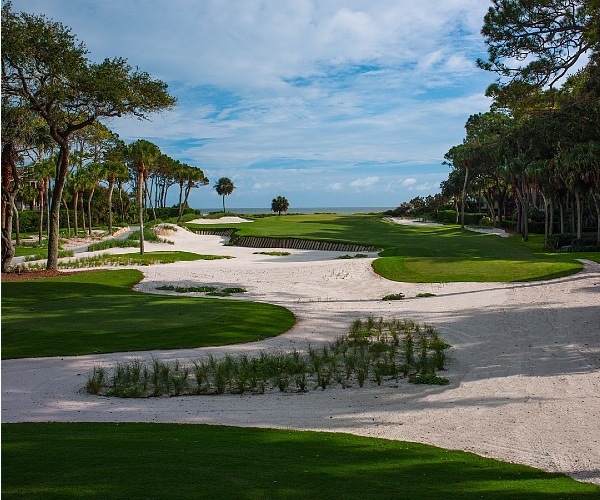
What to Do: You can’t go wrong with time at the beach or a visit to the Spa. There are also 20 miles of paths spread across the resort ideal for a bike ride or jog; or venture out with a kayak or paddleboard for a workout. Fishing, nature walks, and dolphin tours are always other great options, but as I mentioned before, Lawton Stables is what attracts so many of us while at The Sea Pines Resort. Plan a time to visit for the kids to enjoy a pony ride or an adventure at the Animal Farm; and then carve out time to saddle up for a trail ride through their more than 600 acres of the Sea Pines Resort Forest Preserve.
By Eric Hrubant
Vegan friendly luxury hotels and resorts in Cambodia, Thailand and Vietnam

As veganism continues to grow exponentially worldwide, we can now enjoy a vegan luxury travel experience at some of the finest hotels and resorts. When it comes to vegan friendly luxury in Cambodia, Thailand and Vietnam, the following selection including city hotels and an island resort have got you covered. Each of them have either a veggie menu featuring vegan options, or vegan options clearly marked on their menus. Check in and enjoy creative, delicious and nutritious plant-based food at one of these vegan friendly luxury hotels and resorts.
Private island vegan luxury, at Six Senses Krabey Island in Cambodia
Check in at Six Senses Krabey Island and you will be staying on a private island surrounded by the clear blue ocean and amongst the ancient trees that tower above you. This is a tropical paradise island like no other with the eco focus that Six Senses are renowned for and plenty of luxury touches to guarantee a memorable stay. Sumptious spa treatments, memorable experiences and plenty of plant based food will make it tough to leave, that’s for sure!
‘Eat With Six Senses’ is all about eating healthy whislt on vacation and this culinary concept is available at all Six Senses Resorts. At Six Senses Krabey Island we enjoyed vegan versions of local food including ‘Nom banh chok’ which is a noodle dish and a Khmer staple. Rice noodles and vegetables with a creamy coconut soup made with ‘kreung’ curry paste and garnished with fresh herbs and leaves. Chef Mark also prepared a super charged salad for lunch which he prepared right in front of us, packed with goodness and nutrition it was one of the best salads we have ever eaten, a perfect way to demonstrate the ‘Eat With Six Senses’ concept.


Bangkok riverside vegan luxury, at The Peninsula Bangkok in Thailand

The Peninsula Bangkok is elegant and exquisitely stylish, with an enviable riverside location in one of the most exciting cities in the world. What’s not to love about this luxury hotel from one of the world’s leading luxury hotel brands? Enjoy unrivalled views of the Chao Praya River, the true heartbeat of Bangkok, a swim in the 88m pool or a treatment at the two floor spa and wellness centre before dining at one of their celebrated restaurants.
Breakfast at River Cafe & Terrace is a veritable vegan feast, whilst lunch at The Lobby or dinner at Thiptara present diners with a number of plant based menu options, as is the same throughout the hotel. This includes Mei Jiang, regarded as one of the finest Cantonese restaurants in Bangkok where diners can enjoy a refined meal in elegant surrroundings. The tofu flower in our double-boiled soup was crafted using extraordinary ‘dao yi’ (knife skills) and looked exquisite, a picture perfect bowl of Cantonese goodness. The ground breaking ‘future food’, OmniMeat featured with finely chopped vegetables in another dish. Contained within pumpkin and served in a creamy pumpkin sauce, this beautifully presented bowl was vibrant and extremely pleasing on the eye. Dining at Mei Jiang was a memorable journey through Cantonese plant based cuisine that will leave you amazed.


City centre vegan luxury, at Sofitel Legend Metropole Hanoi in Vietnam

This multiple award-winning luxury hotel oozes colonial charm. Sofitel Legend Metropole Hanoi has welcomed esteemed guests including playwrights, actors, film stars, musicians, heads of state and ambassadors since opening in more than 100 years ago. Recognised by many as one of the finest hotels in Southeast Asia and often referred to as one of ‘The Grand Dames’, those that choose to stay here are certainly guests that enjoy the finer things in life. Becoming the first ‘Sofitel Legend’ hotel in 2009 it has since been joined by a unique collection of hotels and palaces around the world.
Our vegan breakfast at Spices Garden consisted of a selection of adapted dishes from the a la carte menu, combined with the vegan friendly options from the extensive buffet. But it was our vegan fine dining experience at Le Beaulieu which truly impressed. The four course set menu was adapted from the existing vegetarian menu with just a few changes being made to ensure that our meal was 100% plant based. The staff team at Le Beaulieu were friendly and helpful, whilst being gracefully efficient and professional, no more than you would expect from a hotel with such high standards. The ingredients for each dish were explained upon service, whilst the dishes were personally finished by Chef, with a twist of pepper or a drizzle of olive oil where required. The stand out dish featured a seasonal mushrooms fricassee, pomme de terre paillasson, polenta, parsley jus and topped with fried garlic, a subtle blend of textures and flavours that was truly memorable. Finishing our meal with a platter of marinated red fruit with mint, orange gel, cacao nibs, a crunchy biscuity mille feuille, mixed berries sauce and mango sorbet was a light and refreshing ending to an excellent meal.


We hope that our trio of vegan friendly luxury options in Cambodia, Thailand and Vietnam give you some (vegan) food for thought whilst helping you plan your next vegan travel adventure to Southeast Asia. Please feel free to reach out for further information about any of the hotels or resorts featured, or indeed to tell us about a luxury hotel or resort in Southast Asia that you think we should add to our bucket list for when the borders open.
By Paul Eyers
Aviation geek misses airline meals so much he make them at home

Self-confessed aviation geek Nik Sennhauser misses air travel so much that he is recreating the inflight meals he once enjoyed to remind him of good times before the pandemic. Before Covid, Nik, who lives in Glasgow, would spend much of his free time looking for flight deals.
He loved the airports and airlines experience so much he thought nothing of flying to the US for a weekend trip.
“I once got a flight from Edinburgh to Boston for £150 return,” he told BBC Radio Scotland’s Our Lives with Michelle McManus.
“I took the Friday off and on the Thursday after work got on a plane and flew there, had some lobster rolls and dipped my feet in the sea – and then got back on a plane.”

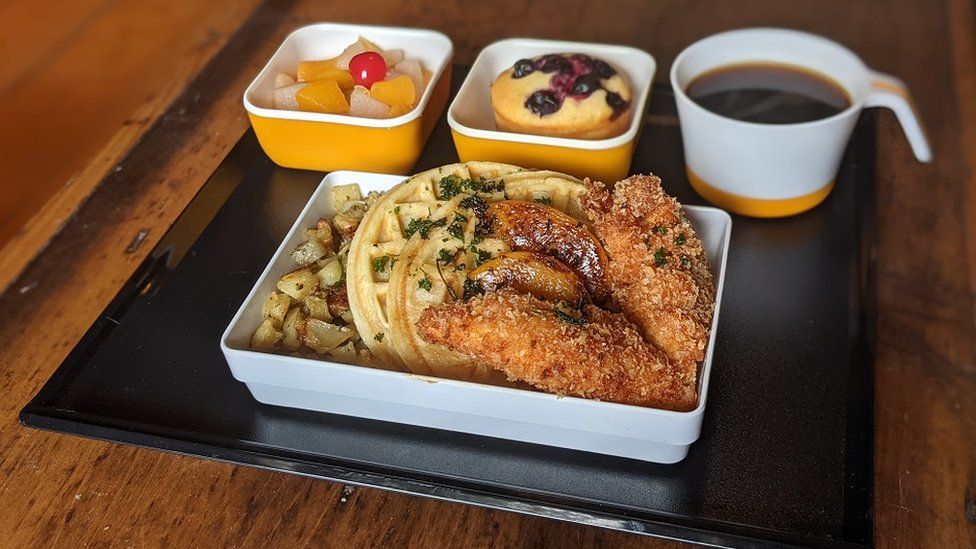
Nik, from Glasgow, said some people were willing to spend the same amount of money going to the pub.
“Aviation was always part of my life before the pandemic,” he added.
One of things he misses the most about international travel are the inflight meals he was served.
“I grew up between Thailand and Austria, so I spent a lot of my childhood on planes and in airports,” said Nik.
“My dad was working in Thailand for a multi-national and we went to school in Austria, so every holiday, even if it was just for a weekend, we would fly to Bangkok to see dad.
“The plane was the one place I would eat food without questioning it. At home my mum had to force me to eat vegetables and other foods.”
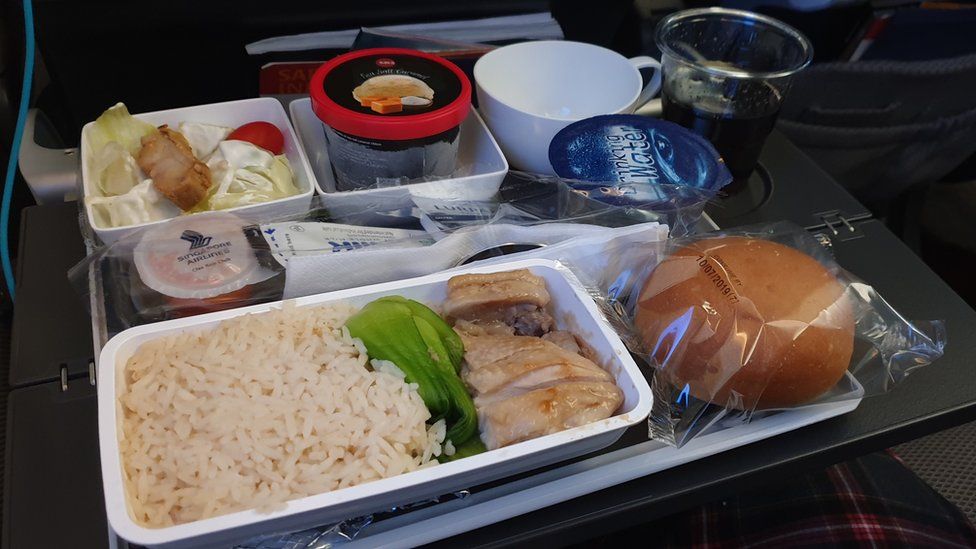

Nik said the flights he took from Thailand back to Europe were always at night.
“It was like a wee performance on the plane.
“It was like entertainment.”

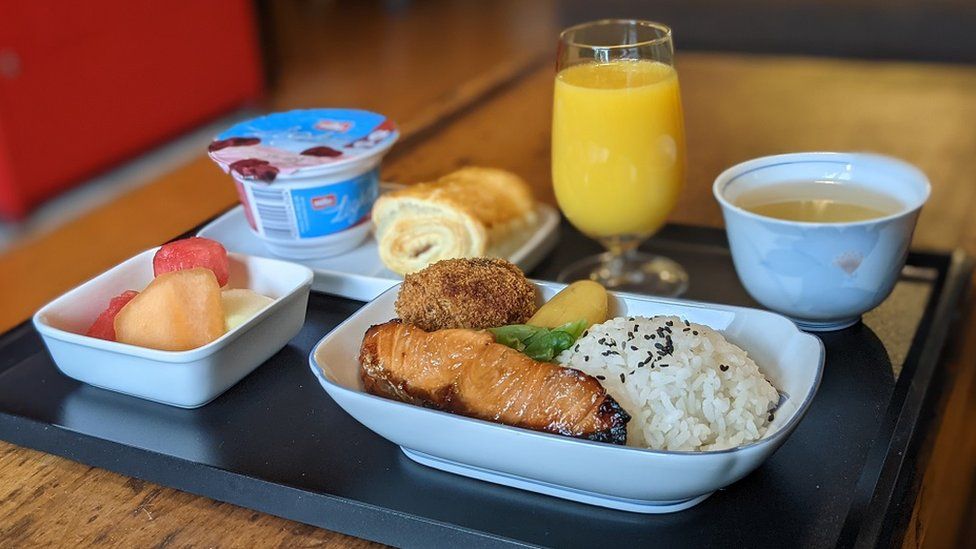
These days the pandemic has drastically reduced Nik’s chances of getting on a plane and tucking into an inflight meal.
“Then one Sunday I was making sausages, eggs and hash browns and thought it looked a bit like a plane meal,” said Nik, a business support manager for a Glasgow-based e-commerce start-up.
It was the spark which gave him the idea to recreate meals he had enjoyed on flights all over the world.

Nik bases his creations on photographs he took of inflight meals served on his travels to and from Europe, Asia and the US.
They include lobster thermidor, meat patty and gnocchi, and fried chicken with waffles, roasted potatoes and grilled peaches.
But Nik admitted he enjoyed the eating far more than the preparation of his meals.
“I don’t like cooking. It’s not my thing,” he said. www.bbc.com
The best beaches of Sicily
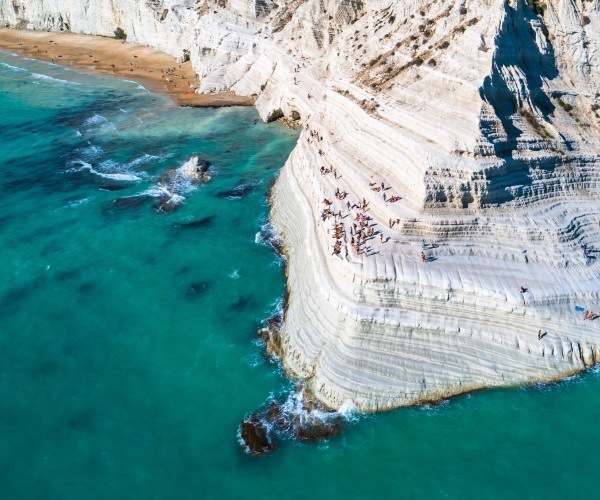
First of all, arm yourself with a hat and sunscreen with an SPF of at least 30! Once protected from the sun, which feels more African than Italian, you will be free to discover fine sand, wild rocks, deserted and hidden coves in the southernmost region of Italy, Sicily, the second-largest island of the country. In this list, you will find beaches where it is possible to experience the most beautiful and pristine seawaters of this wonderful region.
Scala dei Turchi, Agrigento area
Going towards Agrigento, we recommend allowing a visit to the beach known as “Scala dei Turchi”. What makes it so coveted is not the beach itself but the entire surrounding landscape and the unparalleled view “from above”.
Wear appropriate shoes, and venture to this beach so different from the usual. You will discover that the coastline here has been shaped by the seawater in such a way that it now looks like a staircase, more or less walkable. The Stair of the Turks is an artwork of nature, a sparkling white cliff on the marvellous sea of Sicily that makes for a fabulous experience.
Spiaggia dei Conigli, Lampedusa Island
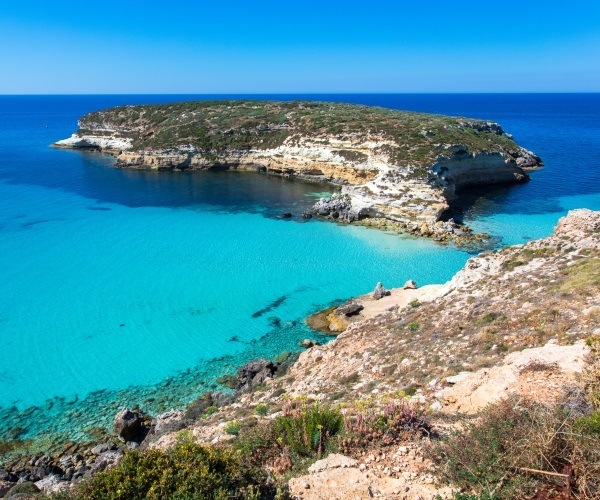
This particular name means “Rabbits beach”; however, it has nothing to do with rabbits. On the contrary, this beach is named after the islet situated right in front of it.
Spiaggia dei Conigli is located along the southern coast of Lampedusa, that wonderful and virtuous island boasting marine sceneries that cannot be found elsewhere.
Nearby, you will find the Isle of Rabbits, considered a protected area to which you can only have access during the day. This unique islet is definitely a corner of the Mediterranean landscape to be jealously guarded, another pearl of southern Italy that should be seen at least once in a lifetime. Rabbits beach is also the favourite spot of the Caretta turtles who return here every year to lay their eggs.
Calamosche Beach, Noto area
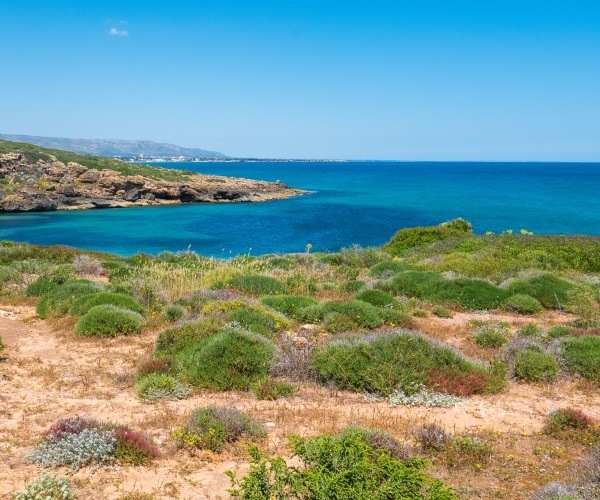
Small sandy beach situated in a protected rocky cove perfect for snorkelling, swimming & sunbathing. The small bay of Calamosche is nestled within the Vendicari Nature Reserve amidst African colours and primitive landscapes. A crystalline sea, a sandy beach and rocky crags framing the sea await you in this enchanted place. In this spot, you will find simple and authentic restaurants where it is possible to indulge in delectable meals under the shadow of large trees. You will enjoy excellent fish dishes and mouthwatering local cuisine, just the perfect stop after a swim at sunset, before returning to your luxury villa in Sicily.
Marianelli Beach, Noto area
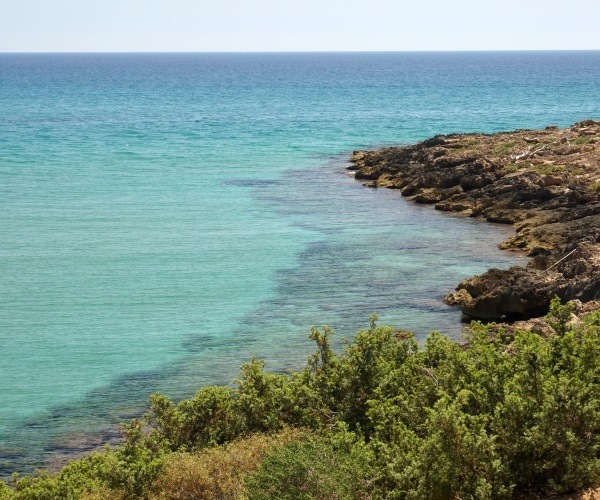
Still within the Vendicari Reserve, this beach is more inconvenient to reach, but you will be rewarded for the beauty of the natural setting, for the quiet, and for its crystal clear water. Situated North of the Reserve, Marianelli beach is recommended for those who prefer nature, vast spaces and only a few people around. It is located thirty-five kilometres from the city of Syracuse and is one of the few beaches left as authentically as it originally was, immersed in a landscape made of fields, almond and lemon groves and, approaching the sea, dune hills with unique flora. Free beach.
San Lorenzo Beach, Noto area
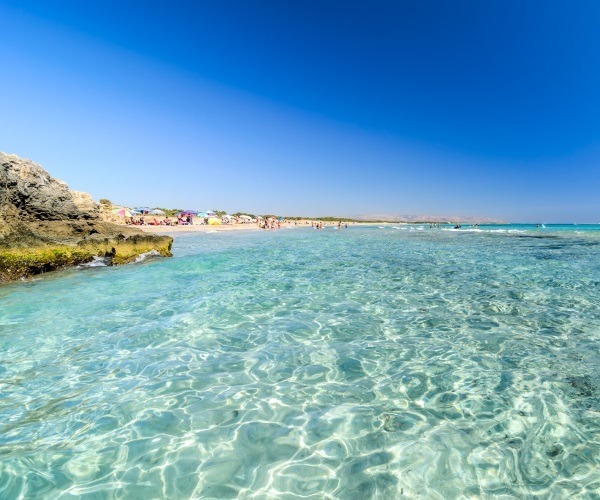
We are still within the Vendicari reserve, which is now worth a proper introduction. Vendicari Nature Reserve is a wildlife oasis located between Noto and Pachino, whose territory extends to about 1500 hectares. Inside the reserve, an entire ecosystem lives undisturbed. During your visit, you will find yourself marvelling at breathtaking landscapes, dense vegetation suddenly opening up to a crystalline sea, and extremely long golden beaches, which, at times become rocks overlooking the deep blue sea. From the observation huts, you have the chance to admire flamingos, herons, storks that stop here before reaching their final migratory destinations. San Lorenzo beach is equipped and therefore more suitable for families with children, hence you can bid farewell to absolute silence!
Favignana Island, Cala Rossa
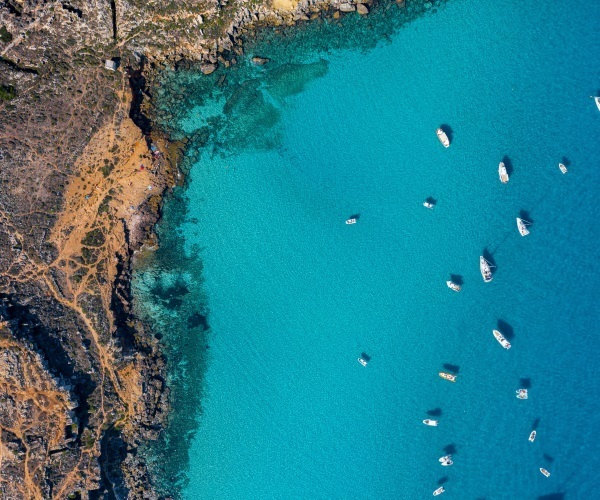
In order to reach the most famous beach on the island of Favignana, it is necessary to follow a path on foot and get to old tuff caves that surround the turquoise waters of Cala Rossa. Do not miss the opportunity to rent a boat at the port of the island to marvel at this awesome nature sight that will strike even more from this point of view. Alternatively, let a skipper take you between the coves to explore all the inlets that form the two splendid butterfly wings in the heart of the Mediterranean.
Isola Bella Beach, Taormina
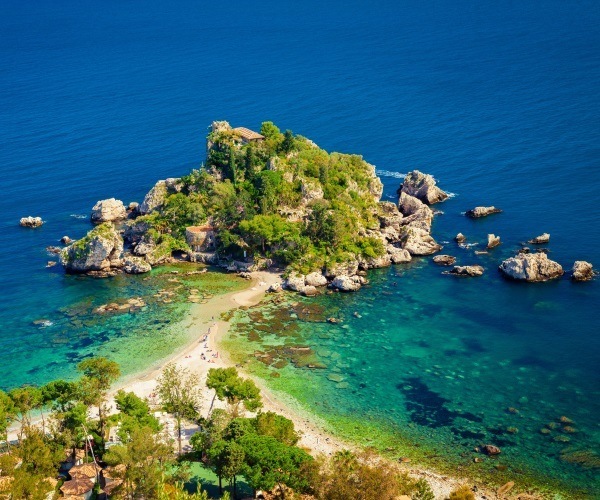
Isola Bella beach is located not far from Taormina, a town on the east coast of Sicily famous for its Greek Theater dominating the coast and creating a unique and exceptional stage for concerts of great international artists. At the foot of this beguiling town lies Isola Bella, a pebble and gravel beach offering excellent beach resorts situated on the narrow strip of land. The seabed here is adored by snorkelers.
Among fish and underwater plants, also a sign of pristine and swimming water, you will feast your eyes on something you don’t get to see every day: an extra experience to add to the exploration of Sicily. The islet that is part of it can be reached on foot with rock shoes, while the eastern side of the beach where the blue of the sea gets even brighter, can be reached via a boat trip.
Lago di Venere Beach, Pantelleria
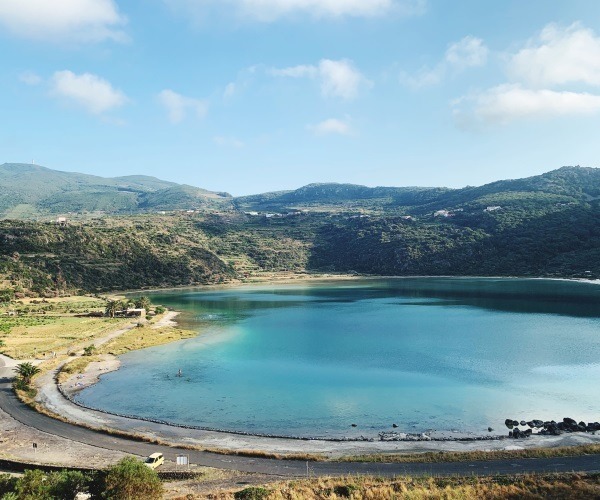
Named the “Black Pearl of the Mediterranean”, this island has a unique charm. Pantelleria is the most difficult island to get to in Sicily, rocky and black. It is located thirty-five nautical miles from Africa, and sixty from Sicily. It is the largest of the Sicilian islands and also hosts an active volcano. Its volcanic origin has formed a repelling and sharp coast, with spiky and jagged rocks. Yet the hinterland hides a surprising beach bordering the lake, where you will find warm salty water almost all year round. Here it is possible to experience volcanic mud and natural thermal waters body treatments. The thermal waters flow spontaneously on the shore. A natural spa, yet another gift that nature wanted to give to this splendid Italian region.
By Daniela De Luca
Celtic Cornwall is UK’s forgotten ‘fifth nation’
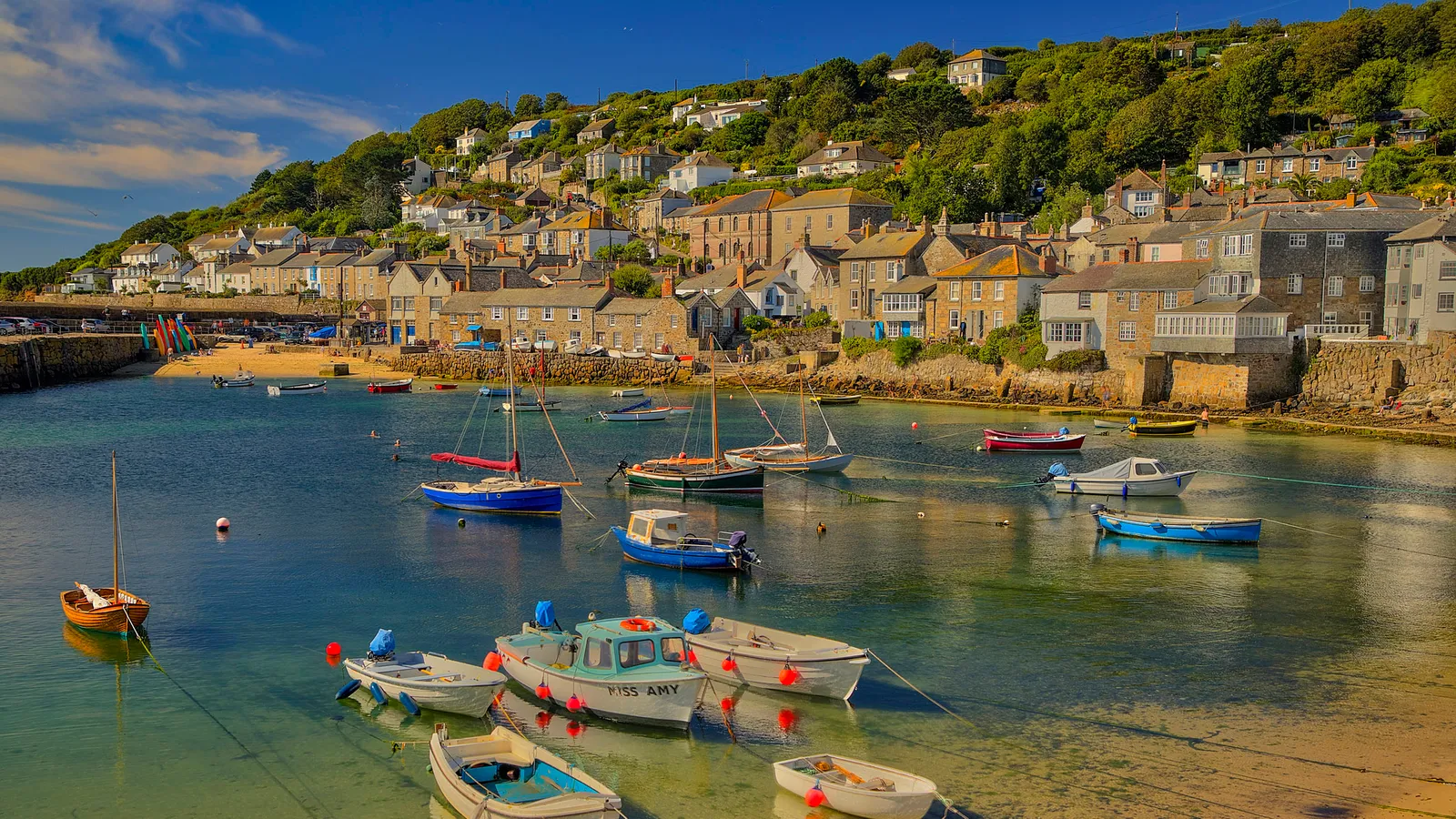
“I’m glad I live on the west side of the River Tamar,” said Rob Tremain emphatically as we discussed Cornish history and politics in the shadow of Launceston Castle. “Driving back home over the Tamar, my dad would always wind down the windows and say: ‘We can breathe again; we’re in Cornwall!’.”
The River Tamar, which forms one of the most ancient borders in Europe, is central to Cornish history and identity, marking a 1,000-year-old divide between Celtic Kernow (Cornwall) and Anglo-Saxon England. Ever since Athelstan, an Anglo-Saxon king, pushed the last native Britons over the Tamar in 936 AD, distinct identities have formed to the east and the west.
Starting as a seemingly insignificant trickle in a muddy field a few miles from the Bristol Channel, the river widens into a daunting natural barrier on its meandering journey 61 miles south to Plymouth Sound. Bounded on all other sides by ocean, I could see how Cornwall’s island-like geography has shaped the peninsula’s history as I plotted my journey into this Celtic borderland to research the often-overlooked story of Cornish culture, history and identity.
Located near the Devon border, the Cornish town of Launceston sits in the midst of this once-bloody borderland and is the first Cornish town that travellers reach when driving along the A30 from Devon. Crossing the river at Polson Bridge – the historical gateway into Cornwall – the green, black and white flag of Devon changed to the black and white of Cornwall as a road sign welcomed me, in both English and Cornish, to Kernow.
Tremain has been Launceston’s town crier for 43 years. Wearing a Cornish tartan face mask and carrying a tote bag emblazoned with Cornwall’s flag, he explained how centuries of failed rebellions and bloody excursions over the Tamar ultimately suppressed the Cornish language and culture – until the recent Celtic revivalist movement looking to stake Kernow’s claim as the UK’s forgotten fifth nation – but the border has always been a constant fixture.
“This isn’t England, you see,” Tremain said dramatically as we walked under a medieval stone archway into the courtyard of Launceston’s castle. “We’re proud to be British, but we’re not English. We’re Cornish.”
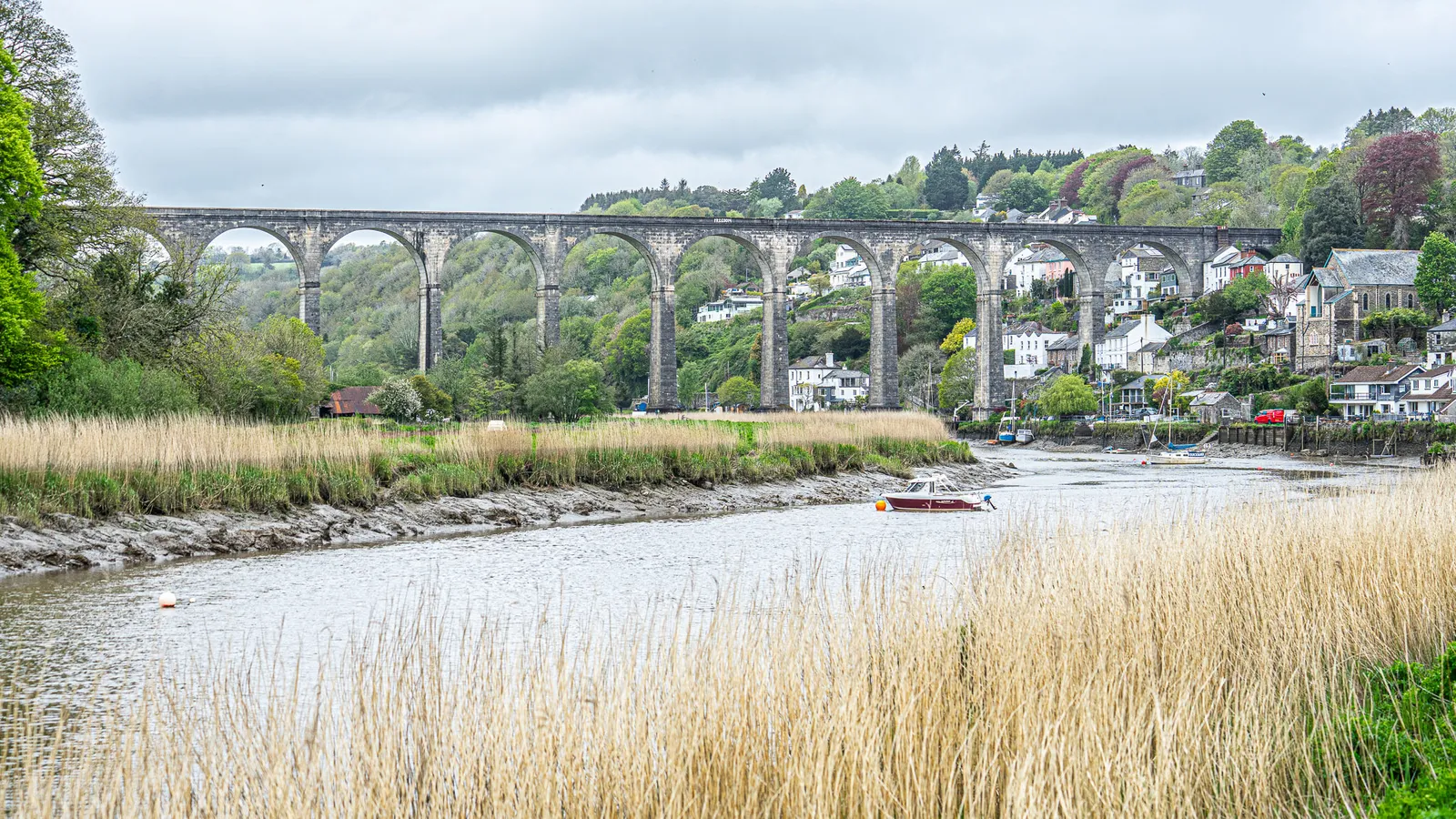
As he guided me through Cornwall’s old county capital, Tremain explained that while the rest of the UK often sees Cornwall as “just another English county”, Cornwall is technically a Duchy. Alongside the Cornish language, it’s a curious historical quirk that’s used to promote the idea of a Cornish “nation” that’s distinct from England.
Duchies were semi-independent medieval fiefdoms ruled over by dukes and duchesses rather than directly subject to the laws and taxes of English kings and queens. Historically, the Duke of Cornwall collected tithes and royalties from Cornish subjects at Polson Bridge, a tradition dating back to 1337 when the Duchy of Cornwall was first established.
To this day, the Duchy and the vast Cornish estates and revenues that go with it are automatically conferred upon the eldest son of the reigning monarch. Prince Charles, the current Duke of Cornwall, was invested with the title in 1973 at Launceston Castle, and Tremain explained that the peculiar feudal dues he was presented with during the ceremony included: “A grey riding coat, an ashwood bow, a big bundle of firewood and a pint of cumin.”
Leaving Launceston, I crossed back east into Devon before heading south. The Tamar is a formidable barrier, but history on either side of the river isn’t as black and white as the Cornish flag. During the medieval period, the entire south-west region was a land simmering with discontent against distant monarchs; quite often, the Cornish would find comrades-in-arms amongst the equally disgruntled Devonians.
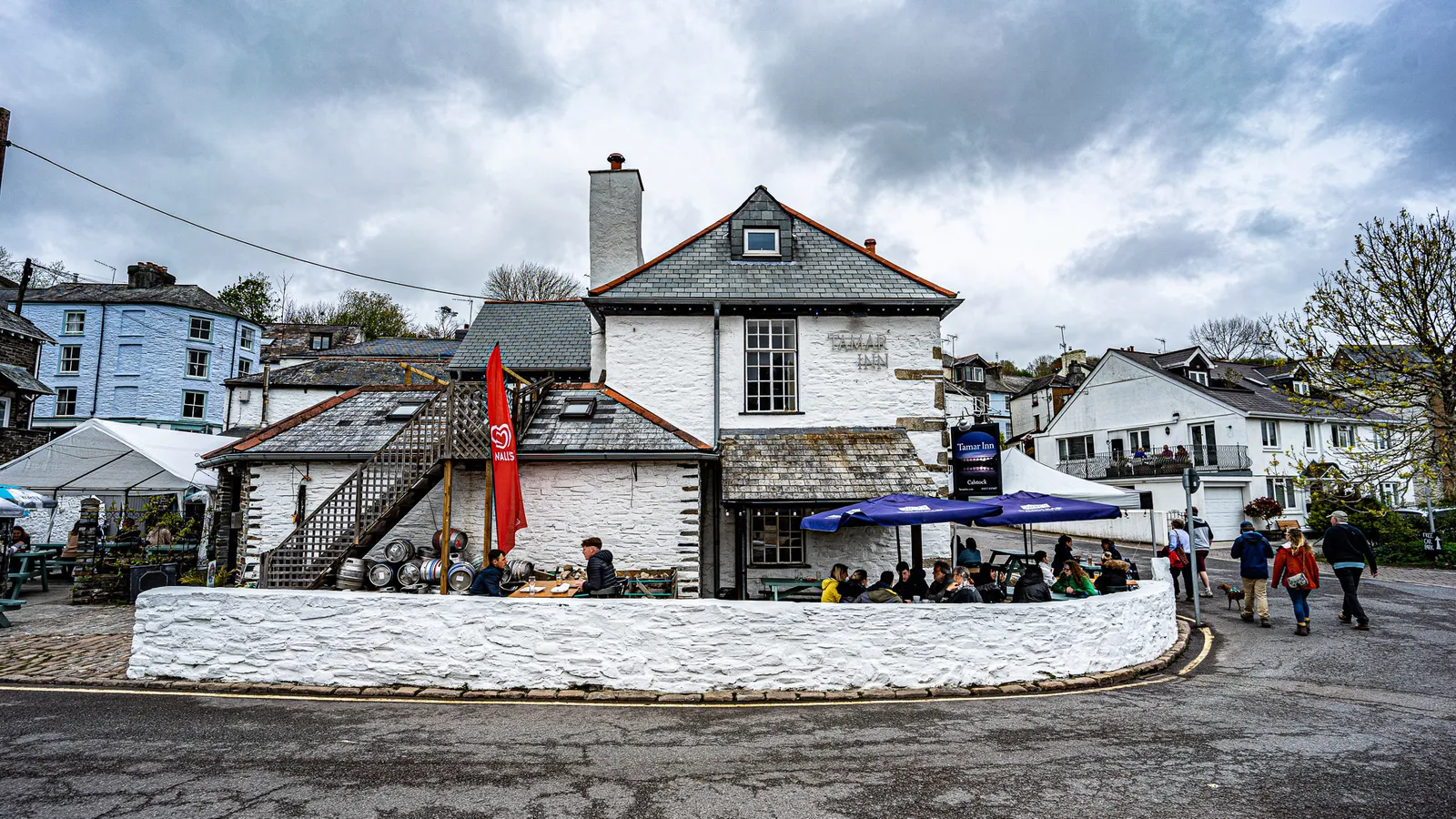
Although the Cornish (and sometimes the Devonians) rebelled many times, the Prayer Book Rebellion was a turning point for Cornwall’s national identity. Until the 16th Century, travellers crossing the Tamar from Devon would have heard much more Cornish spoken than English. But defeat in the Prayer Book Rebellion sounded the death knell for Cornwall’s ancient Celtic language. The Cornish language withered away as English was enforced in churches, and there would be a wait of almost four centuries before the Cornish would see its modern resurgence,
The winding country roads of Cornwall’s borderland took me backwards and forwards over the Tamar until I reached Gunnislake – or Dowrgonna, as the welcome sign announced in Cornish – where I left my car at the station and walked down to the river to join the Tamar Discovery Trail, a 35-mile long hiking route that runs the length of the River Tamar through the Tamar Valley Area of Outstanding Natural Beauty (AONB) and offers hikers the chance to explore Britain’s forgotten borderland.
The Cornish and Devonians may have joined forces when it suited them, but as Charlotte Dancer, information and communications officer for the cross-border Tamar Valley AONB, explained, the mighty Tamar continues to both unite and divide those on either bank.
“One of the major differences between the two sides is how we eat our scones,” she said lightheartedly. “At one of our AONB conferences, we had plates of scones that had cream on first, then jam – for the Devon residents – and other plates of scones that had jam first then cream for the Cornish residents.”
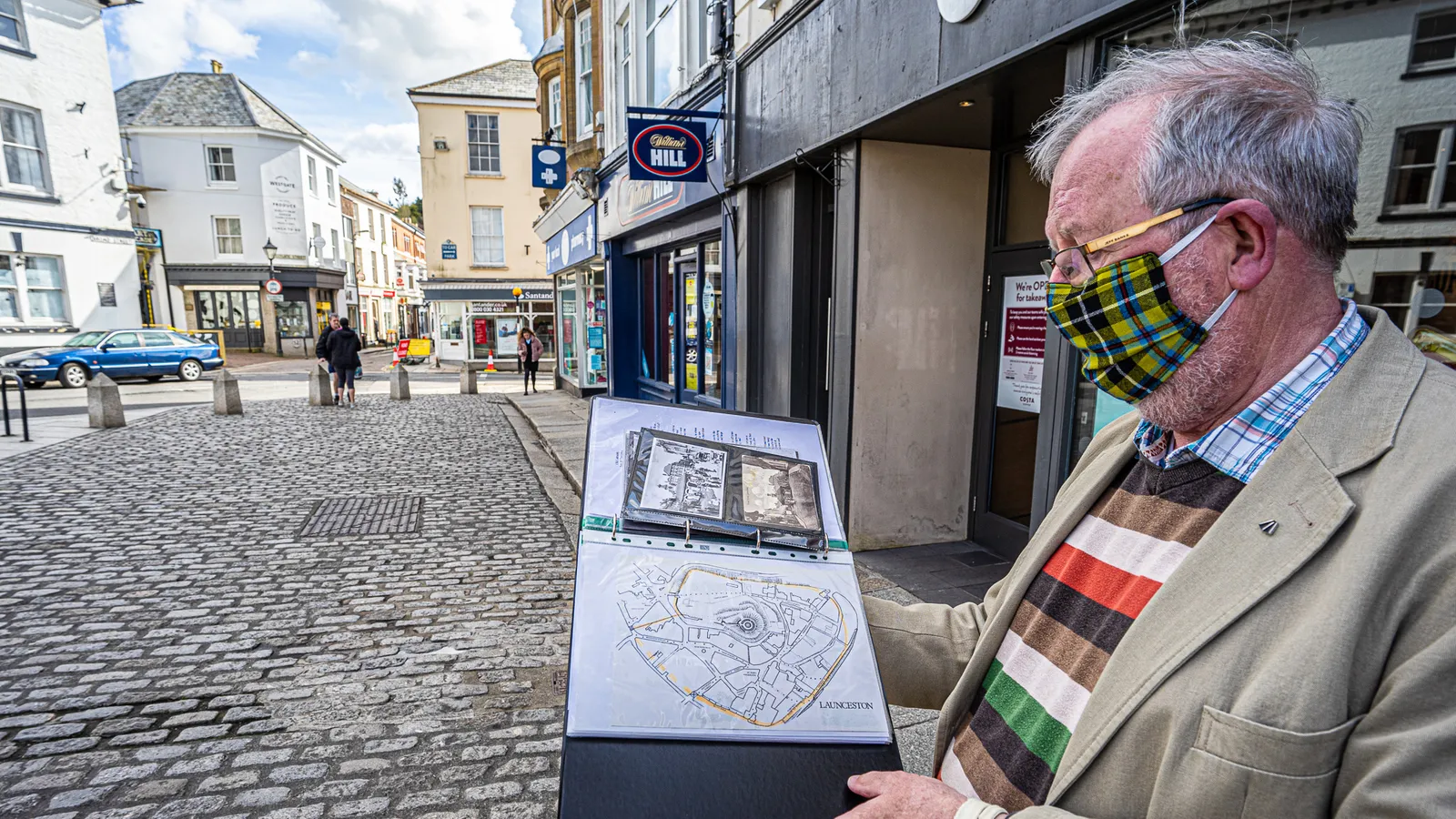
Culinary differences aren’t the only cultural identifiers marking the Cornish from the English (although don’t forget Cornish pasties, of course). Differences in history and culture can be observed in place names and language, sites of Cornish rebellion and even the layout of villages (Anglo Saxon villages always had a village green, while Cornish villages rarely had them). Karin Easton, president of the Federation of Old Cornwall Societies (Kernow Goth, in Cornish), explained how Cornish culture today encompasses everything from “Cornish pub singing, with altos and sopranos”, to Celtic-inspired Cornish dancing, Cornish brass bands and the “national” sports of Cornish hurling and Cornish wrestling.
I hiked a tough five miles over undulating terrain along the Tamar Discovery Trail until I reached the Cornish village of Calstock, where an impressive 120ft viaduct spans the river. The trail continues on the other side of the Tamar into Devon, but, because the only way to cross the river here is by train (and the next departure wasn’t for another two hours), I decided to settle in for a pint of Doombar Ale at the Tamar Inn.
Calstock viaduct is the last crossing for 20 miles until the river reaches the Tamar Bridge outside Plymouth, before emptying into Plymouth Sound. It was railways, viaducts and bridges like these that opened an isolated Cornwall up to the rest of Britain from the mid-19th Century onwards, bringing mass tourism with them over the Tamar.
Easton explained how, in many ways, it was tourism that helped save Cornwall’s identity when Celtic-ness had all but disappeared after centuries of cultural suppression and Cornish emigration. “From the 1840s onwards, so many Cornish men had to go abroad to find work,” said Easton. “There was a strong feeling to grasp Cornish culture before it disappeared entirely, and this became linked to the idea of promoting tourism to Cornwall, particularly in coastal towns.”
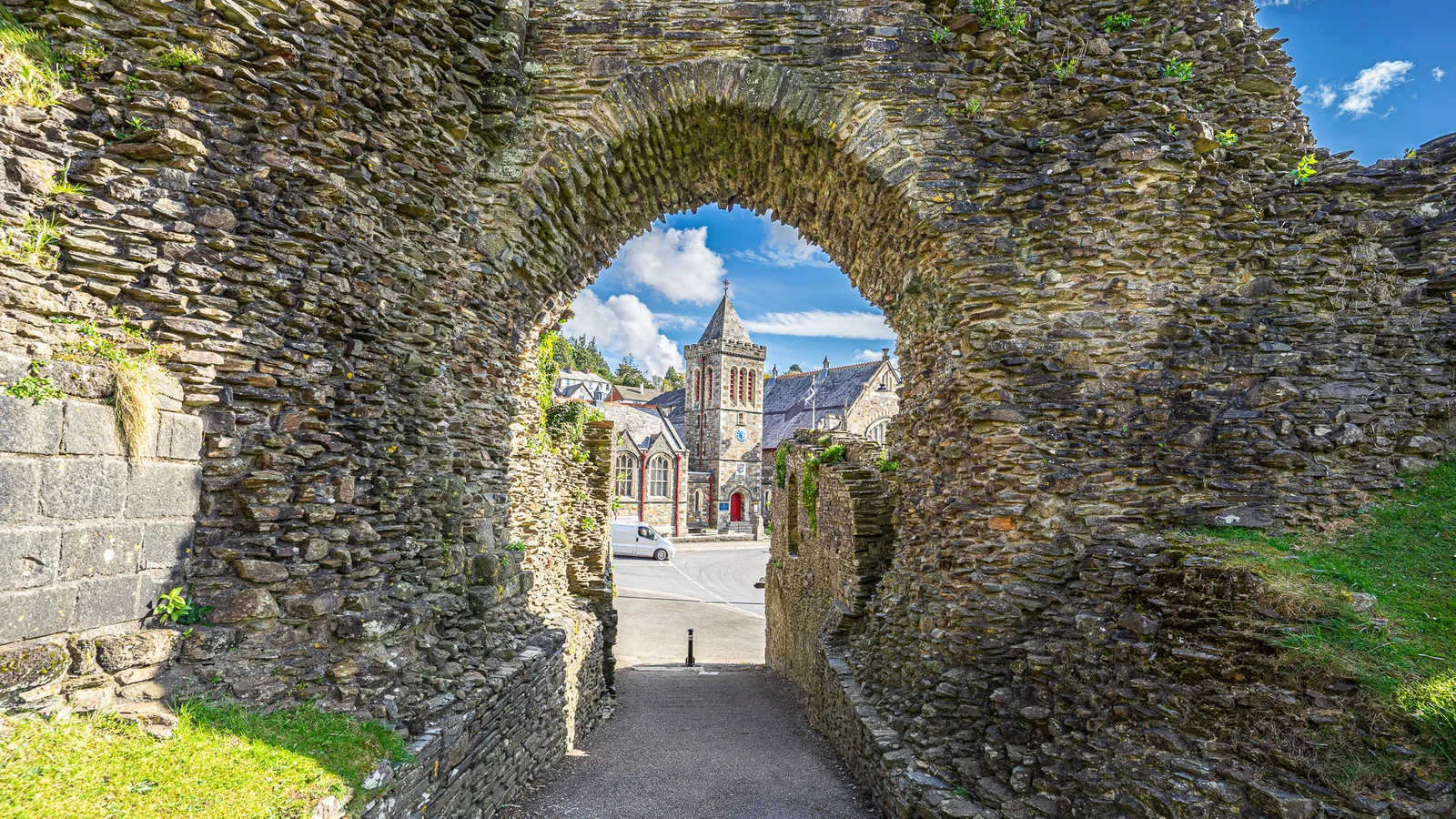
Marketed to incoming British tourists as “the wild land to the west” and the mythical home of King Arthur, a Cornish revival picked up speed as interest in Cornwall’s Celtic past – a past distinct from Anglo-Saxon history – swept through the region from the mid-19th Century. The black and white flag of St Piran, Cornwall’s patron saint, was adopted as a “national” symbol, while the Cornish language was resurrected from the dead, pieced together from fragments of old Cornish texts and dialect, and with a little help from the closely related living languages of Breton and Welsh.
“The language is still evolving today,” said Easton. “A few people are even brought up bilingually. Not many, but it’s growing. There are Cornish street signs; the park-and-ride bus has announcements in Cornish; schools teach it; and you can learn it online. It’s all around, much more than it ever used to be.”
Easton also explained how tourism has created some of the biggest modern divides between Cornwall and England. The tourism industry is reliant on local workers but Easton continually sees those same Cornish locals priced out of the housing market by holiday-home buyers who live east of the Tamar. The economic difficulties faced by many Cornish in their ancient homeland has fuelled the Cornish revival, which as Easton told me, has led to the election of a number of Cornish councillors representing Mebyon Kernow (the Sons of Kernow), a political group campaigning for a devolved Cornwall with its own parliament – much like Wales, Scotland and Northern Ireland have.
“It’s hard for people who come down here to understand the strength of feeling that people have about Cornwall,” Easton told me. “Some never get it, but those that do, well, they start to identify strongly as Cornish themselves.”
By Richard Collett www.bbc.com
Kampong Lorong Buangkok is Singapore’s last surviving village

Away from its soaring skyscrapers and urban sprawl, one rural oasis shows how Singapore used to look.
If you turn off the busy Yio Chu Kang road in north-eastern Singapore and follow a long, earthen path that winds and snakes for about 300m, you will find something of a time capsule. Nestled here, on three acres of verdant land, is Kampong Lorong Buangkok, Singapore’s last surviving village, where remnants of the 1960s are alive and well. Little resembles modern-day Singapore’s panorama of slick skyscrapers. Instead, the cluster of squat bungalows looks like a vintage postcard of the city’s yesteryear.
The kampong – which means “village” in Malay – is a rural oasis in a city-state synonymous with urban sprawl. Roughly 25 archetypal wooden, single-storey dwellings with tin roofs are spread around a surau (small mosque). Forgotten flora that once covered Singapore before all the concrete – like the ketapang, a native coastal tree – grow freely. Nearby, power cables hang overhead, a rare sight since most have gone underground in the rest of the city. Elderly residents sit out on their verandas; chickens in their coops cluck endlessly away; and the chorus of chirping crickets and crowing roosters – the sounds of a bygone era – drown out the city’s noise pollution and provide a soothing, bucolic soundtrack.
A young nation with international aspirations, Singapore rapidly urbanised in the 1980s and quickly transitioned from an agricultural to industrial economy. Overcrowded shophouses were replaced with high-rise flats and sprawling skyscrapers, ushering in the so-called “era of expressways” that saw small roads replaced with multi-lane highways across the city-state. With land at a premium on the island, the rural kampongs had to give way.
And so hundreds of traditional villages were bulldozed, the native flora stripped, earthen paths levelled and livelihoods razed to the ground as part of a government-wide resettlement programme. Village residents – some reluctant to give up their valuable real estate; others eager to swap countryside living for flushing toilets and running water – were herded into government-built subsidised flats erected atop their old homes. Today, more than 80% of Singaporeans live in these structures.

With the rural villages’ demolition also went the famed “kampong spirit”, a term used by Singaporeans to describe the culture of camaraderie, trust and generosity that existed within them. In kampongs, residents didn’t need to lock their doors and families welcomed neighbours, who often stopped by unannounced to borrow whatever they needed. It’s a way of life that the government has tried to recreate in its apartment blocks by increasing the number of shared communal spaces to encourage social interaction.
In 2017, Singapore’s Housing & Development Board partnered with the Singapore University of Technology and Design to develop a framework for urban kampongs, a high-tech approach that uses motion sensors and shared Wi-Fi spaces to encourage camaraderie among neighbours. Lawrence Wong, the then-minister for national development said one of the goals was to “strengthen the kampong spirit in our high-rise apartments”. But communal living isn’t the only ingredient to foster this friendly spirit; the environment matters, too.
You may also be interested in:
• Singapore’s endless pursuit of cleanliness
• The three values that shaped Singapore
• The 96-year-old painter who saved a village
One reason Lorong Buangkok has managed to escape the fate that befell other kampongs is because the surrounding area wasn’t as desirable for commercial, industrial and residential development as elsewhere in Singapore – though that has slowly changed. Once surrounded by a forest clearing and farms, it is now flanked by an enclave of private gated housing and a cluster of flats that overlooks the low-rise settlement.
Another reason became obvious once I met the village’s landlady: a headstrong woman with a resolute commitment to preserve Singapore’s sole surviving kampong.

Approaching 70, Sng Mui Hong, has lived nearly her whole life in the village. She is the youngest of four siblings, and only one who has stayed here. Her late father, a traditional Chinese medicine seller, purchased the land in 1956, the same year the village was created and nine years before Singapore gained independence.
According to local guide Kyanta Yap, who leads tours through the kampong, the majority of the plots were leased out to workers from the nearby hospital and rubber plantation – many of whose descendants still reside here. Back then, monthly rent for each house was between S$4.50 and S$30 (£2.40-16.20). Today, Sng still charges Lorong Buangkok’s 25 families more or less the same rate. By contrast, renting a room that’s roughly one-tenth the size of a kampong house in an adjacent government-built block might cost about 20 times that amount. And the houses across the dividing canal can sell for upward of a few million Singaporean dollars.
While the village has arguably the most affordable housing in Singapore, no new occupants have moved in since the 1990s, and there’s a slim chance there will be any in the near future. As Yap told me, residency is conditional: someone generally has to move out or pass away for a home to open up, and then only those with a connection to either past and present tenants or Sng’s family are considered.
Since Singapore emerged from lockdown last June, Yap has noticed an increasing interest in Lorong Buangkok and his weekend tours now quickly fill to capacity.

“It’s not that surprising since no-one can travel, and this is a unique local tourist spot,” he said. “There are also many who visit on their own; the general public, bikers, joggers and even groups organised on Meetup.” Yap said most come to take a serene walk through the kampong, snapping photos of a rare green oasis tucked away in one of the world’s most-densely populated and urbanised countries.
Yap added that the secluded, tight-knit community of 25 households who live in the kampong have now grown used to the steady stream of curious passersby.
Though Lorong Buangkok may represent an intriguing time capsule for many Singaporeans, it represents something much more for Sng. She recalled following her father around as a child while he tended to this land. It was from him that she picked up the knowledge of traditional Chinese medicine that she now shares with her neighbours. Leaves from the village’s henna plants, for example, can be used to soothe open wounds and burns, and they are also believed to protect against intestinal ulcers when ingested.
Sng knows she’s sitting on hot property. In a country so starved of space, there has been no shortage of developers hoping to purchase the village. But no offer will ever be attractive enough for her to retract a promise she made to her dying father – to preserve Lorong Buangkok. She reiterated a stance she’s defended for decades, and one her siblings, who frequently come back to visit, fiercely share: for as long as she can help it, this land is not up for sale.

In 2014, there was a proposal to raze the village and replace it with a highway, two schools and a public park. Though the government may still consider the plan, the Minister for National Development, Desmond Lee, has also stated that there is “no intention to implement these developments in the near future”.
Many Singaporeans have voiced their objections to the proposed plan. Others have even pushed for the village to be included as a Unesco World Heritage site. But while kampongs were once widely regarded as “deplorable” by the Singapore government, there’s now a newfound appreciation by officials for these rural relics and the culture they foster.
“Lorong Buangkok could be retained as part of the schools for outdoor learning activities for example, or integrated into future parks or playgrounds,” explained Dr Intan Mokhtar, a former politician and current assistant professor in policy and leadership at Singapore Institute of Technology. “Most [residents] have lived there for more than half of their lives, and they treat one another as family.”

At the very least, Singaporeans have the government’s word that it will approach the matter thoughtfully. “When the time comes for us to finalise our plans for the entire area, the government should work closely with relevant stakeholders to ensure developments are carried out in a holistic and coherent way,” Lee has said. “This must involve deep engagement with the kampong families living there at that time, to understand and consider their needs and interests.”
One of the kampong’s residents, Nassim, told me that, “It’s good the government now sees the importance of our kampong.”
“You need to leave something behind that reminds our young of how this country came about. We came from these humble huts.” Nassim added that it’s also a good thing that Sng, once much more reclusive, now welcomes the public to her land. “It helps them understand us and understand why Lorong Buangkok needs to be preserved.”
In Singapore, where land is a precious commodity, there will always be tension between keeping the old and developing the new. While the future of Lorong Buangkok remains uncertain, saving it means safekeeping a glimpse of the nation’s roots, culture and heritage for future generations – something that’s necessary even for a country as young as Singapore.
By Samantha HuiQi Yow www.bbc.com

